Agricultural and food marketing management
VerifiedAdded on 2020/12/23
|39
|10886
|119
AI Summary
Contribute Materials
Your contribution can guide someone’s learning journey. Share your
documents today.
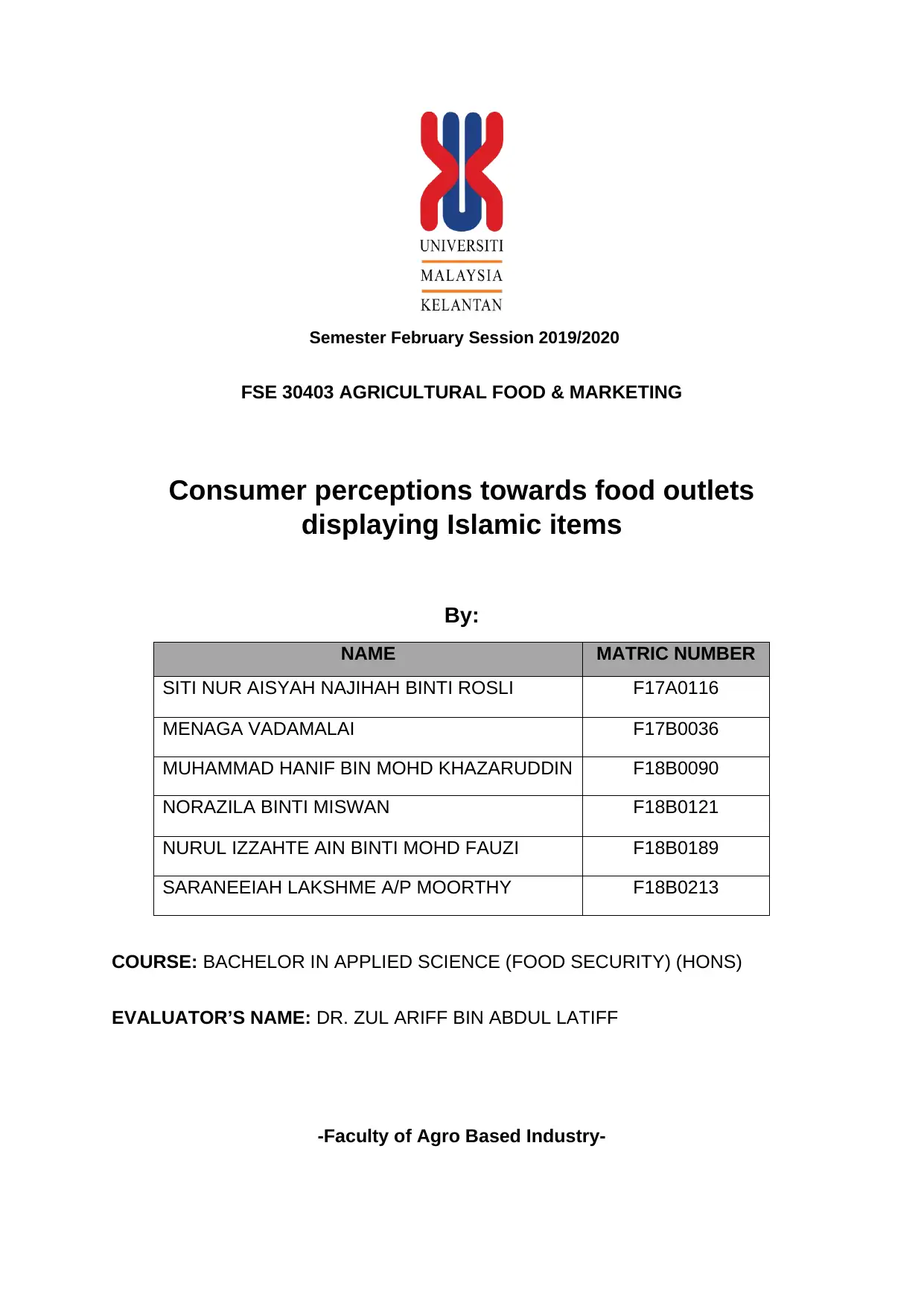
Semester February Session 2019/2020
FSE 30403 AGRICULTURAL FOOD & MARKETING
Consumer perceptions towards food outlets
displaying Islamic items
By:
NAME MATRIC NUMBER
SITI NUR AISYAH NAJIHAH BINTI ROSLI F17A0116
MENAGA VADAMALAI F17B0036
MUHAMMAD HANIF BIN MOHD KHAZARUDDIN F18B0090
NORAZILA BINTI MISWAN F18B0121
NURUL IZZAHTE AIN BINTI MOHD FAUZI F18B0189
SARANEEIAH LAKSHME A/P MOORTHY F18B0213
COURSE: BACHELOR IN APPLIED SCIENCE (FOOD SECURITY) (HONS)
EVALUATOR’S NAME: DR. ZUL ARIFF BIN ABDUL LATIFF
-Faculty of Agro Based Industry-
FSE 30403 AGRICULTURAL FOOD & MARKETING
Consumer perceptions towards food outlets
displaying Islamic items
By:
NAME MATRIC NUMBER
SITI NUR AISYAH NAJIHAH BINTI ROSLI F17A0116
MENAGA VADAMALAI F17B0036
MUHAMMAD HANIF BIN MOHD KHAZARUDDIN F18B0090
NORAZILA BINTI MISWAN F18B0121
NURUL IZZAHTE AIN BINTI MOHD FAUZI F18B0189
SARANEEIAH LAKSHME A/P MOORTHY F18B0213
COURSE: BACHELOR IN APPLIED SCIENCE (FOOD SECURITY) (HONS)
EVALUATOR’S NAME: DR. ZUL ARIFF BIN ABDUL LATIFF
-Faculty of Agro Based Industry-
Secure Best Marks with AI Grader
Need help grading? Try our AI Grader for instant feedback on your assignments.

Consumer perceptions towards food outlets displaying Islamic items in
Malaysia
ABSTRACT
The choice of halal food and Islamic image is an important aspect to consider in life
every Muslim user. Therefore, a good understanding of the electoral aspect Halal
food is required to ensure Muslims take their food products Shariah-compliant. This
study was conducted to identify perceptions and determinants consumers in the
choice of food outlets that displaying Islamic items. Respondents were selected
among the people in Malaysia because here is the largest and most influential group
in deciding daily halal food selection. Data were collected via WhatsApp due to MCO
using the completed questionnaire form was developed based on two theoretical
models used in this study which are the model of knowledge, attitude and perception
(KAP), and the theory of planned behavior (TPB). The key is understanding,
knowledge, attitude and perception toward food outlets displaying Islamic items.
Found four sub-constructs are considered through the deciding factors of halal food
selection at any food outlets, namely the halal logo, ownership, materials and brand.
The results show three sub-constructs has a significant relationship with food
selection. Ownership factor is not contributing significantly to the choice of halal food
at the food outlets. The learning recommends that to upturn positive opinion of
consumers toward food outlets that displaying Islamic item, significant bodies and
media should amplify the promotion and publicity of halal certification by JAKIM to
raise awareness among the people in Malaysia.
Keywords: halal logo; KAP; TPB; ownership; brand; consumers’ attitude.
ii
Malaysia
ABSTRACT
The choice of halal food and Islamic image is an important aspect to consider in life
every Muslim user. Therefore, a good understanding of the electoral aspect Halal
food is required to ensure Muslims take their food products Shariah-compliant. This
study was conducted to identify perceptions and determinants consumers in the
choice of food outlets that displaying Islamic items. Respondents were selected
among the people in Malaysia because here is the largest and most influential group
in deciding daily halal food selection. Data were collected via WhatsApp due to MCO
using the completed questionnaire form was developed based on two theoretical
models used in this study which are the model of knowledge, attitude and perception
(KAP), and the theory of planned behavior (TPB). The key is understanding,
knowledge, attitude and perception toward food outlets displaying Islamic items.
Found four sub-constructs are considered through the deciding factors of halal food
selection at any food outlets, namely the halal logo, ownership, materials and brand.
The results show three sub-constructs has a significant relationship with food
selection. Ownership factor is not contributing significantly to the choice of halal food
at the food outlets. The learning recommends that to upturn positive opinion of
consumers toward food outlets that displaying Islamic item, significant bodies and
media should amplify the promotion and publicity of halal certification by JAKIM to
raise awareness among the people in Malaysia.
Keywords: halal logo; KAP; TPB; ownership; brand; consumers’ attitude.
ii
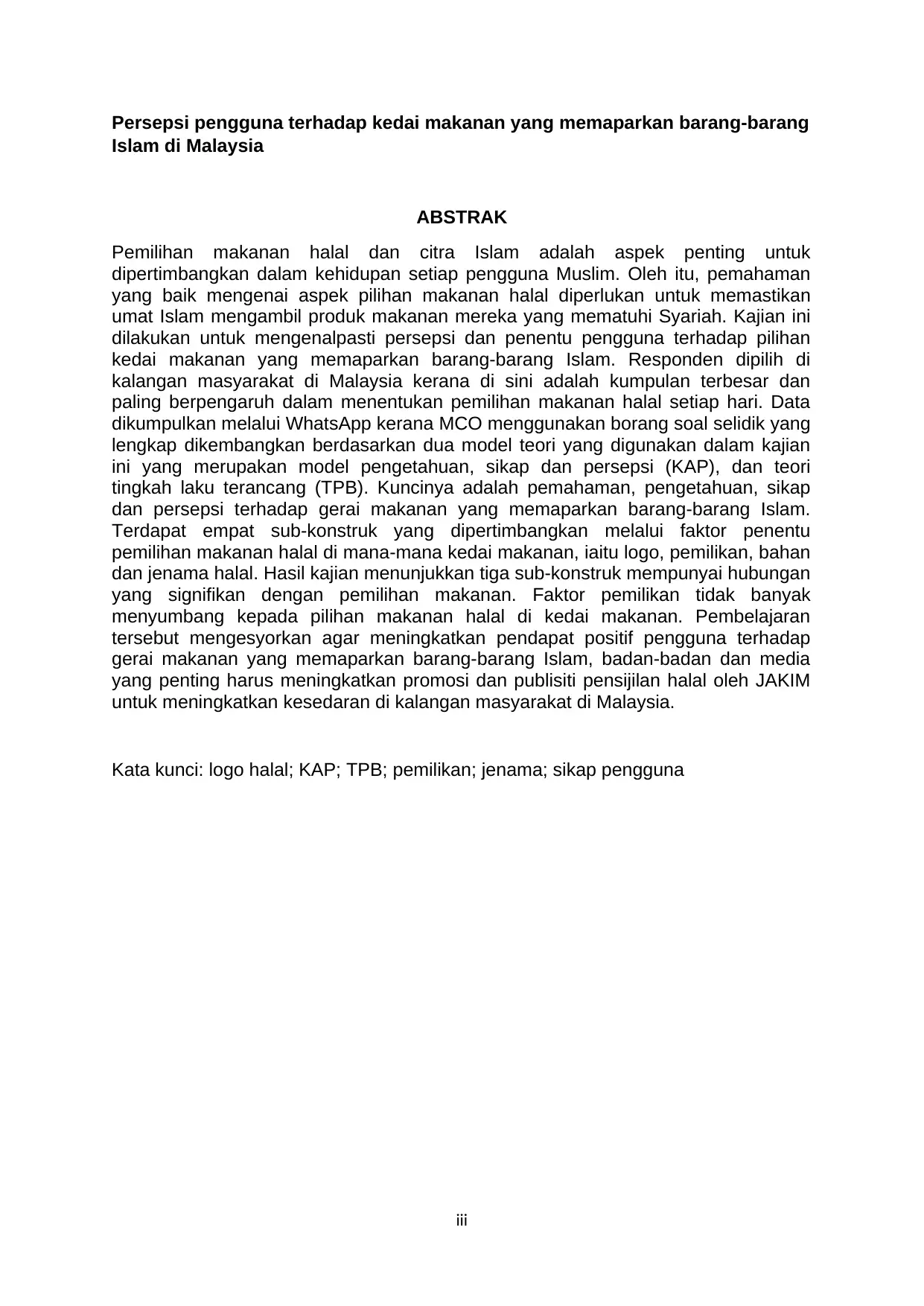
Persepsi pengguna terhadap kedai makanan yang memaparkan barang-barang
Islam di Malaysia
ABSTRAK
Pemilihan makanan halal dan citra Islam adalah aspek penting untuk
dipertimbangkan dalam kehidupan setiap pengguna Muslim. Oleh itu, pemahaman
yang baik mengenai aspek pilihan makanan halal diperlukan untuk memastikan
umat Islam mengambil produk makanan mereka yang mematuhi Syariah. Kajian ini
dilakukan untuk mengenalpasti persepsi dan penentu pengguna terhadap pilihan
kedai makanan yang memaparkan barang-barang Islam. Responden dipilih di
kalangan masyarakat di Malaysia kerana di sini adalah kumpulan terbesar dan
paling berpengaruh dalam menentukan pemilihan makanan halal setiap hari. Data
dikumpulkan melalui WhatsApp kerana MCO menggunakan borang soal selidik yang
lengkap dikembangkan berdasarkan dua model teori yang digunakan dalam kajian
ini yang merupakan model pengetahuan, sikap dan persepsi (KAP), dan teori
tingkah laku terancang (TPB). Kuncinya adalah pemahaman, pengetahuan, sikap
dan persepsi terhadap gerai makanan yang memaparkan barang-barang Islam.
Terdapat empat sub-konstruk yang dipertimbangkan melalui faktor penentu
pemilihan makanan halal di mana-mana kedai makanan, iaitu logo, pemilikan, bahan
dan jenama halal. Hasil kajian menunjukkan tiga sub-konstruk mempunyai hubungan
yang signifikan dengan pemilihan makanan. Faktor pemilikan tidak banyak
menyumbang kepada pilihan makanan halal di kedai makanan. Pembelajaran
tersebut mengesyorkan agar meningkatkan pendapat positif pengguna terhadap
gerai makanan yang memaparkan barang-barang Islam, badan-badan dan media
yang penting harus meningkatkan promosi dan publisiti pensijilan halal oleh JAKIM
untuk meningkatkan kesedaran di kalangan masyarakat di Malaysia.
Kata kunci: logo halal; KAP; TPB; pemilikan; jenama; sikap pengguna
iii
Islam di Malaysia
ABSTRAK
Pemilihan makanan halal dan citra Islam adalah aspek penting untuk
dipertimbangkan dalam kehidupan setiap pengguna Muslim. Oleh itu, pemahaman
yang baik mengenai aspek pilihan makanan halal diperlukan untuk memastikan
umat Islam mengambil produk makanan mereka yang mematuhi Syariah. Kajian ini
dilakukan untuk mengenalpasti persepsi dan penentu pengguna terhadap pilihan
kedai makanan yang memaparkan barang-barang Islam. Responden dipilih di
kalangan masyarakat di Malaysia kerana di sini adalah kumpulan terbesar dan
paling berpengaruh dalam menentukan pemilihan makanan halal setiap hari. Data
dikumpulkan melalui WhatsApp kerana MCO menggunakan borang soal selidik yang
lengkap dikembangkan berdasarkan dua model teori yang digunakan dalam kajian
ini yang merupakan model pengetahuan, sikap dan persepsi (KAP), dan teori
tingkah laku terancang (TPB). Kuncinya adalah pemahaman, pengetahuan, sikap
dan persepsi terhadap gerai makanan yang memaparkan barang-barang Islam.
Terdapat empat sub-konstruk yang dipertimbangkan melalui faktor penentu
pemilihan makanan halal di mana-mana kedai makanan, iaitu logo, pemilikan, bahan
dan jenama halal. Hasil kajian menunjukkan tiga sub-konstruk mempunyai hubungan
yang signifikan dengan pemilihan makanan. Faktor pemilikan tidak banyak
menyumbang kepada pilihan makanan halal di kedai makanan. Pembelajaran
tersebut mengesyorkan agar meningkatkan pendapat positif pengguna terhadap
gerai makanan yang memaparkan barang-barang Islam, badan-badan dan media
yang penting harus meningkatkan promosi dan publisiti pensijilan halal oleh JAKIM
untuk meningkatkan kesedaran di kalangan masyarakat di Malaysia.
Kata kunci: logo halal; KAP; TPB; pemilikan; jenama; sikap pengguna
iii
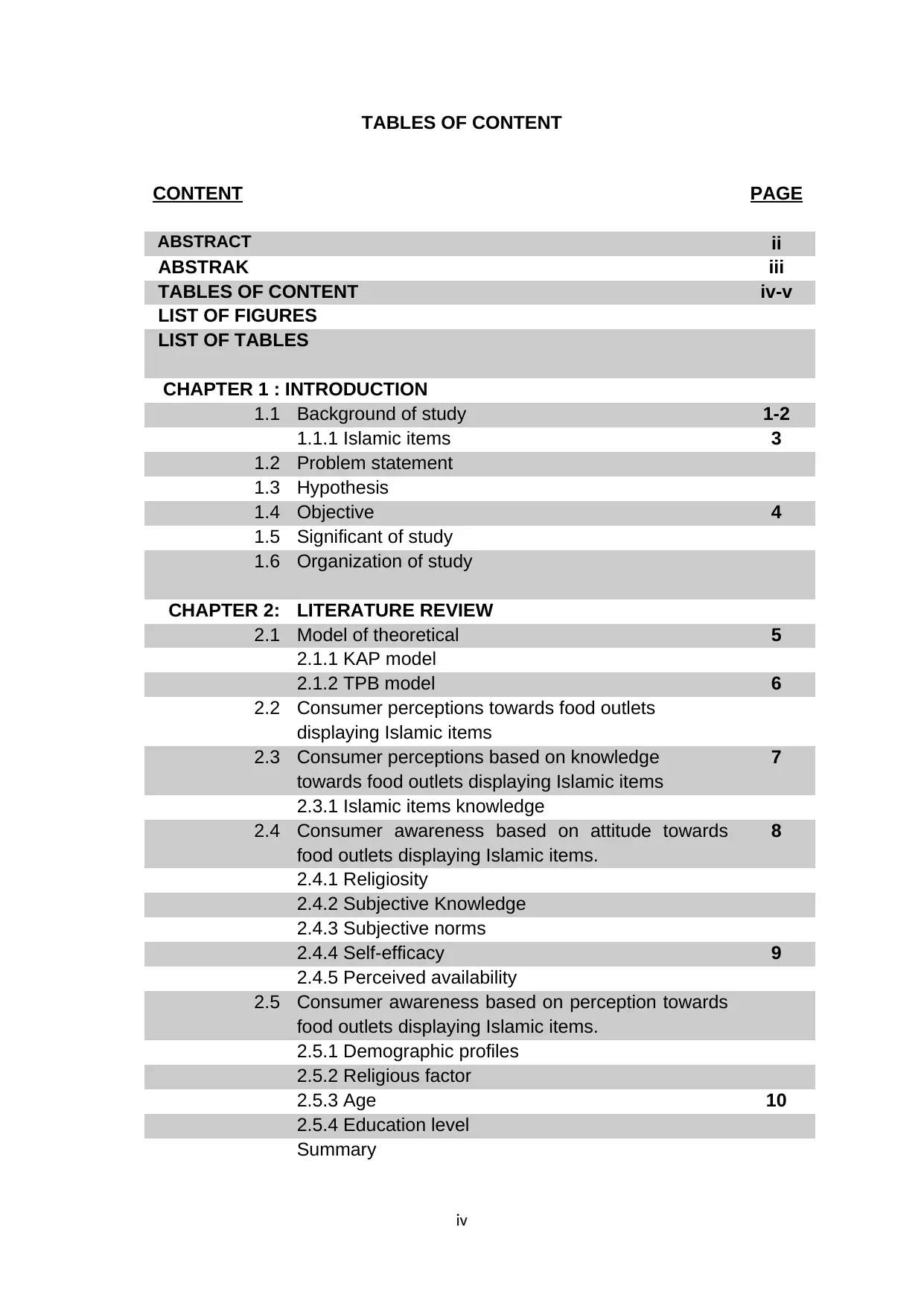
TABLES OF CONTENT
CONTENT PAGE
ABSTRACT ii
ABSTRAK iii
TABLES OF CONTENT iv-v
LIST OF FIGURES
LIST OF TABLES
CHAPTER 1 : INTRODUCTION
1.1 Background of study 1-2
1.1.1 Islamic items 3
1.2 Problem statement
1.3 Hypothesis
1.4 Objective 4
1.5 Significant of study
1.6 Organization of study
CHAPTER 2: LITERATURE REVIEW
2.1 Model of theoretical 5
2.1.1 KAP model
2.1.2 TPB model 6
2.2 Consumer perceptions towards food outlets
displaying Islamic items
2.3 Consumer perceptions based on knowledge
towards food outlets displaying Islamic items
7
2.3.1 Islamic items knowledge
2.4 Consumer awareness based on attitude towards
food outlets displaying Islamic items.
8
2.4.1 Religiosity
2.4.2 Subjective Knowledge
2.4.3 Subjective norms
2.4.4 Self-efficacy 9
2.4.5 Perceived availability
2.5 Consumer awareness based on perception towards
food outlets displaying Islamic items.
2.5.1 Demographic profiles
2.5.2 Religious factor
2.5.3 Age 10
2.5.4 Education level
Summary
iv
CONTENT PAGE
ABSTRACT ii
ABSTRAK iii
TABLES OF CONTENT iv-v
LIST OF FIGURES
LIST OF TABLES
CHAPTER 1 : INTRODUCTION
1.1 Background of study 1-2
1.1.1 Islamic items 3
1.2 Problem statement
1.3 Hypothesis
1.4 Objective 4
1.5 Significant of study
1.6 Organization of study
CHAPTER 2: LITERATURE REVIEW
2.1 Model of theoretical 5
2.1.1 KAP model
2.1.2 TPB model 6
2.2 Consumer perceptions towards food outlets
displaying Islamic items
2.3 Consumer perceptions based on knowledge
towards food outlets displaying Islamic items
7
2.3.1 Islamic items knowledge
2.4 Consumer awareness based on attitude towards
food outlets displaying Islamic items.
8
2.4.1 Religiosity
2.4.2 Subjective Knowledge
2.4.3 Subjective norms
2.4.4 Self-efficacy 9
2.4.5 Perceived availability
2.5 Consumer awareness based on perception towards
food outlets displaying Islamic items.
2.5.1 Demographic profiles
2.5.2 Religious factor
2.5.3 Age 10
2.5.4 Education level
Summary
iv
Secure Best Marks with AI Grader
Need help grading? Try our AI Grader for instant feedback on your assignments.

Chapter 3: METHODOLOGY
3.1 Conceptual Framework 11
3.2 Data Collection 12
3.2.1 Study Area
3.2.2 Pilot Study
3.2.3 Sampling Technique 13
3.3 Data Analysis
3.3.1 Descriptive Analysis
3.3.2 Reliability Test
3.4 Factor analysis 14
Summary
Chapter 4: RESULTS AND DISCUSSION
4.1 Descriptive Analysis 15-16
4.1.1 Demographics Background of Consumer
4.2 Mean 17
4.2.1 Consumer experience on visiting food outlets 18
4.2.2 Consumer’s attitude on visiting the food
outlets
19-21
4.2.3 Subjective Norm of Consumer 22
4.3 Reliability Test 23
4.4 Chi-square Analysis Test 24
4.4.1 Demographic Factor and Consumer
experience on visiting food outlets
25
4.4.2 Demographic Factor and Attitude of
Consumer Test
4.4.3 Demographic Factor and Subjective Norm of
Consumer
26
4.5 Factor Analysis
Summary 27
CHAPTER 5: CONCLUSION AND RECOMMENDATION
5.1 Conclusion 28
5.2 Recommendation 29
REFERENCES 30-32
TURNITIN
RESULT
33
v
3.1 Conceptual Framework 11
3.2 Data Collection 12
3.2.1 Study Area
3.2.2 Pilot Study
3.2.3 Sampling Technique 13
3.3 Data Analysis
3.3.1 Descriptive Analysis
3.3.2 Reliability Test
3.4 Factor analysis 14
Summary
Chapter 4: RESULTS AND DISCUSSION
4.1 Descriptive Analysis 15-16
4.1.1 Demographics Background of Consumer
4.2 Mean 17
4.2.1 Consumer experience on visiting food outlets 18
4.2.2 Consumer’s attitude on visiting the food
outlets
19-21
4.2.3 Subjective Norm of Consumer 22
4.3 Reliability Test 23
4.4 Chi-square Analysis Test 24
4.4.1 Demographic Factor and Consumer
experience on visiting food outlets
25
4.4.2 Demographic Factor and Attitude of
Consumer Test
4.4.3 Demographic Factor and Subjective Norm of
Consumer
26
4.5 Factor Analysis
Summary 27
CHAPTER 5: CONCLUSION AND RECOMMENDATION
5.1 Conclusion 28
5.2 Recommendation 29
REFERENCES 30-32
TURNITIN
RESULT
33
v

LIST OF FIGURE
FIGURE PAGE
1. The diagram of KAP Model 5
2. The diagram TPB model 6
3. Proposal Model of study 8
4. Flow of method to construct
questionnaire
11
LIST OF TABLES
TABLES PAGE
1. Demographics background of respondents 15-16
2. Consumer experience on visiting food outlets 18
3. Attitude of Consumer. 20-21
4. Subjective norm of consumers. 22
5. Reliability Statistic 23
6. Relationship between Demographic factors and
Consumer experience on visiting food outlets
24
7. Relationship between Demographic factors and
attitude consumer on visiting food outlets
25
8. Relationship between Demographic factors and
subjective norms consumer on visiting food outlets
26
vi
FIGURE PAGE
1. The diagram of KAP Model 5
2. The diagram TPB model 6
3. Proposal Model of study 8
4. Flow of method to construct
questionnaire
11
LIST OF TABLES
TABLES PAGE
1. Demographics background of respondents 15-16
2. Consumer experience on visiting food outlets 18
3. Attitude of Consumer. 20-21
4. Subjective norm of consumers. 22
5. Reliability Statistic 23
6. Relationship between Demographic factors and
Consumer experience on visiting food outlets
24
7. Relationship between Demographic factors and
attitude consumer on visiting food outlets
25
8. Relationship between Demographic factors and
subjective norms consumer on visiting food outlets
26
vi

CHAPTER 1
INTRODUCTION
This section will deliberate the consumer perception towards food outlets displaying
Islamic items in Malaysia. This covers the problem statement of the objectives,
research hypothesis, research questions, significance of the study, and organization
of the study.
1.1 Background of study
1.1.1 Islamic item
Malaysia is a country that consist mainstream of Muslim population. Although,
of their geographical and cultural range, Muslim pursue their faith and the religion of
Islam. Besides, Halal is very crucial part of religion performance for all Muslim. The
awareness consumers take of a commercial plus its goods or deal have an affected
influence on purchasing manners. That’s why dealings apply so abundant cash
marketing themselves, enhancing their consumer facility and exploit whatsoever else
they can to satisfactorily effect the perceptions of aim customers. With wary
preparation and execution, a business can impact those perceptions and stand-in
gainful consumer behaviors.
Halal is derived from Arabic described in the Language Dictionary and the
fourth version of the law requires any act (in Islam), justified or unjust, to be carried
out. The behavior permitted by Shariah. Shariah is defined as something in relation
to Islamic law. In the context of food selection, it is necessary make sure the food
you choose complies with all the laws outlined in Islam. This latest trend in behavior
change among Muslim consumers is due to two crucial reasons, namely the
increasing number of Muslims around the world and awareness-raising among
current generations (Ahlam et al. 2015). Psychological processes with the
assumption that every behavior begins with intention behaviors followed by individual
beliefs about outcomes and social pressures. An attitude factor is a person's
confidence that every behavior will make certain decisions and evaluate others'
decisions. Factor normative is the perception or way of thinking of others he thinks
it's important for him to decide what to do. As Muslims, whether they are in the
Muslim majority community or a non-Muslim majority group, they are very serious
about the focus on halal food. Positive mindset and knowledge of halal commodity is
important to Muslim consumers. Halal product is a part of religious duties.
Here confirms our belief that the halal food we consume can shape the soul
and Muslim personality. In Malaysia, the status of halal food products can be verified
through the logo halal distributed by the jabatan kemajuan Islam Malaysia (JAKIM).
However, these Halal status guidelines should be reviewed periodically and by
parents Muslims need to be aware of the need to research the materials used to
make the product food. Therefore, knowledge of the meaning of halal is very
important for Muslim consumers to make the right election action. That what we say
that every Muslim needs to confirm the source of product taken is halal plus the
whole process of halal food production it is in line with Shariah principles.
1
INTRODUCTION
This section will deliberate the consumer perception towards food outlets displaying
Islamic items in Malaysia. This covers the problem statement of the objectives,
research hypothesis, research questions, significance of the study, and organization
of the study.
1.1 Background of study
1.1.1 Islamic item
Malaysia is a country that consist mainstream of Muslim population. Although,
of their geographical and cultural range, Muslim pursue their faith and the religion of
Islam. Besides, Halal is very crucial part of religion performance for all Muslim. The
awareness consumers take of a commercial plus its goods or deal have an affected
influence on purchasing manners. That’s why dealings apply so abundant cash
marketing themselves, enhancing their consumer facility and exploit whatsoever else
they can to satisfactorily effect the perceptions of aim customers. With wary
preparation and execution, a business can impact those perceptions and stand-in
gainful consumer behaviors.
Halal is derived from Arabic described in the Language Dictionary and the
fourth version of the law requires any act (in Islam), justified or unjust, to be carried
out. The behavior permitted by Shariah. Shariah is defined as something in relation
to Islamic law. In the context of food selection, it is necessary make sure the food
you choose complies with all the laws outlined in Islam. This latest trend in behavior
change among Muslim consumers is due to two crucial reasons, namely the
increasing number of Muslims around the world and awareness-raising among
current generations (Ahlam et al. 2015). Psychological processes with the
assumption that every behavior begins with intention behaviors followed by individual
beliefs about outcomes and social pressures. An attitude factor is a person's
confidence that every behavior will make certain decisions and evaluate others'
decisions. Factor normative is the perception or way of thinking of others he thinks
it's important for him to decide what to do. As Muslims, whether they are in the
Muslim majority community or a non-Muslim majority group, they are very serious
about the focus on halal food. Positive mindset and knowledge of halal commodity is
important to Muslim consumers. Halal product is a part of religious duties.
Here confirms our belief that the halal food we consume can shape the soul
and Muslim personality. In Malaysia, the status of halal food products can be verified
through the logo halal distributed by the jabatan kemajuan Islam Malaysia (JAKIM).
However, these Halal status guidelines should be reviewed periodically and by
parents Muslims need to be aware of the need to research the materials used to
make the product food. Therefore, knowledge of the meaning of halal is very
important for Muslim consumers to make the right election action. That what we say
that every Muslim needs to confirm the source of product taken is halal plus the
whole process of halal food production it is in line with Shariah principles.
1
Paraphrase This Document
Need a fresh take? Get an instant paraphrase of this document with our AI Paraphraser
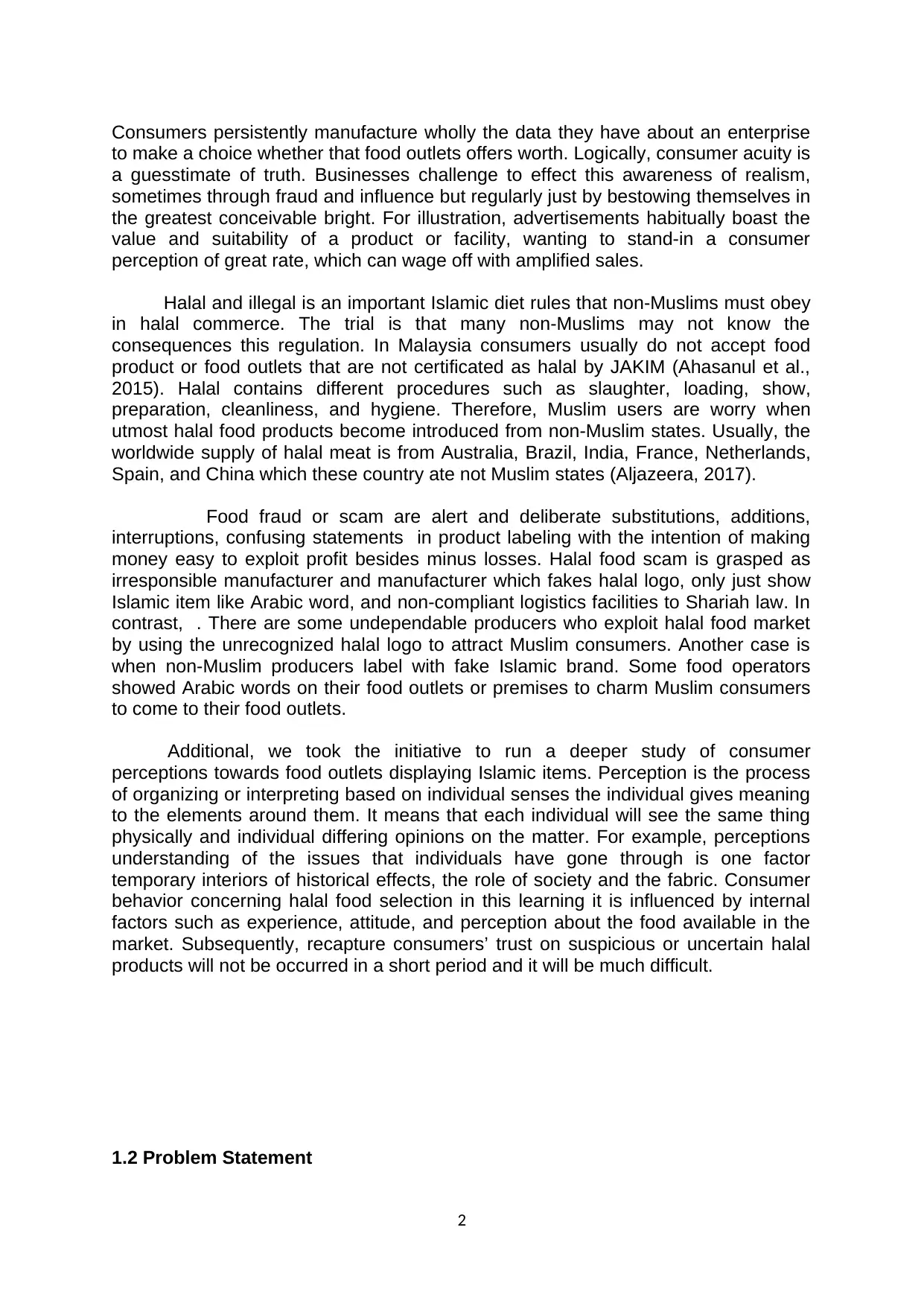
Consumers persistently manufacture wholly the data they have about an enterprise
to make a choice whether that food outlets offers worth. Logically, consumer acuity is
a guesstimate of truth. Businesses challenge to effect this awareness of realism,
sometimes through fraud and influence but regularly just by bestowing themselves in
the greatest conceivable bright. For illustration, advertisements habitually boast the
value and suitability of a product or facility, wanting to stand-in a consumer
perception of great rate, which can wage off with amplified sales.
Halal and illegal is an important Islamic diet rules that non-Muslims must obey
in halal commerce. The trial is that many non-Muslims may not know the
consequences this regulation. In Malaysia consumers usually do not accept food
product or food outlets that are not certificated as halal by JAKIM (Ahasanul et al.,
2015). Halal contains different procedures such as slaughter, loading, show,
preparation, cleanliness, and hygiene. Therefore, Muslim users are worry when
utmost halal food products become introduced from non-Muslim states. Usually, the
worldwide supply of halal meat is from Australia, Brazil, India, France, Netherlands,
Spain, and China which these country ate not Muslim states (Aljazeera, 2017).
Food fraud or scam are alert and deliberate substitutions, additions,
interruptions, confusing statements in product labeling with the intention of making
money easy to exploit profit besides minus losses. Halal food scam is grasped as
irresponsible manufacturer and manufacturer which fakes halal logo, only just show
Islamic item like Arabic word, and non-compliant logistics facilities to Shariah law. In
contrast, . There are some undependable producers who exploit halal food market
by using the unrecognized halal logo to attract Muslim consumers. Another case is
when non-Muslim producers label with fake Islamic brand. Some food operators
showed Arabic words on their food outlets or premises to charm Muslim consumers
to come to their food outlets.
Additional, we took the initiative to run a deeper study of consumer
perceptions towards food outlets displaying Islamic items. Perception is the process
of organizing or interpreting based on individual senses the individual gives meaning
to the elements around them. It means that each individual will see the same thing
physically and individual differing opinions on the matter. For example, perceptions
understanding of the issues that individuals have gone through is one factor
temporary interiors of historical effects, the role of society and the fabric. Consumer
behavior concerning halal food selection in this learning it is influenced by internal
factors such as experience, attitude, and perception about the food available in the
market. Subsequently, recapture consumers’ trust on suspicious or uncertain halal
products will not be occurred in a short period and it will be much difficult.
1.2 Problem Statement
2
to make a choice whether that food outlets offers worth. Logically, consumer acuity is
a guesstimate of truth. Businesses challenge to effect this awareness of realism,
sometimes through fraud and influence but regularly just by bestowing themselves in
the greatest conceivable bright. For illustration, advertisements habitually boast the
value and suitability of a product or facility, wanting to stand-in a consumer
perception of great rate, which can wage off with amplified sales.
Halal and illegal is an important Islamic diet rules that non-Muslims must obey
in halal commerce. The trial is that many non-Muslims may not know the
consequences this regulation. In Malaysia consumers usually do not accept food
product or food outlets that are not certificated as halal by JAKIM (Ahasanul et al.,
2015). Halal contains different procedures such as slaughter, loading, show,
preparation, cleanliness, and hygiene. Therefore, Muslim users are worry when
utmost halal food products become introduced from non-Muslim states. Usually, the
worldwide supply of halal meat is from Australia, Brazil, India, France, Netherlands,
Spain, and China which these country ate not Muslim states (Aljazeera, 2017).
Food fraud or scam are alert and deliberate substitutions, additions,
interruptions, confusing statements in product labeling with the intention of making
money easy to exploit profit besides minus losses. Halal food scam is grasped as
irresponsible manufacturer and manufacturer which fakes halal logo, only just show
Islamic item like Arabic word, and non-compliant logistics facilities to Shariah law. In
contrast, . There are some undependable producers who exploit halal food market
by using the unrecognized halal logo to attract Muslim consumers. Another case is
when non-Muslim producers label with fake Islamic brand. Some food operators
showed Arabic words on their food outlets or premises to charm Muslim consumers
to come to their food outlets.
Additional, we took the initiative to run a deeper study of consumer
perceptions towards food outlets displaying Islamic items. Perception is the process
of organizing or interpreting based on individual senses the individual gives meaning
to the elements around them. It means that each individual will see the same thing
physically and individual differing opinions on the matter. For example, perceptions
understanding of the issues that individuals have gone through is one factor
temporary interiors of historical effects, the role of society and the fabric. Consumer
behavior concerning halal food selection in this learning it is influenced by internal
factors such as experience, attitude, and perception about the food available in the
market. Subsequently, recapture consumers’ trust on suspicious or uncertain halal
products will not be occurred in a short period and it will be much difficult.
1.2 Problem Statement
2
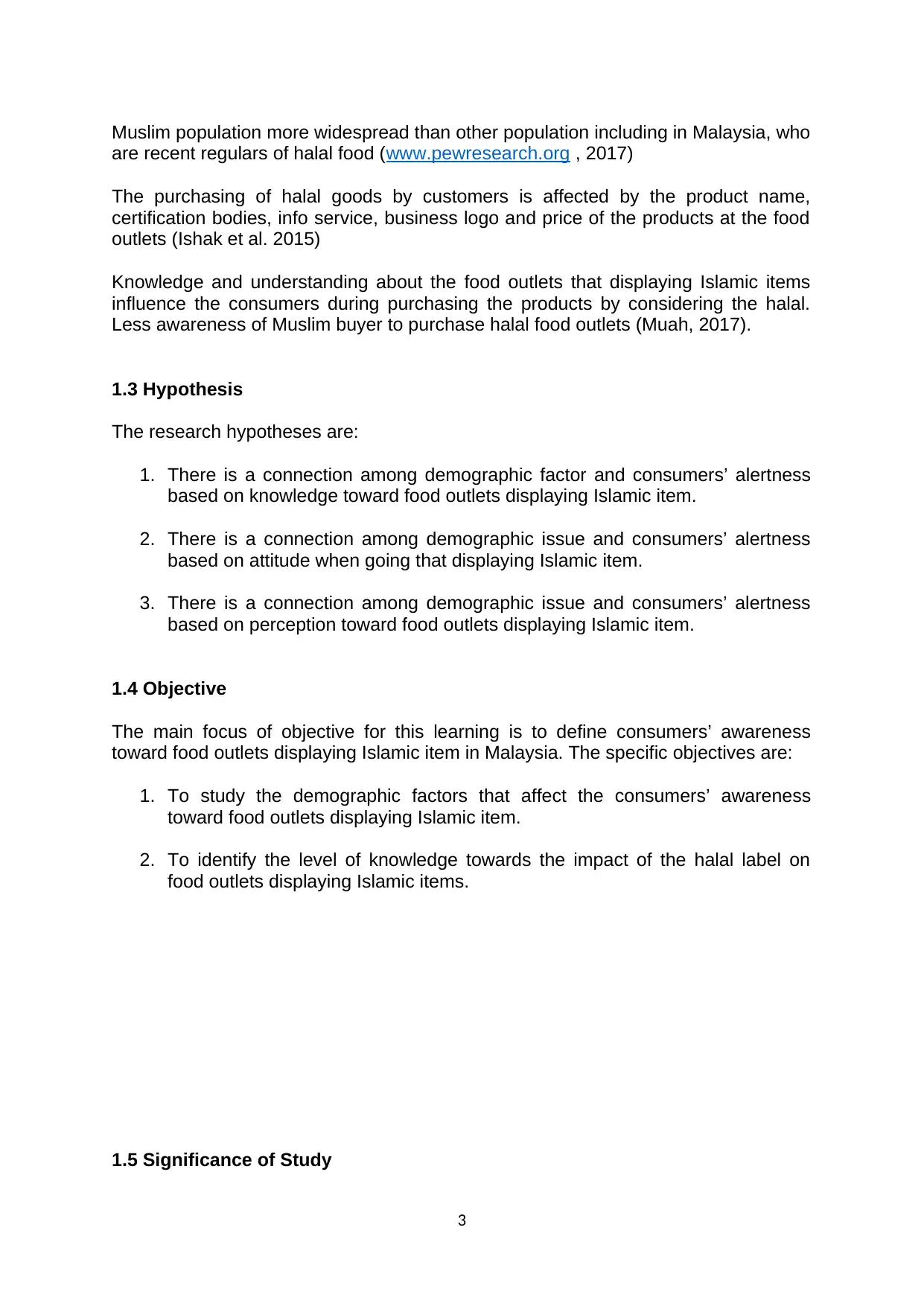
Muslim population more widespread than other population including in Malaysia, who
are recent regulars of halal food (www.pewresearch.org , 2017)
The purchasing of halal goods by customers is affected by the product name,
certification bodies, info service, business logo and price of the products at the food
outlets (Ishak et al. 2015)
Knowledge and understanding about the food outlets that displaying Islamic items
influence the consumers during purchasing the products by considering the halal.
Less awareness of Muslim buyer to purchase halal food outlets (Muah, 2017).
1.3 Hypothesis
The research hypotheses are:
1. There is a connection among demographic factor and consumers’ alertness
based on knowledge toward food outlets displaying Islamic item.
2. There is a connection among demographic issue and consumers’ alertness
based on attitude when going that displaying Islamic item.
3. There is a connection among demographic issue and consumers’ alertness
based on perception toward food outlets displaying Islamic item.
1.4 Objective
The main focus of objective for this learning is to define consumers’ awareness
toward food outlets displaying Islamic item in Malaysia. The specific objectives are:
1. To study the demographic factors that affect the consumers’ awareness
toward food outlets displaying Islamic item.
2. To identify the level of knowledge towards the impact of the halal label on
food outlets displaying Islamic items.
1.5 Significance of Study
3
are recent regulars of halal food (www.pewresearch.org , 2017)
The purchasing of halal goods by customers is affected by the product name,
certification bodies, info service, business logo and price of the products at the food
outlets (Ishak et al. 2015)
Knowledge and understanding about the food outlets that displaying Islamic items
influence the consumers during purchasing the products by considering the halal.
Less awareness of Muslim buyer to purchase halal food outlets (Muah, 2017).
1.3 Hypothesis
The research hypotheses are:
1. There is a connection among demographic factor and consumers’ alertness
based on knowledge toward food outlets displaying Islamic item.
2. There is a connection among demographic issue and consumers’ alertness
based on attitude when going that displaying Islamic item.
3. There is a connection among demographic issue and consumers’ alertness
based on perception toward food outlets displaying Islamic item.
1.4 Objective
The main focus of objective for this learning is to define consumers’ awareness
toward food outlets displaying Islamic item in Malaysia. The specific objectives are:
1. To study the demographic factors that affect the consumers’ awareness
toward food outlets displaying Islamic item.
2. To identify the level of knowledge towards the impact of the halal label on
food outlets displaying Islamic items.
1.5 Significance of Study
3
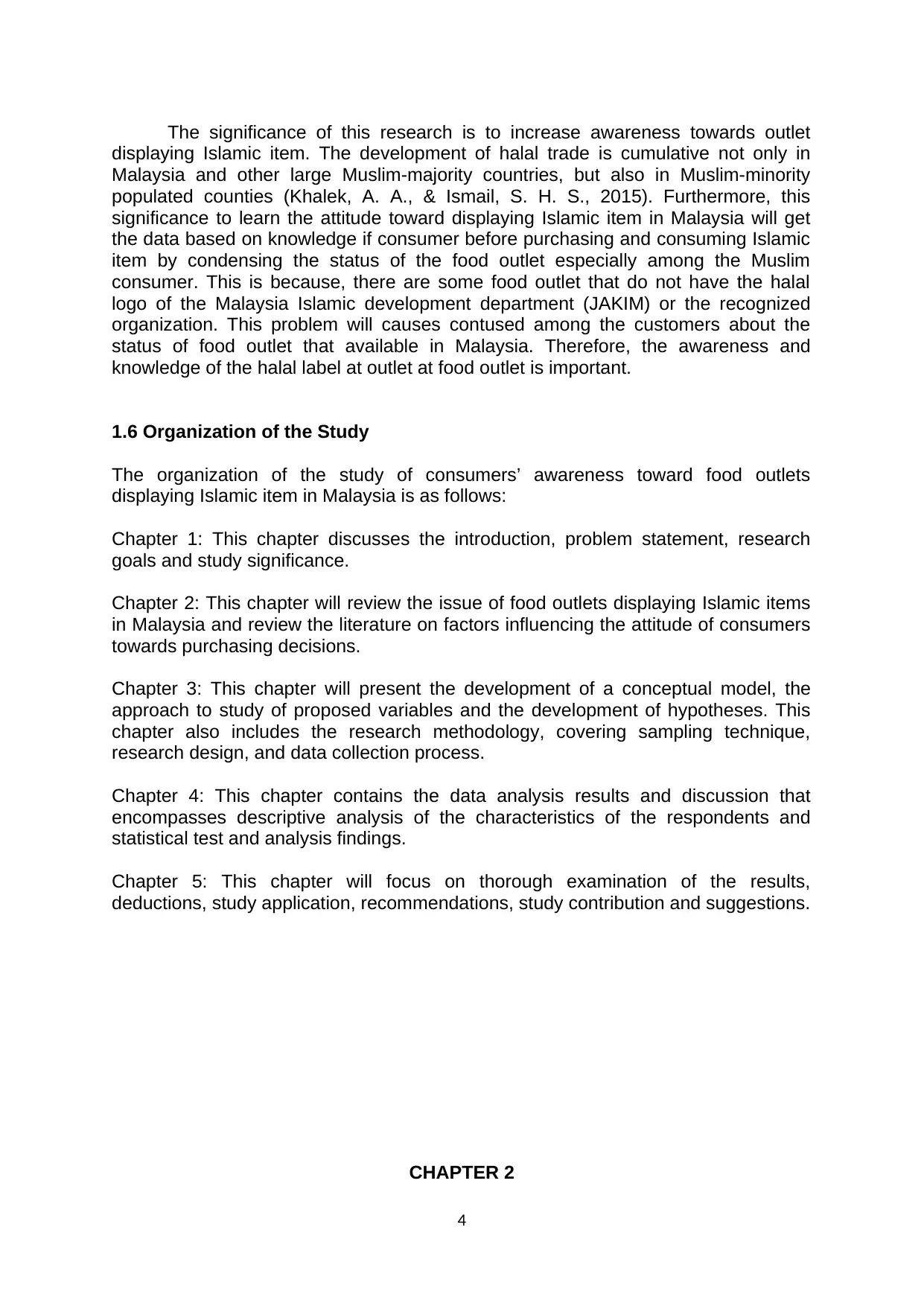
The significance of this research is to increase awareness towards outlet
displaying Islamic item. The development of halal trade is cumulative not only in
Malaysia and other large Muslim-majority countries, but also in Muslim-minority
populated counties (Khalek, A. A., & Ismail, S. H. S., 2015). Furthermore, this
significance to learn the attitude toward displaying Islamic item in Malaysia will get
the data based on knowledge if consumer before purchasing and consuming Islamic
item by condensing the status of the food outlet especially among the Muslim
consumer. This is because, there are some food outlet that do not have the halal
logo of the Malaysia Islamic development department (JAKIM) or the recognized
organization. This problem will causes contused among the customers about the
status of food outlet that available in Malaysia. Therefore, the awareness and
knowledge of the halal label at outlet at food outlet is important.
1.6 Organization of the Study
The organization of the study of consumers’ awareness toward food outlets
displaying Islamic item in Malaysia is as follows:
Chapter 1: This chapter discusses the introduction, problem statement, research
goals and study significance.
Chapter 2: This chapter will review the issue of food outlets displaying Islamic items
in Malaysia and review the literature on factors influencing the attitude of consumers
towards purchasing decisions.
Chapter 3: This chapter will present the development of a conceptual model, the
approach to study of proposed variables and the development of hypotheses. This
chapter also includes the research methodology, covering sampling technique,
research design, and data collection process.
Chapter 4: This chapter contains the data analysis results and discussion that
encompasses descriptive analysis of the characteristics of the respondents and
statistical test and analysis findings.
Chapter 5: This chapter will focus on thorough examination of the results,
deductions, study application, recommendations, study contribution and suggestions.
CHAPTER 2
4
displaying Islamic item. The development of halal trade is cumulative not only in
Malaysia and other large Muslim-majority countries, but also in Muslim-minority
populated counties (Khalek, A. A., & Ismail, S. H. S., 2015). Furthermore, this
significance to learn the attitude toward displaying Islamic item in Malaysia will get
the data based on knowledge if consumer before purchasing and consuming Islamic
item by condensing the status of the food outlet especially among the Muslim
consumer. This is because, there are some food outlet that do not have the halal
logo of the Malaysia Islamic development department (JAKIM) or the recognized
organization. This problem will causes contused among the customers about the
status of food outlet that available in Malaysia. Therefore, the awareness and
knowledge of the halal label at outlet at food outlet is important.
1.6 Organization of the Study
The organization of the study of consumers’ awareness toward food outlets
displaying Islamic item in Malaysia is as follows:
Chapter 1: This chapter discusses the introduction, problem statement, research
goals and study significance.
Chapter 2: This chapter will review the issue of food outlets displaying Islamic items
in Malaysia and review the literature on factors influencing the attitude of consumers
towards purchasing decisions.
Chapter 3: This chapter will present the development of a conceptual model, the
approach to study of proposed variables and the development of hypotheses. This
chapter also includes the research methodology, covering sampling technique,
research design, and data collection process.
Chapter 4: This chapter contains the data analysis results and discussion that
encompasses descriptive analysis of the characteristics of the respondents and
statistical test and analysis findings.
Chapter 5: This chapter will focus on thorough examination of the results,
deductions, study application, recommendations, study contribution and suggestions.
CHAPTER 2
4
Secure Best Marks with AI Grader
Need help grading? Try our AI Grader for instant feedback on your assignments.
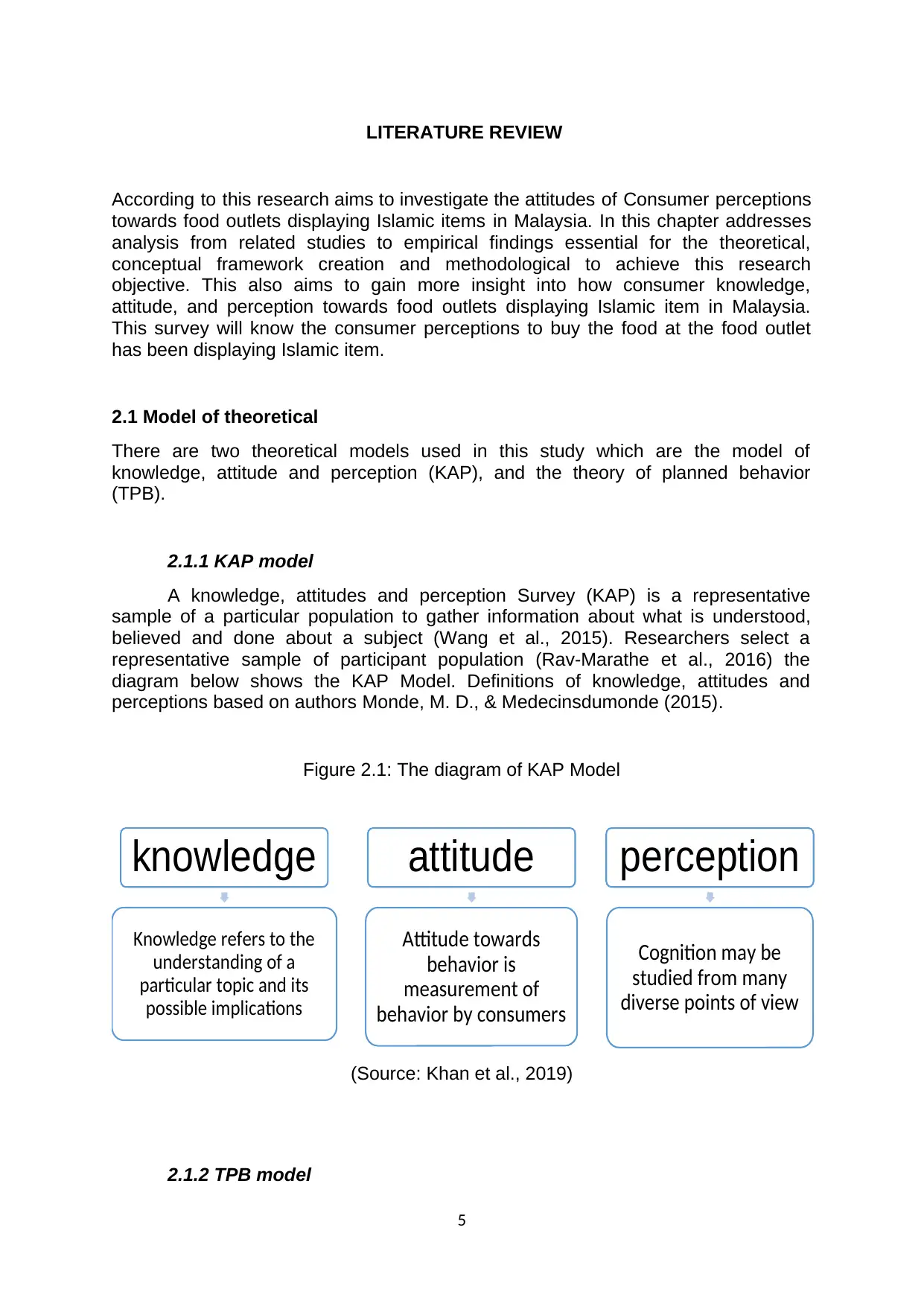
LITERATURE REVIEW
According to this research aims to investigate the attitudes of Consumer perceptions
towards food outlets displaying Islamic items in Malaysia. In this chapter addresses
analysis from related studies to empirical findings essential for the theoretical,
conceptual framework creation and methodological to achieve this research
objective. This also aims to gain more insight into how consumer knowledge,
attitude, and perception towards food outlets displaying Islamic item in Malaysia.
This survey will know the consumer perceptions to buy the food at the food outlet
has been displaying Islamic item.
2.1 Model of theoretical
There are two theoretical models used in this study which are the model of
knowledge, attitude and perception (KAP), and the theory of planned behavior
(TPB).
2.1.1 KAP model
A knowledge, attitudes and perception Survey (KAP) is a representative
sample of a particular population to gather information about what is understood,
believed and done about a subject (Wang et al., 2015). Researchers select a
representative sample of participant population (Rav-Marathe et al., 2016) the
diagram below shows the KAP Model. Definitions of knowledge, attitudes and
perceptions based on authors Monde, M. D., & Medecinsdumonde (2015).
Figure 2.1: The diagram of KAP Model
(Source: Khan et al., 2019)
2.1.2 TPB model
5
knowledge
Knowledge refers to the
understanding of a
particular topic and its
possible implications
attitude
Attitude towards
behavior is
measurement of
behavior by consumers
perception
Cognition may be
studied from many
diverse points of view
According to this research aims to investigate the attitudes of Consumer perceptions
towards food outlets displaying Islamic items in Malaysia. In this chapter addresses
analysis from related studies to empirical findings essential for the theoretical,
conceptual framework creation and methodological to achieve this research
objective. This also aims to gain more insight into how consumer knowledge,
attitude, and perception towards food outlets displaying Islamic item in Malaysia.
This survey will know the consumer perceptions to buy the food at the food outlet
has been displaying Islamic item.
2.1 Model of theoretical
There are two theoretical models used in this study which are the model of
knowledge, attitude and perception (KAP), and the theory of planned behavior
(TPB).
2.1.1 KAP model
A knowledge, attitudes and perception Survey (KAP) is a representative
sample of a particular population to gather information about what is understood,
believed and done about a subject (Wang et al., 2015). Researchers select a
representative sample of participant population (Rav-Marathe et al., 2016) the
diagram below shows the KAP Model. Definitions of knowledge, attitudes and
perceptions based on authors Monde, M. D., & Medecinsdumonde (2015).
Figure 2.1: The diagram of KAP Model
(Source: Khan et al., 2019)
2.1.2 TPB model
5
knowledge
Knowledge refers to the
understanding of a
particular topic and its
possible implications
attitude
Attitude towards
behavior is
measurement of
behavior by consumers
perception
Cognition may be
studied from many
diverse points of view
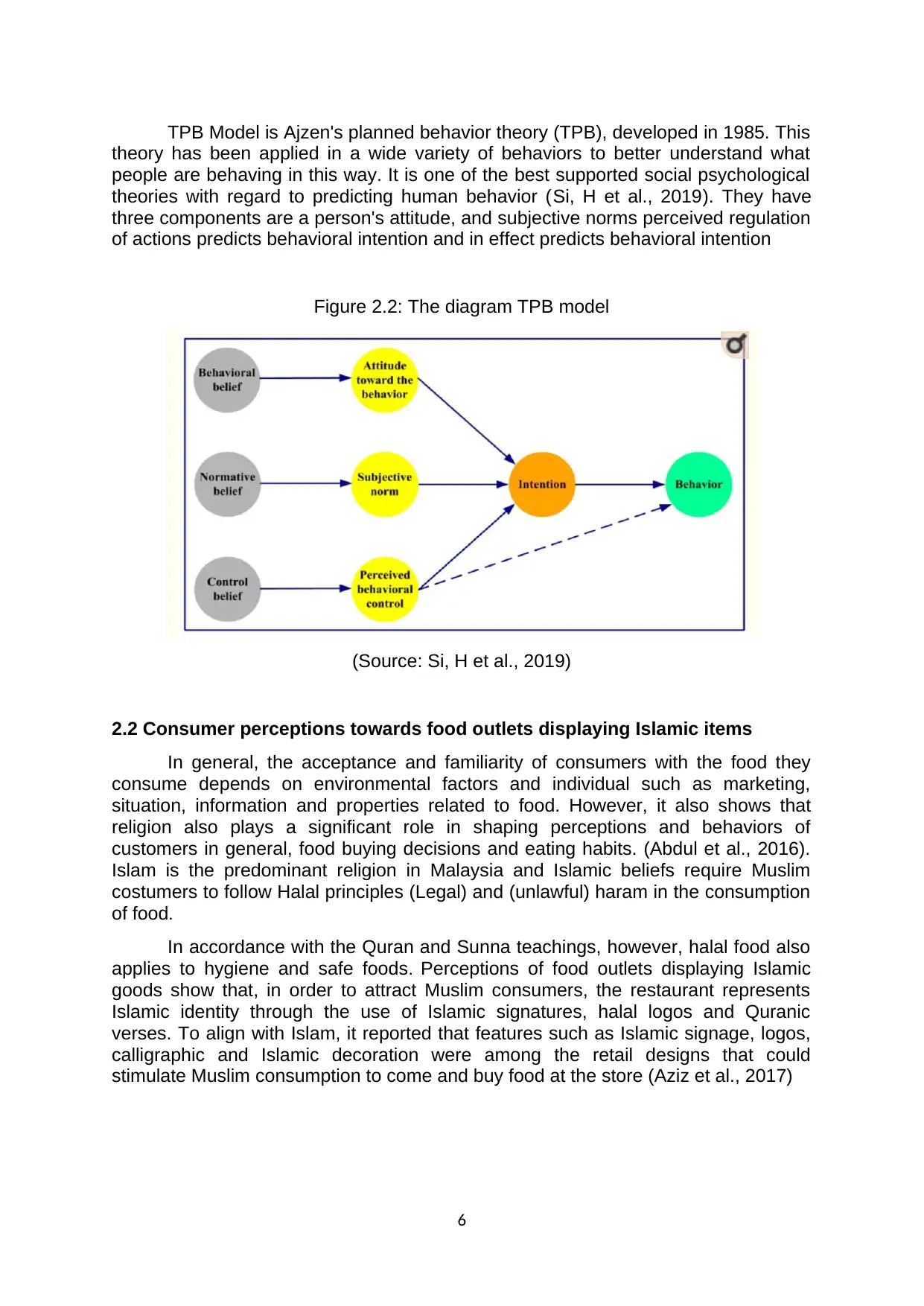
TPB Model is Ajzen's planned behavior theory (TPB), developed in 1985. This
theory has been applied in a wide variety of behaviors to better understand what
people are behaving in this way. It is one of the best supported social psychological
theories with regard to predicting human behavior (Si, H et al., 2019). They have
three components are a person's attitude, and subjective norms perceived regulation
of actions predicts behavioral intention and in effect predicts behavioral intention
Figure 2.2: The diagram TPB model
(Source: Si, H et al., 2019)
2.2 Consumer perceptions towards food outlets displaying Islamic items
In general, the acceptance and familiarity of consumers with the food they
consume depends on environmental factors and individual such as marketing,
situation, information and properties related to food. However, it also shows that
religion also plays a significant role in shaping perceptions and behaviors of
customers in general, food buying decisions and eating habits. (Abdul et al., 2016).
Islam is the predominant religion in Malaysia and Islamic beliefs require Muslim
costumers to follow Halal principles (Legal) and (unlawful) haram in the consumption
of food.
In accordance with the Quran and Sunna teachings, however, halal food also
applies to hygiene and safe foods. Perceptions of food outlets displaying Islamic
goods show that, in order to attract Muslim consumers, the restaurant represents
Islamic identity through the use of Islamic signatures, halal logos and Quranic
verses. To align with Islam, it reported that features such as Islamic signage, logos,
calligraphic and Islamic decoration were among the retail designs that could
stimulate Muslim consumption to come and buy food at the store (Aziz et al., 2017)
6
theory has been applied in a wide variety of behaviors to better understand what
people are behaving in this way. It is one of the best supported social psychological
theories with regard to predicting human behavior (Si, H et al., 2019). They have
three components are a person's attitude, and subjective norms perceived regulation
of actions predicts behavioral intention and in effect predicts behavioral intention
Figure 2.2: The diagram TPB model
(Source: Si, H et al., 2019)
2.2 Consumer perceptions towards food outlets displaying Islamic items
In general, the acceptance and familiarity of consumers with the food they
consume depends on environmental factors and individual such as marketing,
situation, information and properties related to food. However, it also shows that
religion also plays a significant role in shaping perceptions and behaviors of
customers in general, food buying decisions and eating habits. (Abdul et al., 2016).
Islam is the predominant religion in Malaysia and Islamic beliefs require Muslim
costumers to follow Halal principles (Legal) and (unlawful) haram in the consumption
of food.
In accordance with the Quran and Sunna teachings, however, halal food also
applies to hygiene and safe foods. Perceptions of food outlets displaying Islamic
goods show that, in order to attract Muslim consumers, the restaurant represents
Islamic identity through the use of Islamic signatures, halal logos and Quranic
verses. To align with Islam, it reported that features such as Islamic signage, logos,
calligraphic and Islamic decoration were among the retail designs that could
stimulate Muslim consumption to come and buy food at the store (Aziz et al., 2017)
6
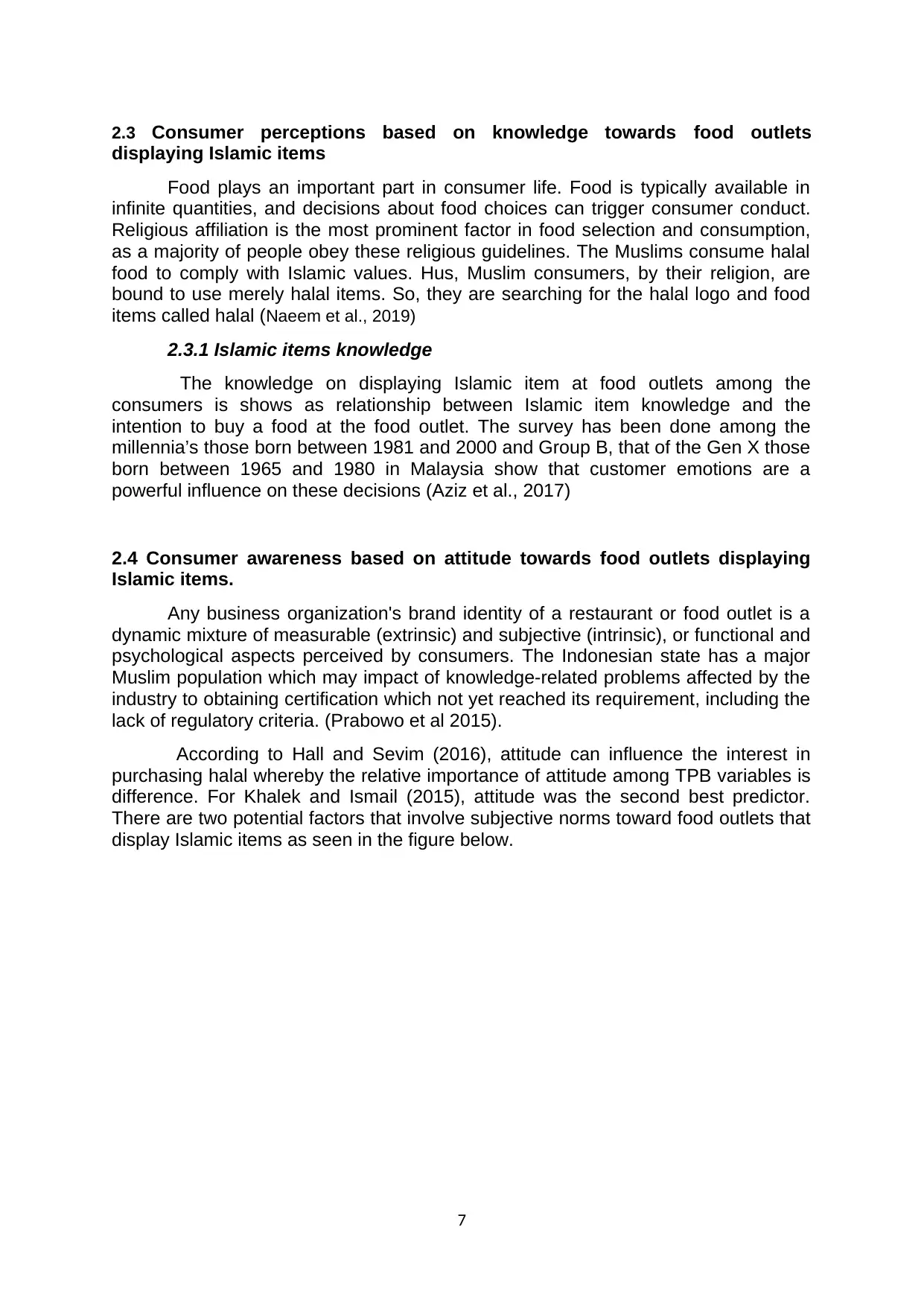
2.3 Consumer perceptions based on knowledge towards food outlets
displaying Islamic items
Food plays an important part in consumer life. Food is typically available in
infinite quantities, and decisions about food choices can trigger consumer conduct.
Religious affiliation is the most prominent factor in food selection and consumption,
as a majority of people obey these religious guidelines. The Muslims consume halal
food to comply with Islamic values. Hus, Muslim consumers, by their religion, are
bound to use merely halal items. So, they are searching for the halal logo and food
items called halal (Naeem et al., 2019)
2.3.1 Islamic items knowledge
The knowledge on displaying Islamic item at food outlets among the
consumers is shows as relationship between Islamic item knowledge and the
intention to buy a food at the food outlet. The survey has been done among the
millennia’s those born between 1981 and 2000 and Group B, that of the Gen X those
born between 1965 and 1980 in Malaysia show that customer emotions are a
powerful influence on these decisions (Aziz et al., 2017)
2.4 Consumer awareness based on attitude towards food outlets displaying
Islamic items.
Any business organization's brand identity of a restaurant or food outlet is a
dynamic mixture of measurable (extrinsic) and subjective (intrinsic), or functional and
psychological aspects perceived by consumers. The Indonesian state has a major
Muslim population which may impact of knowledge-related problems affected by the
industry to obtaining certification which not yet reached its requirement, including the
lack of regulatory criteria. (Prabowo et al 2015).
According to Hall and Sevim (2016), attitude can influence the interest in
purchasing halal whereby the relative importance of attitude among TPB variables is
difference. For Khalek and Ismail (2015), attitude was the second best predictor.
There are two potential factors that involve subjective norms toward food outlets that
display Islamic items as seen in the figure below.
7
displaying Islamic items
Food plays an important part in consumer life. Food is typically available in
infinite quantities, and decisions about food choices can trigger consumer conduct.
Religious affiliation is the most prominent factor in food selection and consumption,
as a majority of people obey these religious guidelines. The Muslims consume halal
food to comply with Islamic values. Hus, Muslim consumers, by their religion, are
bound to use merely halal items. So, they are searching for the halal logo and food
items called halal (Naeem et al., 2019)
2.3.1 Islamic items knowledge
The knowledge on displaying Islamic item at food outlets among the
consumers is shows as relationship between Islamic item knowledge and the
intention to buy a food at the food outlet. The survey has been done among the
millennia’s those born between 1981 and 2000 and Group B, that of the Gen X those
born between 1965 and 1980 in Malaysia show that customer emotions are a
powerful influence on these decisions (Aziz et al., 2017)
2.4 Consumer awareness based on attitude towards food outlets displaying
Islamic items.
Any business organization's brand identity of a restaurant or food outlet is a
dynamic mixture of measurable (extrinsic) and subjective (intrinsic), or functional and
psychological aspects perceived by consumers. The Indonesian state has a major
Muslim population which may impact of knowledge-related problems affected by the
industry to obtaining certification which not yet reached its requirement, including the
lack of regulatory criteria. (Prabowo et al 2015).
According to Hall and Sevim (2016), attitude can influence the interest in
purchasing halal whereby the relative importance of attitude among TPB variables is
difference. For Khalek and Ismail (2015), attitude was the second best predictor.
There are two potential factors that involve subjective norms toward food outlets that
display Islamic items as seen in the figure below.
7
Paraphrase This Document
Need a fresh take? Get an instant paraphrase of this document with our AI Paraphraser
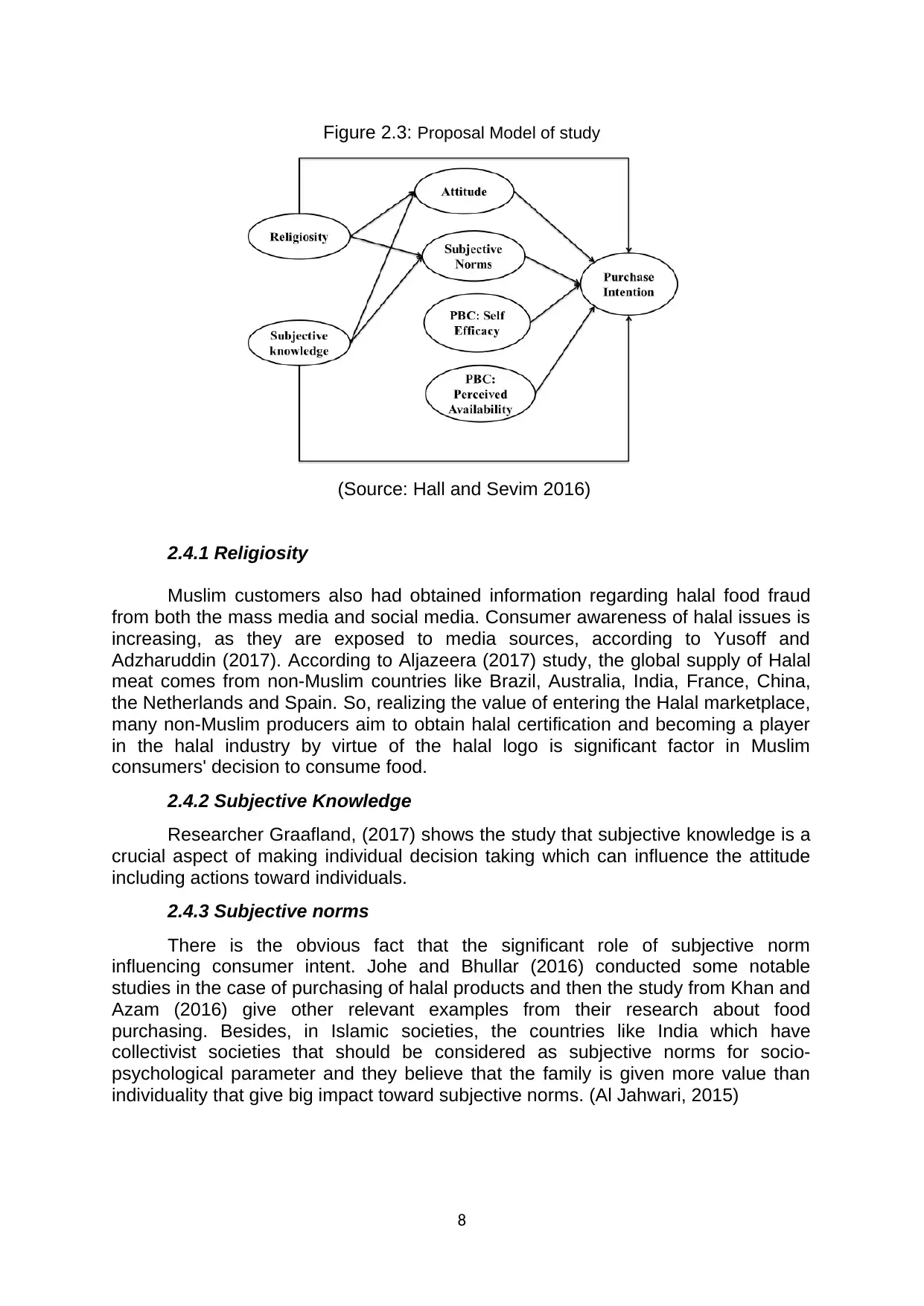
Figure 2.3: Proposal Model of study
(Source: Hall and Sevim 2016)
2.4.1 Religiosity
Muslim customers also had obtained information regarding halal food fraud
from both the mass media and social media. Consumer awareness of halal issues is
increasing, as they are exposed to media sources, according to Yusoff and
Adzharuddin (2017). According to Aljazeera (2017) study, the global supply of Halal
meat comes from non-Muslim countries like Brazil, Australia, India, France, China,
the Netherlands and Spain. So, realizing the value of entering the Halal marketplace,
many non-Muslim producers aim to obtain halal certification and becoming a player
in the halal industry by virtue of the halal logo is significant factor in Muslim
consumers' decision to consume food.
2.4.2 Subjective Knowledge
Researcher Graafland, (2017) shows the study that subjective knowledge is a
crucial aspect of making individual decision taking which can influence the attitude
including actions toward individuals.
2.4.3 Subjective norms
There is the obvious fact that the significant role of subjective norm
influencing consumer intent. Johe and Bhullar (2016) conducted some notable
studies in the case of purchasing of halal products and then the study from Khan and
Azam (2016) give other relevant examples from their research about food
purchasing. Besides, in Islamic societies, the countries like India which have
collectivist societies that should be considered as subjective norms for socio-
psychological parameter and they believe that the family is given more value than
individuality that give big impact toward subjective norms. (Al Jahwari, 2015)
8
(Source: Hall and Sevim 2016)
2.4.1 Religiosity
Muslim customers also had obtained information regarding halal food fraud
from both the mass media and social media. Consumer awareness of halal issues is
increasing, as they are exposed to media sources, according to Yusoff and
Adzharuddin (2017). According to Aljazeera (2017) study, the global supply of Halal
meat comes from non-Muslim countries like Brazil, Australia, India, France, China,
the Netherlands and Spain. So, realizing the value of entering the Halal marketplace,
many non-Muslim producers aim to obtain halal certification and becoming a player
in the halal industry by virtue of the halal logo is significant factor in Muslim
consumers' decision to consume food.
2.4.2 Subjective Knowledge
Researcher Graafland, (2017) shows the study that subjective knowledge is a
crucial aspect of making individual decision taking which can influence the attitude
including actions toward individuals.
2.4.3 Subjective norms
There is the obvious fact that the significant role of subjective norm
influencing consumer intent. Johe and Bhullar (2016) conducted some notable
studies in the case of purchasing of halal products and then the study from Khan and
Azam (2016) give other relevant examples from their research about food
purchasing. Besides, in Islamic societies, the countries like India which have
collectivist societies that should be considered as subjective norms for socio-
psychological parameter and they believe that the family is given more value than
individuality that give big impact toward subjective norms. (Al Jahwari, 2015)
8
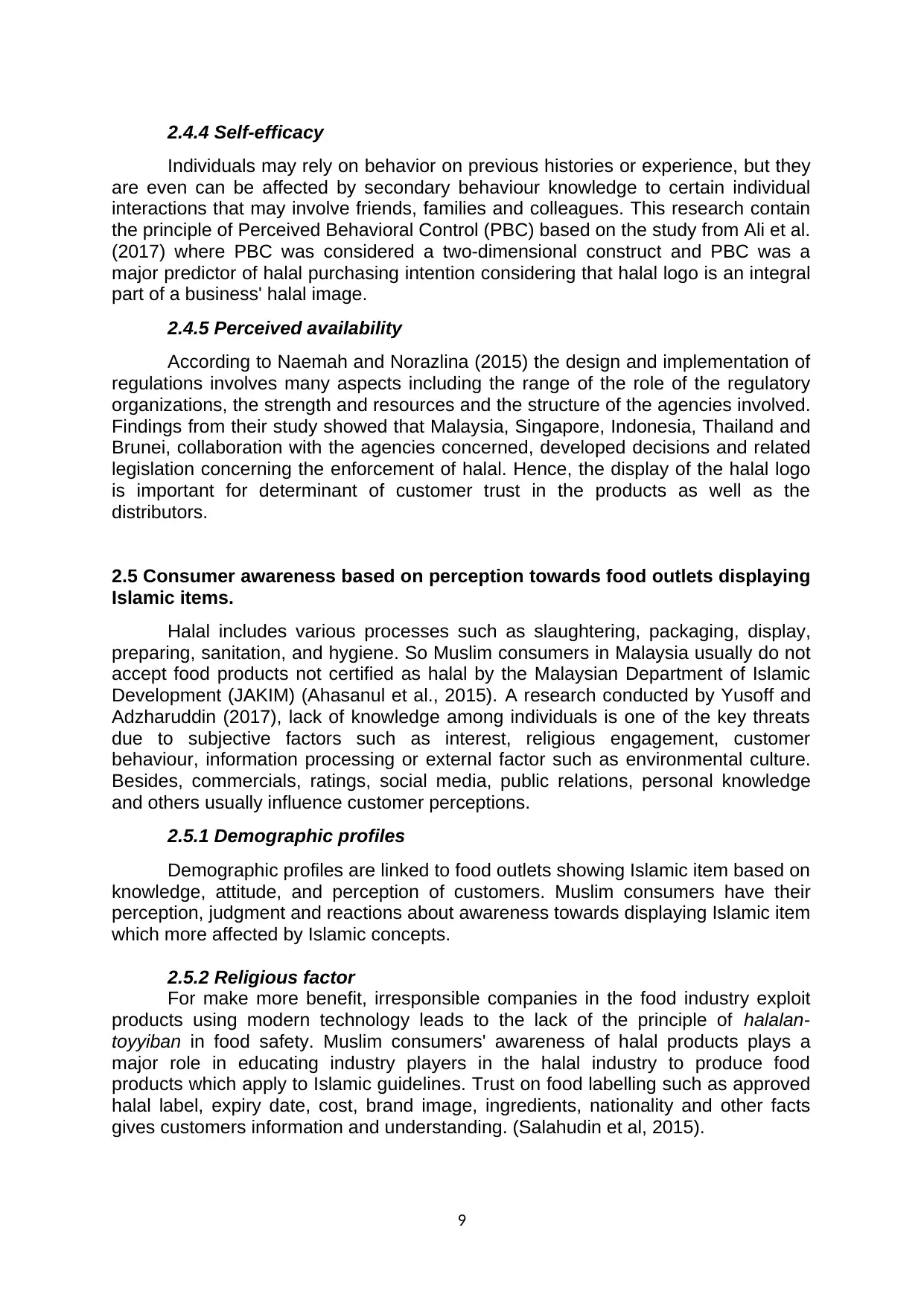
2.4.4 Self-efficacy
Individuals may rely on behavior on previous histories or experience, but they
are even can be affected by secondary behaviour knowledge to certain individual
interactions that may involve friends, families and colleagues. This research contain
the principle of Perceived Behavioral Control (PBC) based on the study from Ali et al.
(2017) where PBC was considered a two-dimensional construct and PBC was a
major predictor of halal purchasing intention considering that halal logo is an integral
part of a business' halal image.
2.4.5 Perceived availability
According to Naemah and Norazlina (2015) the design and implementation of
regulations involves many aspects including the range of the role of the regulatory
organizations, the strength and resources and the structure of the agencies involved.
Findings from their study showed that Malaysia, Singapore, Indonesia, Thailand and
Brunei, collaboration with the agencies concerned, developed decisions and related
legislation concerning the enforcement of halal. Hence, the display of the halal logo
is important for determinant of customer trust in the products as well as the
distributors.
2.5 Consumer awareness based on perception towards food outlets displaying
Islamic items.
Halal includes various processes such as slaughtering, packaging, display,
preparing, sanitation, and hygiene. So Muslim consumers in Malaysia usually do not
accept food products not certified as halal by the Malaysian Department of Islamic
Development (JAKIM) (Ahasanul et al., 2015). A research conducted by Yusoff and
Adzharuddin (2017), lack of knowledge among individuals is one of the key threats
due to subjective factors such as interest, religious engagement, customer
behaviour, information processing or external factor such as environmental culture.
Besides, commercials, ratings, social media, public relations, personal knowledge
and others usually influence customer perceptions.
2.5.1 Demographic profiles
Demographic profiles are linked to food outlets showing Islamic item based on
knowledge, attitude, and perception of customers. Muslim consumers have their
perception, judgment and reactions about awareness towards displaying Islamic item
which more affected by Islamic concepts.
2.5.2 Religious factor
For make more benefit, irresponsible companies in the food industry exploit
products using modern technology leads to the lack of the principle of halalan-
toyyiban in food safety. Muslim consumers' awareness of halal products plays a
major role in educating industry players in the halal industry to produce food
products which apply to Islamic guidelines. Trust on food labelling such as approved
halal label, expiry date, cost, brand image, ingredients, nationality and other facts
gives customers information and understanding. (Salahudin et al, 2015).
9
Individuals may rely on behavior on previous histories or experience, but they
are even can be affected by secondary behaviour knowledge to certain individual
interactions that may involve friends, families and colleagues. This research contain
the principle of Perceived Behavioral Control (PBC) based on the study from Ali et al.
(2017) where PBC was considered a two-dimensional construct and PBC was a
major predictor of halal purchasing intention considering that halal logo is an integral
part of a business' halal image.
2.4.5 Perceived availability
According to Naemah and Norazlina (2015) the design and implementation of
regulations involves many aspects including the range of the role of the regulatory
organizations, the strength and resources and the structure of the agencies involved.
Findings from their study showed that Malaysia, Singapore, Indonesia, Thailand and
Brunei, collaboration with the agencies concerned, developed decisions and related
legislation concerning the enforcement of halal. Hence, the display of the halal logo
is important for determinant of customer trust in the products as well as the
distributors.
2.5 Consumer awareness based on perception towards food outlets displaying
Islamic items.
Halal includes various processes such as slaughtering, packaging, display,
preparing, sanitation, and hygiene. So Muslim consumers in Malaysia usually do not
accept food products not certified as halal by the Malaysian Department of Islamic
Development (JAKIM) (Ahasanul et al., 2015). A research conducted by Yusoff and
Adzharuddin (2017), lack of knowledge among individuals is one of the key threats
due to subjective factors such as interest, religious engagement, customer
behaviour, information processing or external factor such as environmental culture.
Besides, commercials, ratings, social media, public relations, personal knowledge
and others usually influence customer perceptions.
2.5.1 Demographic profiles
Demographic profiles are linked to food outlets showing Islamic item based on
knowledge, attitude, and perception of customers. Muslim consumers have their
perception, judgment and reactions about awareness towards displaying Islamic item
which more affected by Islamic concepts.
2.5.2 Religious factor
For make more benefit, irresponsible companies in the food industry exploit
products using modern technology leads to the lack of the principle of halalan-
toyyiban in food safety. Muslim consumers' awareness of halal products plays a
major role in educating industry players in the halal industry to produce food
products which apply to Islamic guidelines. Trust on food labelling such as approved
halal label, expiry date, cost, brand image, ingredients, nationality and other facts
gives customers information and understanding. (Salahudin et al, 2015).
9
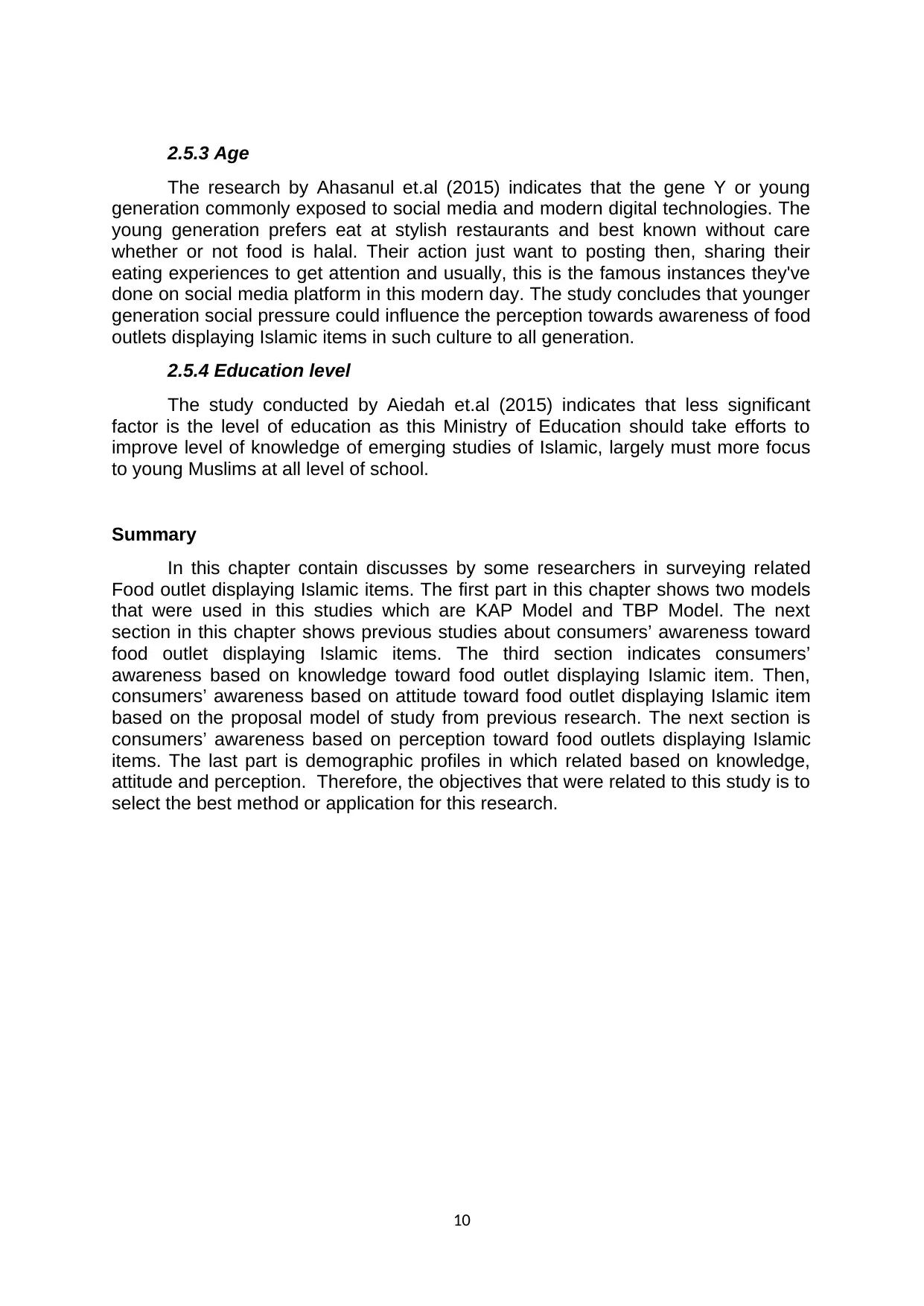
2.5.3 Age
The research by Ahasanul et.al (2015) indicates that the gene Y or young
generation commonly exposed to social media and modern digital technologies. The
young generation prefers eat at stylish restaurants and best known without care
whether or not food is halal. Their action just want to posting then, sharing their
eating experiences to get attention and usually, this is the famous instances they've
done on social media platform in this modern day. The study concludes that younger
generation social pressure could influence the perception towards awareness of food
outlets displaying Islamic items in such culture to all generation.
2.5.4 Education level
The study conducted by Aiedah et.al (2015) indicates that less significant
factor is the level of education as this Ministry of Education should take efforts to
improve level of knowledge of emerging studies of Islamic, largely must more focus
to young Muslims at all level of school.
Summary
In this chapter contain discusses by some researchers in surveying related
Food outlet displaying Islamic items. The first part in this chapter shows two models
that were used in this studies which are KAP Model and TBP Model. The next
section in this chapter shows previous studies about consumers’ awareness toward
food outlet displaying Islamic items. The third section indicates consumers’
awareness based on knowledge toward food outlet displaying Islamic item. Then,
consumers’ awareness based on attitude toward food outlet displaying Islamic item
based on the proposal model of study from previous research. The next section is
consumers’ awareness based on perception toward food outlets displaying Islamic
items. The last part is demographic profiles in which related based on knowledge,
attitude and perception. Therefore, the objectives that were related to this study is to
select the best method or application for this research.
10
The research by Ahasanul et.al (2015) indicates that the gene Y or young
generation commonly exposed to social media and modern digital technologies. The
young generation prefers eat at stylish restaurants and best known without care
whether or not food is halal. Their action just want to posting then, sharing their
eating experiences to get attention and usually, this is the famous instances they've
done on social media platform in this modern day. The study concludes that younger
generation social pressure could influence the perception towards awareness of food
outlets displaying Islamic items in such culture to all generation.
2.5.4 Education level
The study conducted by Aiedah et.al (2015) indicates that less significant
factor is the level of education as this Ministry of Education should take efforts to
improve level of knowledge of emerging studies of Islamic, largely must more focus
to young Muslims at all level of school.
Summary
In this chapter contain discusses by some researchers in surveying related
Food outlet displaying Islamic items. The first part in this chapter shows two models
that were used in this studies which are KAP Model and TBP Model. The next
section in this chapter shows previous studies about consumers’ awareness toward
food outlet displaying Islamic items. The third section indicates consumers’
awareness based on knowledge toward food outlet displaying Islamic item. Then,
consumers’ awareness based on attitude toward food outlet displaying Islamic item
based on the proposal model of study from previous research. The next section is
consumers’ awareness based on perception toward food outlets displaying Islamic
items. The last part is demographic profiles in which related based on knowledge,
attitude and perception. Therefore, the objectives that were related to this study is to
select the best method or application for this research.
10
Secure Best Marks with AI Grader
Need help grading? Try our AI Grader for instant feedback on your assignments.
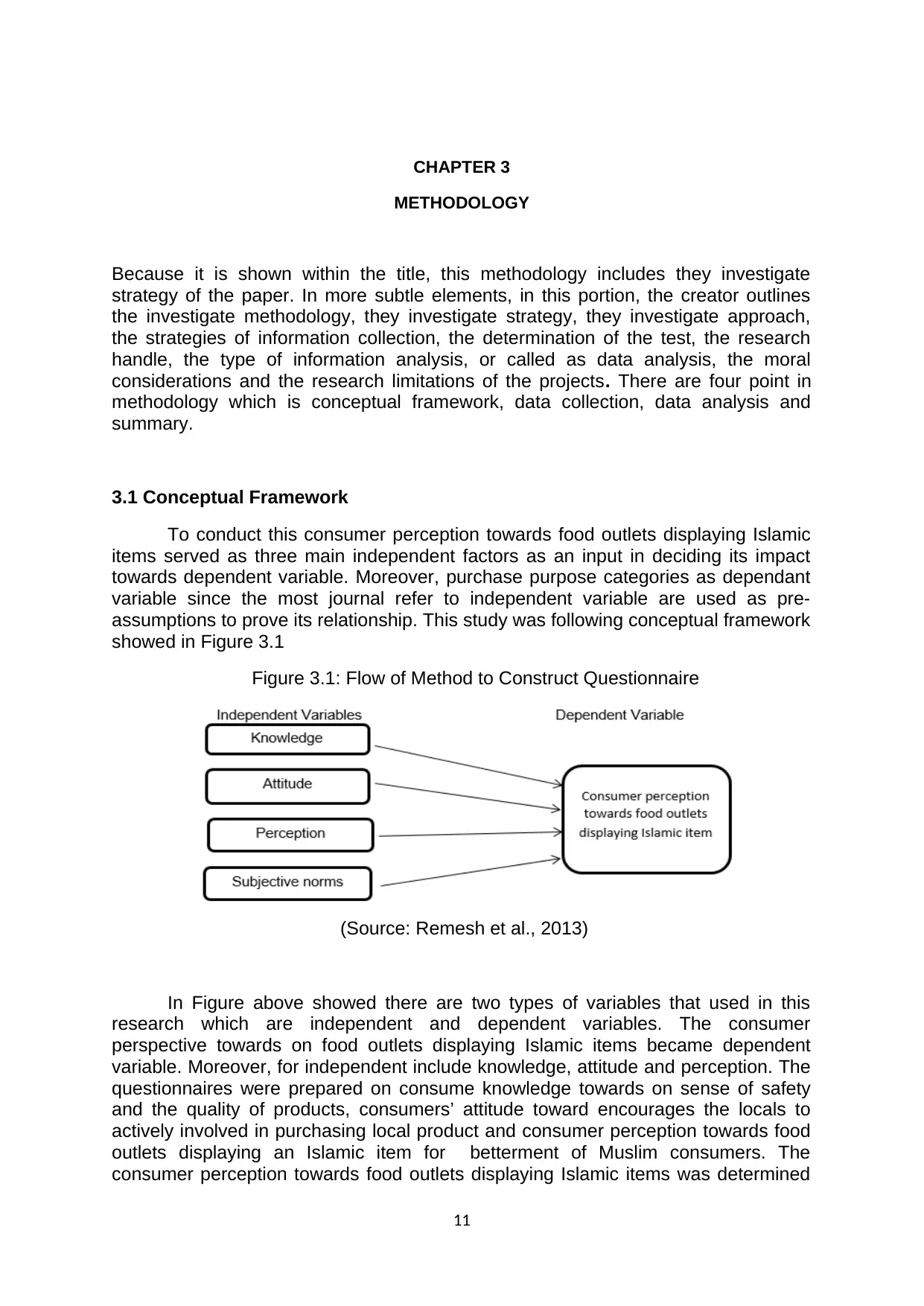
CHAPTER 3
METHODOLOGY
Because it is shown within the title, this methodology includes they investigate
strategy of the paper. In more subtle elements, in this portion, the creator outlines
the investigate methodology, they investigate strategy, they investigate approach,
the strategies of information collection, the determination of the test, the research
handle, the type of information analysis, or called as data analysis, the moral
considerations and the research limitations of the projects. There are four point in
methodology which is conceptual framework, data collection, data analysis and
summary.
3.1 Conceptual Framework
To conduct this consumer perception towards food outlets displaying Islamic
items served as three main independent factors as an input in deciding its impact
towards dependent variable. Moreover, purchase purpose categories as dependant
variable since the most journal refer to independent variable are used as pre-
assumptions to prove its relationship. This study was following conceptual framework
showed in Figure 3.1
Figure 3.1: Flow of Method to Construct Questionnaire
(Source: Remesh et al., 2013)
In Figure above showed there are two types of variables that used in this
research which are independent and dependent variables. The consumer
perspective towards on food outlets displaying Islamic items became dependent
variable. Moreover, for independent include knowledge, attitude and perception. The
questionnaires were prepared on consume knowledge towards on sense of safety
and the quality of products, consumers’ attitude toward encourages the locals to
actively involved in purchasing local product and consumer perception towards food
outlets displaying an Islamic item for betterment of Muslim consumers. The
consumer perception towards food outlets displaying Islamic items was determined
11
METHODOLOGY
Because it is shown within the title, this methodology includes they investigate
strategy of the paper. In more subtle elements, in this portion, the creator outlines
the investigate methodology, they investigate strategy, they investigate approach,
the strategies of information collection, the determination of the test, the research
handle, the type of information analysis, or called as data analysis, the moral
considerations and the research limitations of the projects. There are four point in
methodology which is conceptual framework, data collection, data analysis and
summary.
3.1 Conceptual Framework
To conduct this consumer perception towards food outlets displaying Islamic
items served as three main independent factors as an input in deciding its impact
towards dependent variable. Moreover, purchase purpose categories as dependant
variable since the most journal refer to independent variable are used as pre-
assumptions to prove its relationship. This study was following conceptual framework
showed in Figure 3.1
Figure 3.1: Flow of Method to Construct Questionnaire
(Source: Remesh et al., 2013)
In Figure above showed there are two types of variables that used in this
research which are independent and dependent variables. The consumer
perspective towards on food outlets displaying Islamic items became dependent
variable. Moreover, for independent include knowledge, attitude and perception. The
questionnaires were prepared on consume knowledge towards on sense of safety
and the quality of products, consumers’ attitude toward encourages the locals to
actively involved in purchasing local product and consumer perception towards food
outlets displaying an Islamic item for betterment of Muslim consumers. The
consumer perception towards food outlets displaying Islamic items was determined
11
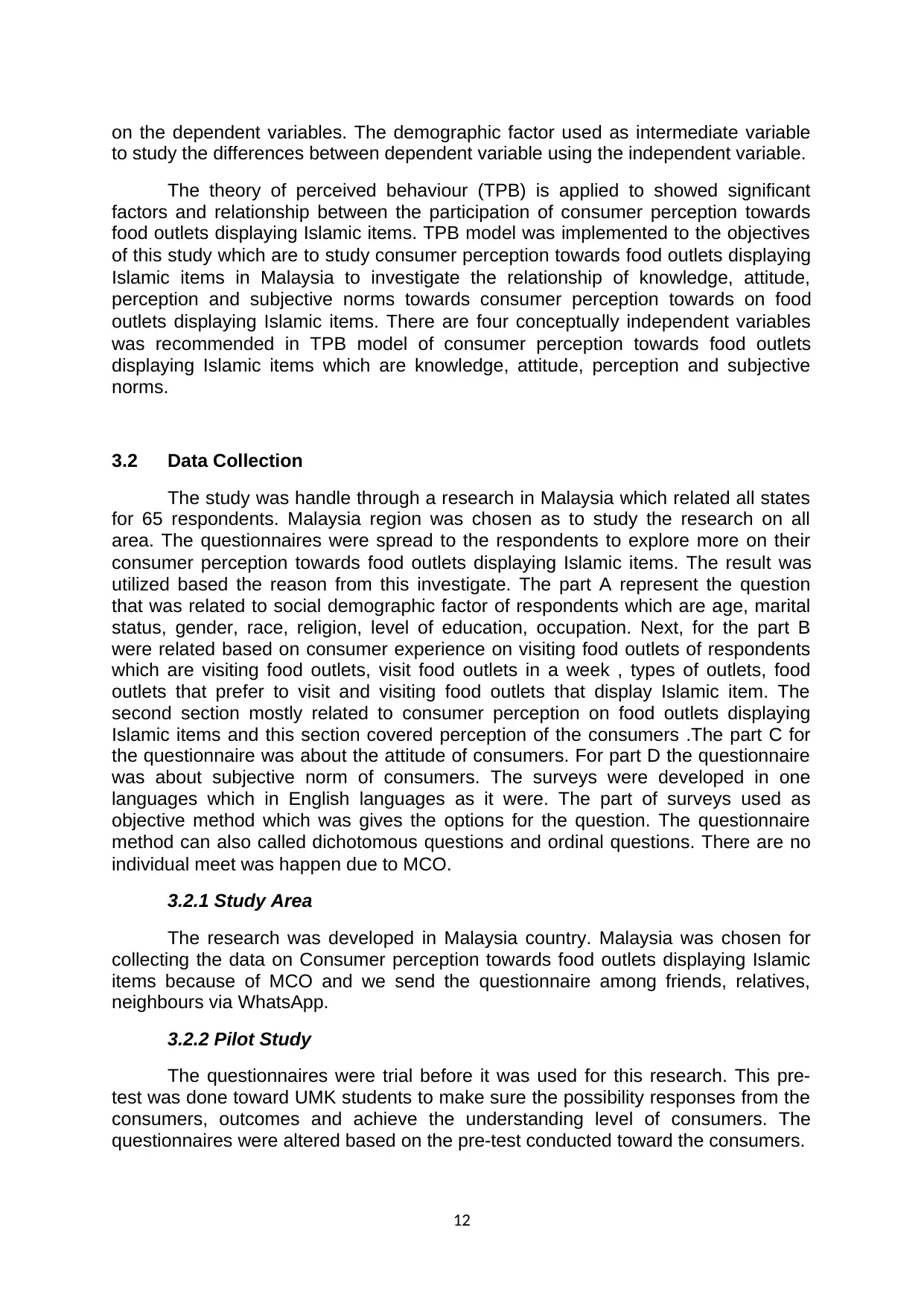
on the dependent variables. The demographic factor used as intermediate variable
to study the differences between dependent variable using the independent variable.
The theory of perceived behaviour (TPB) is applied to showed significant
factors and relationship between the participation of consumer perception towards
food outlets displaying Islamic items. TPB model was implemented to the objectives
of this study which are to study consumer perception towards food outlets displaying
Islamic items in Malaysia to investigate the relationship of knowledge, attitude,
perception and subjective norms towards consumer perception towards on food
outlets displaying Islamic items. There are four conceptually independent variables
was recommended in TPB model of consumer perception towards food outlets
displaying Islamic items which are knowledge, attitude, perception and subjective
norms.
3.2 Data Collection
The study was handle through a research in Malaysia which related all states
for 65 respondents. Malaysia region was chosen as to study the research on all
area. The questionnaires were spread to the respondents to explore more on their
consumer perception towards food outlets displaying Islamic items. The result was
utilized based the reason from this investigate. The part A represent the question
that was related to social demographic factor of respondents which are age, marital
status, gender, race, religion, level of education, occupation. Next, for the part B
were related based on consumer experience on visiting food outlets of respondents
which are visiting food outlets, visit food outlets in a week , types of outlets, food
outlets that prefer to visit and visiting food outlets that display Islamic item. The
second section mostly related to consumer perception on food outlets displaying
Islamic items and this section covered perception of the consumers .The part C for
the questionnaire was about the attitude of consumers. For part D the questionnaire
was about subjective norm of consumers. The surveys were developed in one
languages which in English languages as it were. The part of surveys used as
objective method which was gives the options for the question. The questionnaire
method can also called dichotomous questions and ordinal questions. There are no
individual meet was happen due to MCO.
3.2.1 Study Area
The research was developed in Malaysia country. Malaysia was chosen for
collecting the data on Consumer perception towards food outlets displaying Islamic
items because of MCO and we send the questionnaire among friends, relatives,
neighbours via WhatsApp.
3.2.2 Pilot Study
The questionnaires were trial before it was used for this research. This pre-
test was done toward UMK students to make sure the possibility responses from the
consumers, outcomes and achieve the understanding level of consumers. The
questionnaires were altered based on the pre-test conducted toward the consumers.
12
to study the differences between dependent variable using the independent variable.
The theory of perceived behaviour (TPB) is applied to showed significant
factors and relationship between the participation of consumer perception towards
food outlets displaying Islamic items. TPB model was implemented to the objectives
of this study which are to study consumer perception towards food outlets displaying
Islamic items in Malaysia to investigate the relationship of knowledge, attitude,
perception and subjective norms towards consumer perception towards on food
outlets displaying Islamic items. There are four conceptually independent variables
was recommended in TPB model of consumer perception towards food outlets
displaying Islamic items which are knowledge, attitude, perception and subjective
norms.
3.2 Data Collection
The study was handle through a research in Malaysia which related all states
for 65 respondents. Malaysia region was chosen as to study the research on all
area. The questionnaires were spread to the respondents to explore more on their
consumer perception towards food outlets displaying Islamic items. The result was
utilized based the reason from this investigate. The part A represent the question
that was related to social demographic factor of respondents which are age, marital
status, gender, race, religion, level of education, occupation. Next, for the part B
were related based on consumer experience on visiting food outlets of respondents
which are visiting food outlets, visit food outlets in a week , types of outlets, food
outlets that prefer to visit and visiting food outlets that display Islamic item. The
second section mostly related to consumer perception on food outlets displaying
Islamic items and this section covered perception of the consumers .The part C for
the questionnaire was about the attitude of consumers. For part D the questionnaire
was about subjective norm of consumers. The surveys were developed in one
languages which in English languages as it were. The part of surveys used as
objective method which was gives the options for the question. The questionnaire
method can also called dichotomous questions and ordinal questions. There are no
individual meet was happen due to MCO.
3.2.1 Study Area
The research was developed in Malaysia country. Malaysia was chosen for
collecting the data on Consumer perception towards food outlets displaying Islamic
items because of MCO and we send the questionnaire among friends, relatives,
neighbours via WhatsApp.
3.2.2 Pilot Study
The questionnaires were trial before it was used for this research. This pre-
test was done toward UMK students to make sure the possibility responses from the
consumers, outcomes and achieve the understanding level of consumers. The
questionnaires were altered based on the pre-test conducted toward the consumers.
12
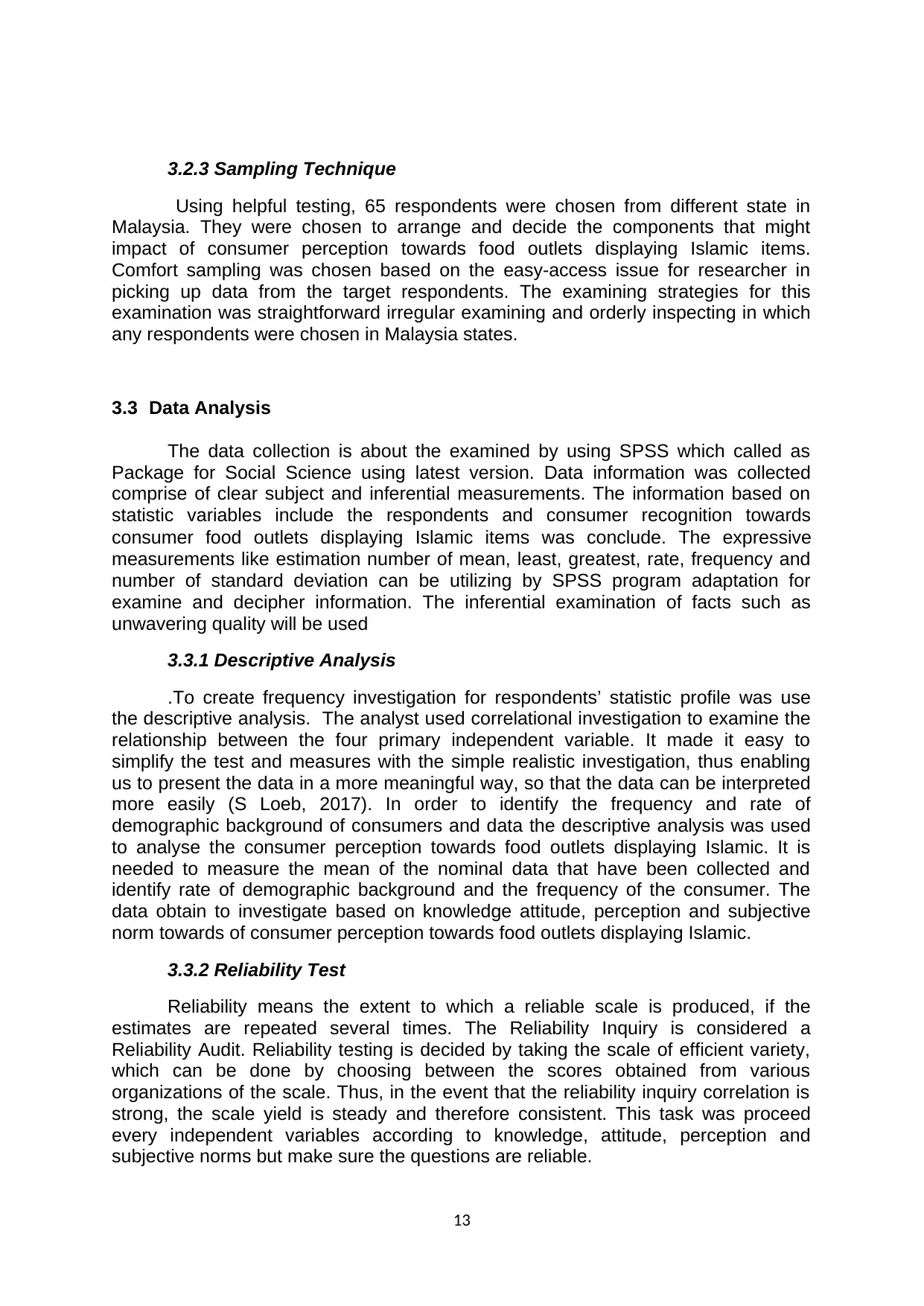
3.2.3 Sampling Technique
Using helpful testing, 65 respondents were chosen from different state in
Malaysia. They were chosen to arrange and decide the components that might
impact of consumer perception towards food outlets displaying Islamic items.
Comfort sampling was chosen based on the easy-access issue for researcher in
picking up data from the target respondents. The examining strategies for this
examination was straightforward irregular examining and orderly inspecting in which
any respondents were chosen in Malaysia states.
3.3 Data Analysis
The data collection is about the examined by using SPSS which called as
Package for Social Science using latest version. Data information was collected
comprise of clear subject and inferential measurements. The information based on
statistic variables include the respondents and consumer recognition towards
consumer food outlets displaying Islamic items was conclude. The expressive
measurements like estimation number of mean, least, greatest, rate, frequency and
number of standard deviation can be utilizing by SPSS program adaptation for
examine and decipher information. The inferential examination of facts such as
unwavering quality will be used
3.3.1 Descriptive Analysis
.To create frequency investigation for respondents’ statistic profile was use
the descriptive analysis. The analyst used correlational investigation to examine the
relationship between the four primary independent variable. It made it easy to
simplify the test and measures with the simple realistic investigation, thus enabling
us to present the data in a more meaningful way, so that the data can be interpreted
more easily (S Loeb, 2017). In order to identify the frequency and rate of
demographic background of consumers and data the descriptive analysis was used
to analyse the consumer perception towards food outlets displaying Islamic. It is
needed to measure the mean of the nominal data that have been collected and
identify rate of demographic background and the frequency of the consumer. The
data obtain to investigate based on knowledge attitude, perception and subjective
norm towards of consumer perception towards food outlets displaying Islamic.
3.3.2 Reliability Test
Reliability means the extent to which a reliable scale is produced, if the
estimates are repeated several times. The Reliability Inquiry is considered a
Reliability Audit. Reliability testing is decided by taking the scale of efficient variety,
which can be done by choosing between the scores obtained from various
organizations of the scale. Thus, in the event that the reliability inquiry correlation is
strong, the scale yield is steady and therefore consistent. This task was proceed
every independent variables according to knowledge, attitude, perception and
subjective norms but make sure the questions are reliable.
13
Using helpful testing, 65 respondents were chosen from different state in
Malaysia. They were chosen to arrange and decide the components that might
impact of consumer perception towards food outlets displaying Islamic items.
Comfort sampling was chosen based on the easy-access issue for researcher in
picking up data from the target respondents. The examining strategies for this
examination was straightforward irregular examining and orderly inspecting in which
any respondents were chosen in Malaysia states.
3.3 Data Analysis
The data collection is about the examined by using SPSS which called as
Package for Social Science using latest version. Data information was collected
comprise of clear subject and inferential measurements. The information based on
statistic variables include the respondents and consumer recognition towards
consumer food outlets displaying Islamic items was conclude. The expressive
measurements like estimation number of mean, least, greatest, rate, frequency and
number of standard deviation can be utilizing by SPSS program adaptation for
examine and decipher information. The inferential examination of facts such as
unwavering quality will be used
3.3.1 Descriptive Analysis
.To create frequency investigation for respondents’ statistic profile was use
the descriptive analysis. The analyst used correlational investigation to examine the
relationship between the four primary independent variable. It made it easy to
simplify the test and measures with the simple realistic investigation, thus enabling
us to present the data in a more meaningful way, so that the data can be interpreted
more easily (S Loeb, 2017). In order to identify the frequency and rate of
demographic background of consumers and data the descriptive analysis was used
to analyse the consumer perception towards food outlets displaying Islamic. It is
needed to measure the mean of the nominal data that have been collected and
identify rate of demographic background and the frequency of the consumer. The
data obtain to investigate based on knowledge attitude, perception and subjective
norm towards of consumer perception towards food outlets displaying Islamic.
3.3.2 Reliability Test
Reliability means the extent to which a reliable scale is produced, if the
estimates are repeated several times. The Reliability Inquiry is considered a
Reliability Audit. Reliability testing is decided by taking the scale of efficient variety,
which can be done by choosing between the scores obtained from various
organizations of the scale. Thus, in the event that the reliability inquiry correlation is
strong, the scale yield is steady and therefore consistent. This task was proceed
every independent variables according to knowledge, attitude, perception and
subjective norms but make sure the questions are reliable.
13
Paraphrase This Document
Need a fresh take? Get an instant paraphrase of this document with our AI Paraphraser
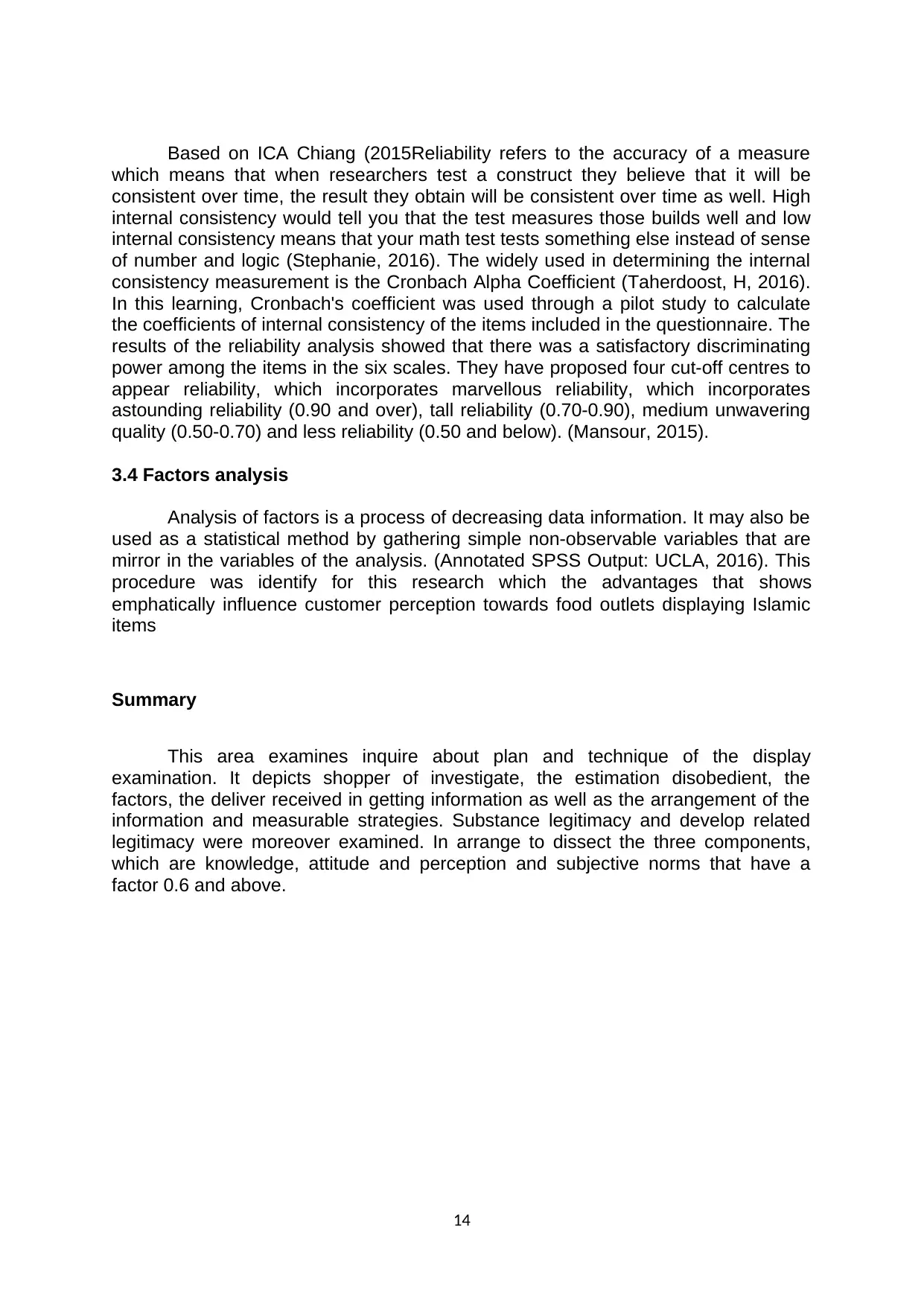
Based on ICA Chiang (2015Reliability refers to the accuracy of a measure
which means that when researchers test a construct they believe that it will be
consistent over time, the result they obtain will be consistent over time as well. High
internal consistency would tell you that the test measures those builds well and low
internal consistency means that your math test tests something else instead of sense
of number and logic (Stephanie, 2016). The widely used in determining the internal
consistency measurement is the Cronbach Alpha Coefficient (Taherdoost, H, 2016).
In this learning, Cronbach's coefficient was used through a pilot study to calculate
the coefficients of internal consistency of the items included in the questionnaire. The
results of the reliability analysis showed that there was a satisfactory discriminating
power among the items in the six scales. They have proposed four cut-off centres to
appear reliability, which incorporates marvellous reliability, which incorporates
astounding reliability (0.90 and over), tall reliability (0.70-0.90), medium unwavering
quality (0.50-0.70) and less reliability (0.50 and below). (Mansour, 2015).
3.4 Factors analysis
Analysis of factors is a process of decreasing data information. It may also be
used as a statistical method by gathering simple non-observable variables that are
mirror in the variables of the analysis. (Annotated SPSS Output: UCLA, 2016). This
procedure was identify for this research which the advantages that shows
emphatically influence customer perception towards food outlets displaying Islamic
items
Summary
This area examines inquire about plan and technique of the display
examination. It depicts shopper of investigate, the estimation disobedient, the
factors, the deliver received in getting information as well as the arrangement of the
information and measurable strategies. Substance legitimacy and develop related
legitimacy were moreover examined. In arrange to dissect the three components,
which are knowledge, attitude and perception and subjective norms that have a
factor 0.6 and above.
14
which means that when researchers test a construct they believe that it will be
consistent over time, the result they obtain will be consistent over time as well. High
internal consistency would tell you that the test measures those builds well and low
internal consistency means that your math test tests something else instead of sense
of number and logic (Stephanie, 2016). The widely used in determining the internal
consistency measurement is the Cronbach Alpha Coefficient (Taherdoost, H, 2016).
In this learning, Cronbach's coefficient was used through a pilot study to calculate
the coefficients of internal consistency of the items included in the questionnaire. The
results of the reliability analysis showed that there was a satisfactory discriminating
power among the items in the six scales. They have proposed four cut-off centres to
appear reliability, which incorporates marvellous reliability, which incorporates
astounding reliability (0.90 and over), tall reliability (0.70-0.90), medium unwavering
quality (0.50-0.70) and less reliability (0.50 and below). (Mansour, 2015).
3.4 Factors analysis
Analysis of factors is a process of decreasing data information. It may also be
used as a statistical method by gathering simple non-observable variables that are
mirror in the variables of the analysis. (Annotated SPSS Output: UCLA, 2016). This
procedure was identify for this research which the advantages that shows
emphatically influence customer perception towards food outlets displaying Islamic
items
Summary
This area examines inquire about plan and technique of the display
examination. It depicts shopper of investigate, the estimation disobedient, the
factors, the deliver received in getting information as well as the arrangement of the
information and measurable strategies. Substance legitimacy and develop related
legitimacy were moreover examined. In arrange to dissect the three components,
which are knowledge, attitude and perception and subjective norms that have a
factor 0.6 and above.
14
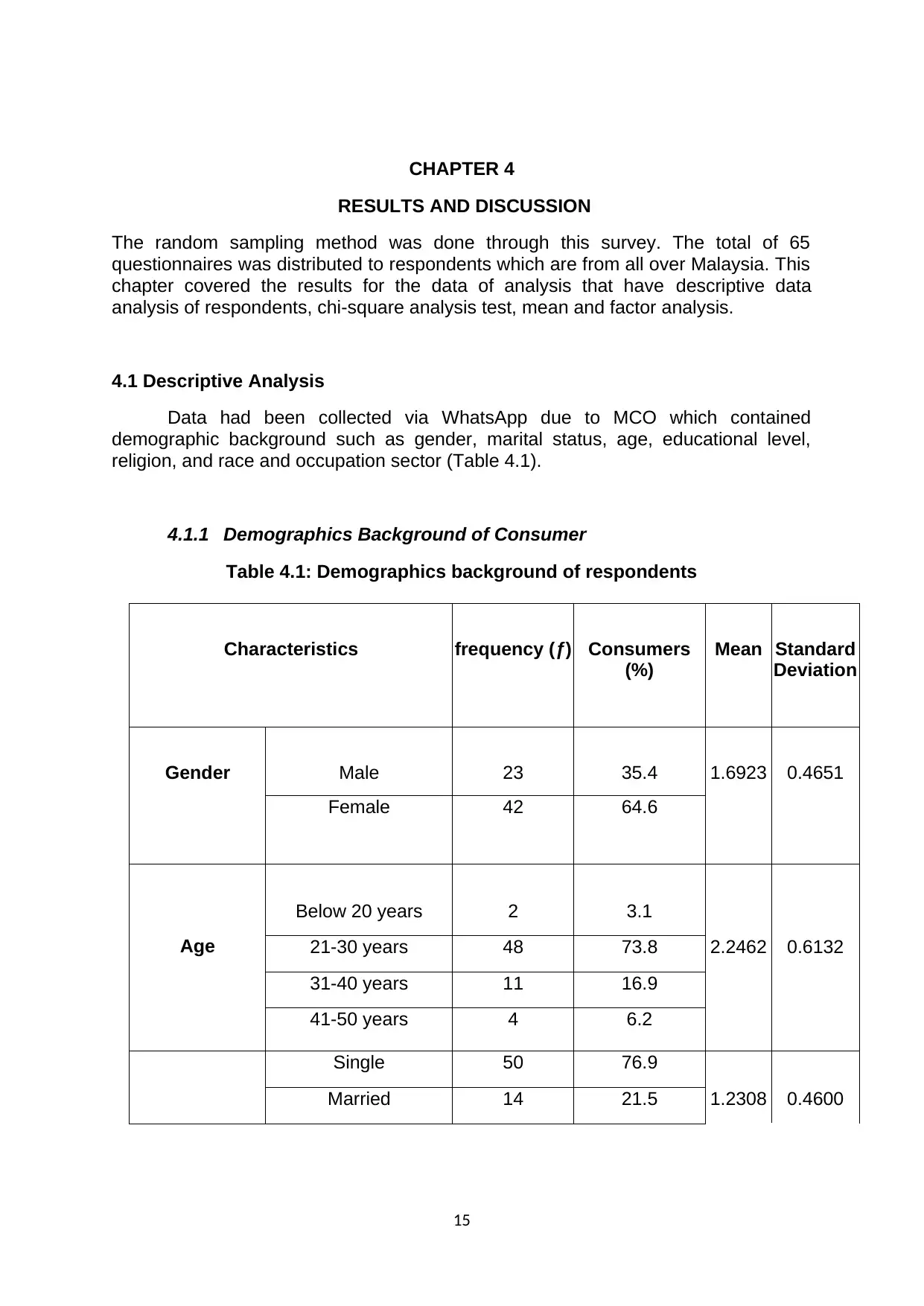
CHAPTER 4
RESULTS AND DISCUSSION
The random sampling method was done through this survey. The total of 65
questionnaires was distributed to respondents which are from all over Malaysia. This
chapter covered the results for the data of analysis that have descriptive data
analysis of respondents, chi-square analysis test, mean and factor analysis.
4.1 Descriptive Analysis
Data had been collected via WhatsApp due to MCO which contained
demographic background such as gender, marital status, age, educational level,
religion, and race and occupation sector (Table 4.1).
4.1.1 Demographics Background of Consumer
Table 4.1: Demographics background of respondents
Characteristics frequency (ƒ) Consumers
(%)
Mean Standard
Deviation
Gender Male 23 35.4 1.6923 0.4651
Female 42 64.6
Age
Below 20 years 2 3.1
21-30 years 48 73.8 2.2462 0.6132
31-40 years 11 16.9
41-50 years 4 6.2
Single 50 76.9
Married 14 21.5 1.2308 0.4600
15
RESULTS AND DISCUSSION
The random sampling method was done through this survey. The total of 65
questionnaires was distributed to respondents which are from all over Malaysia. This
chapter covered the results for the data of analysis that have descriptive data
analysis of respondents, chi-square analysis test, mean and factor analysis.
4.1 Descriptive Analysis
Data had been collected via WhatsApp due to MCO which contained
demographic background such as gender, marital status, age, educational level,
religion, and race and occupation sector (Table 4.1).
4.1.1 Demographics Background of Consumer
Table 4.1: Demographics background of respondents
Characteristics frequency (ƒ) Consumers
(%)
Mean Standard
Deviation
Gender Male 23 35.4 1.6923 0.4651
Female 42 64.6
Age
Below 20 years 2 3.1
21-30 years 48 73.8 2.2462 0.6132
31-40 years 11 16.9
41-50 years 4 6.2
Single 50 76.9
Married 14 21.5 1.2308 0.4600
15
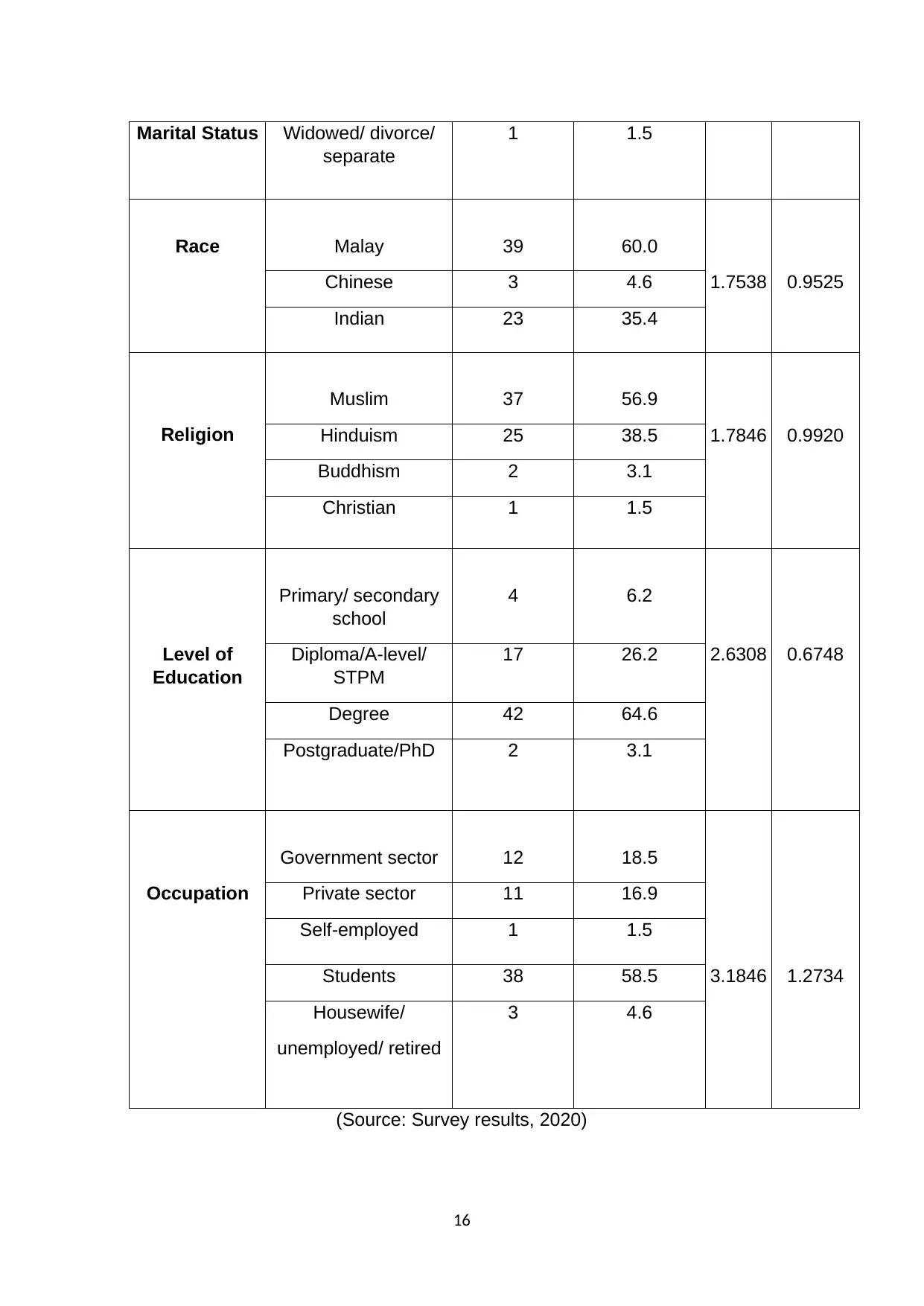
Marital Status Widowed/ divorce/
separate
1 1.5
Race Malay 39 60.0
Chinese 3 4.6 1.7538 0.9525
Indian 23 35.4
Religion
Muslim 37 56.9
Hinduism 25 38.5 1.7846 0.9920
Buddhism 2 3.1
Christian 1 1.5
Primary/ secondary
school
4 6.2
Level of
Education
Diploma/A-level/
STPM
17 26.2 2.6308 0.6748
Degree 42 64.6
Postgraduate/PhD 2 3.1
Government sector 12 18.5
Occupation Private sector 11 16.9
Self-employed 1 1.5
Students 38 58.5 3.1846 1.2734
Housewife/
unemployed/ retired
3 4.6
(Source: Survey results, 2020)
16
separate
1 1.5
Race Malay 39 60.0
Chinese 3 4.6 1.7538 0.9525
Indian 23 35.4
Religion
Muslim 37 56.9
Hinduism 25 38.5 1.7846 0.9920
Buddhism 2 3.1
Christian 1 1.5
Primary/ secondary
school
4 6.2
Level of
Education
Diploma/A-level/
STPM
17 26.2 2.6308 0.6748
Degree 42 64.6
Postgraduate/PhD 2 3.1
Government sector 12 18.5
Occupation Private sector 11 16.9
Self-employed 1 1.5
Students 38 58.5 3.1846 1.2734
Housewife/
unemployed/ retired
3 4.6
(Source: Survey results, 2020)
16
Secure Best Marks with AI Grader
Need help grading? Try our AI Grader for instant feedback on your assignments.
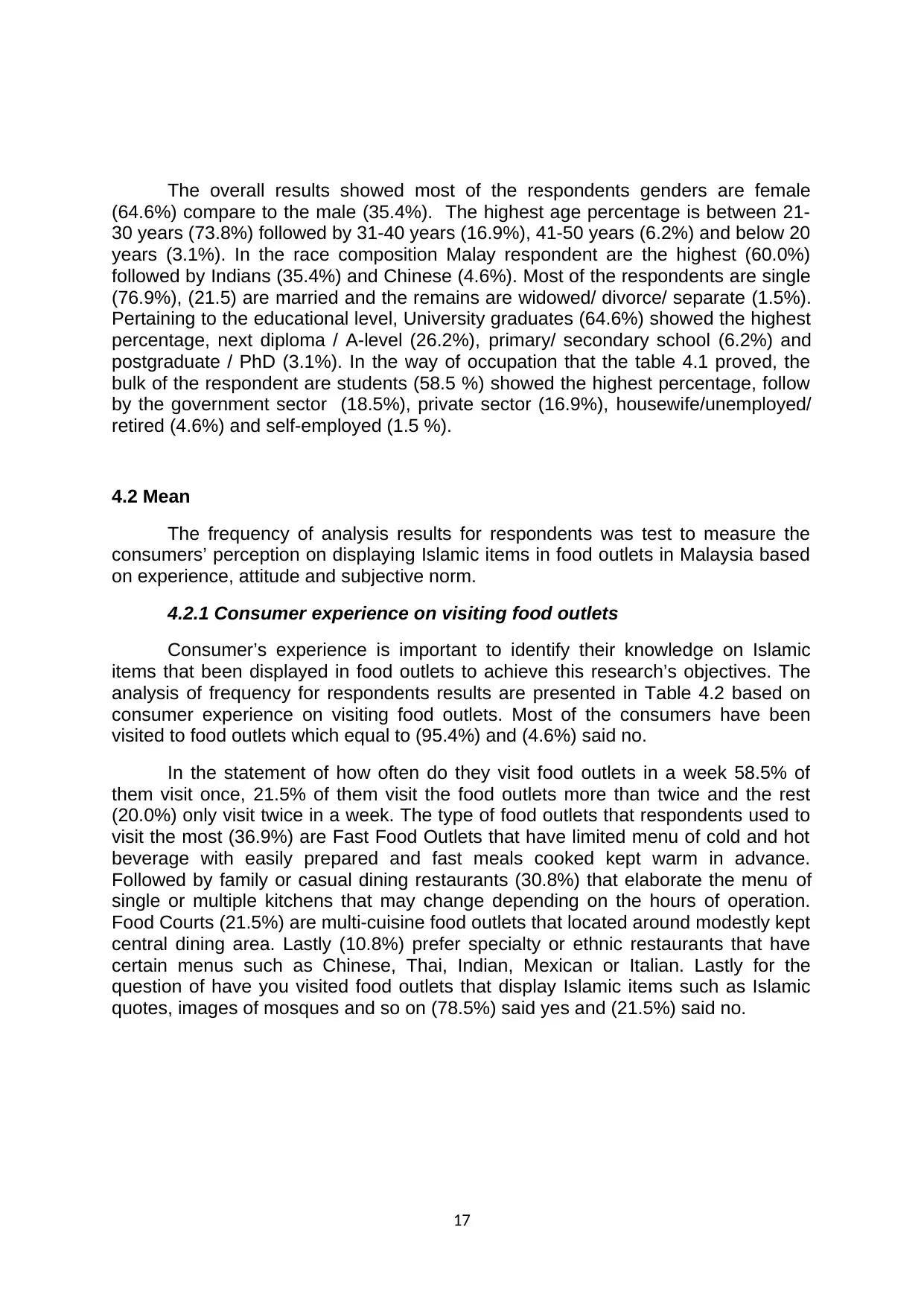
The overall results showed most of the respondents genders are female
(64.6%) compare to the male (35.4%). The highest age percentage is between 21-
30 years (73.8%) followed by 31-40 years (16.9%), 41-50 years (6.2%) and below 20
years (3.1%). In the race composition Malay respondent are the highest (60.0%)
followed by Indians (35.4%) and Chinese (4.6%). Most of the respondents are single
(76.9%), (21.5) are married and the remains are widowed/ divorce/ separate (1.5%).
Pertaining to the educational level, University graduates (64.6%) showed the highest
percentage, next diploma / A-level (26.2%), primary/ secondary school (6.2%) and
postgraduate / PhD (3.1%). In the way of occupation that the table 4.1 proved, the
bulk of the respondent are students (58.5 %) showed the highest percentage, follow
by the government sector (18.5%), private sector (16.9%), housewife/unemployed/
retired (4.6%) and self-employed (1.5 %).
4.2 Mean
The frequency of analysis results for respondents was test to measure the
consumers’ perception on displaying Islamic items in food outlets in Malaysia based
on experience, attitude and subjective norm.
4.2.1 Consumer experience on visiting food outlets
Consumer’s experience is important to identify their knowledge on Islamic
items that been displayed in food outlets to achieve this research’s objectives. The
analysis of frequency for respondents results are presented in Table 4.2 based on
consumer experience on visiting food outlets. Most of the consumers have been
visited to food outlets which equal to (95.4%) and (4.6%) said no.
In the statement of how often do they visit food outlets in a week 58.5% of
them visit once, 21.5% of them visit the food outlets more than twice and the rest
(20.0%) only visit twice in a week. The type of food outlets that respondents used to
visit the most (36.9%) are Fast Food Outlets that have limited menu of cold and hot
beverage with easily prepared and fast meals cooked kept warm in advance.
Followed by family or casual dining restaurants (30.8%) that elaborate the menu of
single or multiple kitchens that may change depending on the hours of operation.
Food Courts (21.5%) are multi-cuisine food outlets that located around modestly kept
central dining area. Lastly (10.8%) prefer specialty or ethnic restaurants that have
certain menus such as Chinese, Thai, Indian, Mexican or Italian. Lastly for the
question of have you visited food outlets that display Islamic items such as Islamic
quotes, images of mosques and so on (78.5%) said yes and (21.5%) said no.
17
(64.6%) compare to the male (35.4%). The highest age percentage is between 21-
30 years (73.8%) followed by 31-40 years (16.9%), 41-50 years (6.2%) and below 20
years (3.1%). In the race composition Malay respondent are the highest (60.0%)
followed by Indians (35.4%) and Chinese (4.6%). Most of the respondents are single
(76.9%), (21.5) are married and the remains are widowed/ divorce/ separate (1.5%).
Pertaining to the educational level, University graduates (64.6%) showed the highest
percentage, next diploma / A-level (26.2%), primary/ secondary school (6.2%) and
postgraduate / PhD (3.1%). In the way of occupation that the table 4.1 proved, the
bulk of the respondent are students (58.5 %) showed the highest percentage, follow
by the government sector (18.5%), private sector (16.9%), housewife/unemployed/
retired (4.6%) and self-employed (1.5 %).
4.2 Mean
The frequency of analysis results for respondents was test to measure the
consumers’ perception on displaying Islamic items in food outlets in Malaysia based
on experience, attitude and subjective norm.
4.2.1 Consumer experience on visiting food outlets
Consumer’s experience is important to identify their knowledge on Islamic
items that been displayed in food outlets to achieve this research’s objectives. The
analysis of frequency for respondents results are presented in Table 4.2 based on
consumer experience on visiting food outlets. Most of the consumers have been
visited to food outlets which equal to (95.4%) and (4.6%) said no.
In the statement of how often do they visit food outlets in a week 58.5% of
them visit once, 21.5% of them visit the food outlets more than twice and the rest
(20.0%) only visit twice in a week. The type of food outlets that respondents used to
visit the most (36.9%) are Fast Food Outlets that have limited menu of cold and hot
beverage with easily prepared and fast meals cooked kept warm in advance.
Followed by family or casual dining restaurants (30.8%) that elaborate the menu of
single or multiple kitchens that may change depending on the hours of operation.
Food Courts (21.5%) are multi-cuisine food outlets that located around modestly kept
central dining area. Lastly (10.8%) prefer specialty or ethnic restaurants that have
certain menus such as Chinese, Thai, Indian, Mexican or Italian. Lastly for the
question of have you visited food outlets that display Islamic items such as Islamic
quotes, images of mosques and so on (78.5%) said yes and (21.5%) said no.
17
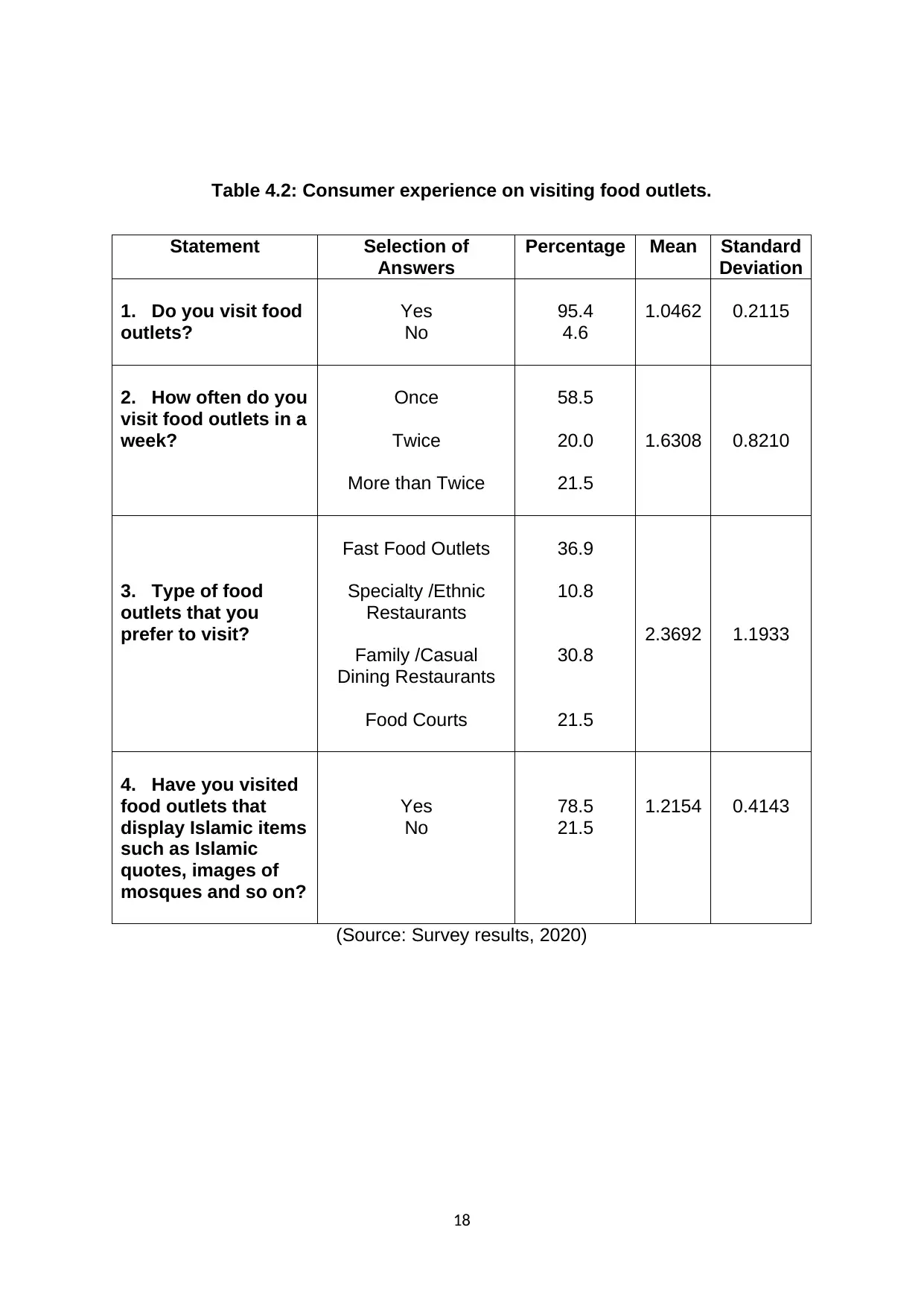
Table 4.2: Consumer experience on visiting food outlets.
Statement Selection of
Answers
Percentage Mean Standard
Deviation
1. Do you visit food
outlets?
Yes
No
95.4
4.6
1.0462 0.2115
2. How often do you
visit food outlets in a
week?
Once
Twice
More than Twice
58.5
20.0
21.5
1.6308 0.8210
3. Type of food
outlets that you
prefer to visit?
Fast Food Outlets
Specialty /Ethnic
Restaurants
Family /Casual
Dining Restaurants
Food Courts
36.9
10.8
30.8
21.5
2.3692 1.1933
4. Have you visited
food outlets that
display Islamic items
such as Islamic
quotes, images of
mosques and so on?
Yes
No
78.5
21.5
1.2154 0.4143
(Source: Survey results, 2020)
18
Statement Selection of
Answers
Percentage Mean Standard
Deviation
1. Do you visit food
outlets?
Yes
No
95.4
4.6
1.0462 0.2115
2. How often do you
visit food outlets in a
week?
Once
Twice
More than Twice
58.5
20.0
21.5
1.6308 0.8210
3. Type of food
outlets that you
prefer to visit?
Fast Food Outlets
Specialty /Ethnic
Restaurants
Family /Casual
Dining Restaurants
Food Courts
36.9
10.8
30.8
21.5
2.3692 1.1933
4. Have you visited
food outlets that
display Islamic items
such as Islamic
quotes, images of
mosques and so on?
Yes
No
78.5
21.5
1.2154 0.4143
(Source: Survey results, 2020)
18
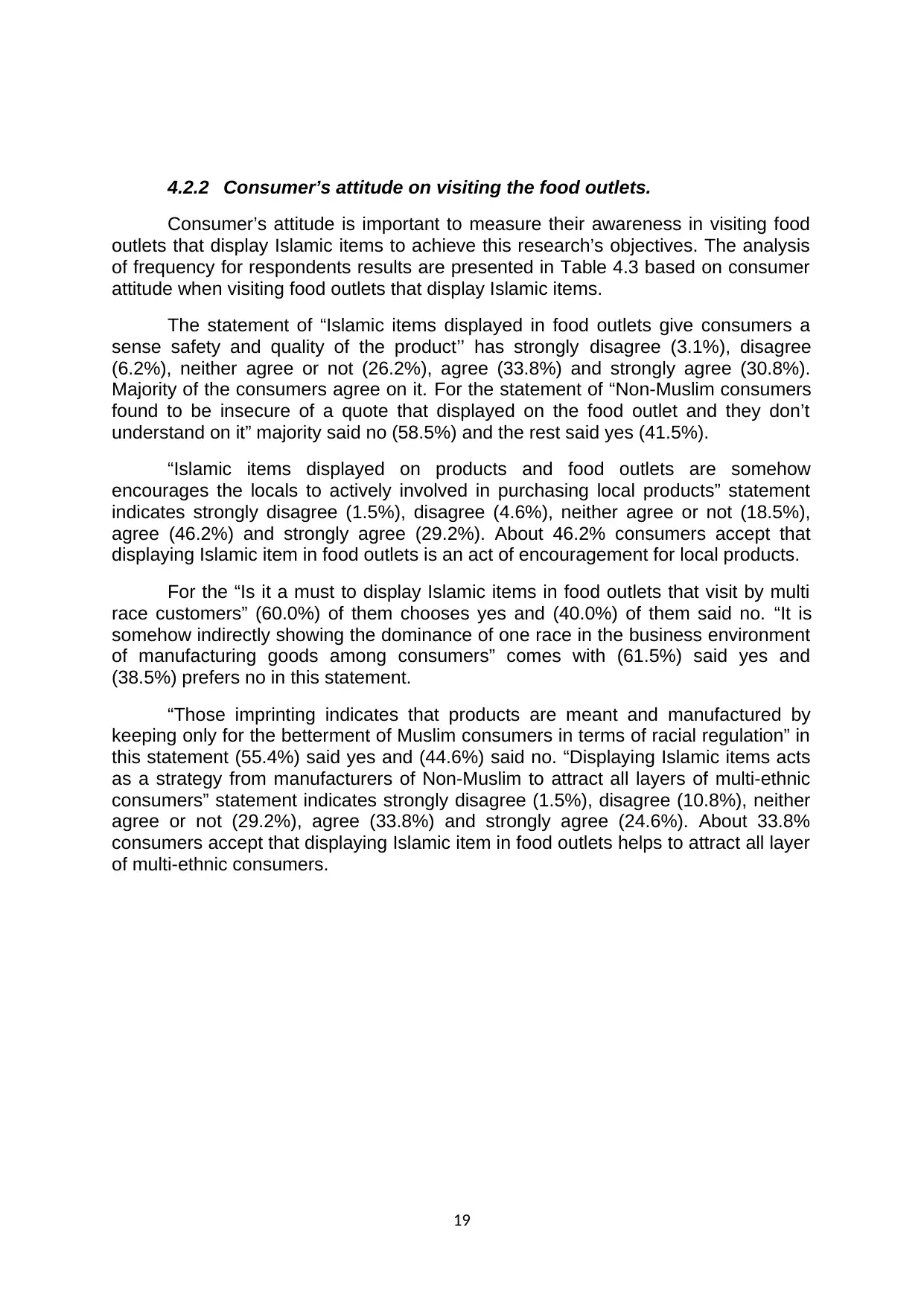
4.2.2 Consumer’s attitude on visiting the food outlets.
Consumer’s attitude is important to measure their awareness in visiting food
outlets that display Islamic items to achieve this research’s objectives. The analysis
of frequency for respondents results are presented in Table 4.3 based on consumer
attitude when visiting food outlets that display Islamic items.
The statement of “Islamic items displayed in food outlets give consumers a
sense safety and quality of the product’’ has strongly disagree (3.1%), disagree
(6.2%), neither agree or not (26.2%), agree (33.8%) and strongly agree (30.8%).
Majority of the consumers agree on it. For the statement of “Non-Muslim consumers
found to be insecure of a quote that displayed on the food outlet and they don’t
understand on it” majority said no (58.5%) and the rest said yes (41.5%).
“Islamic items displayed on products and food outlets are somehow
encourages the locals to actively involved in purchasing local products” statement
indicates strongly disagree (1.5%), disagree (4.6%), neither agree or not (18.5%),
agree (46.2%) and strongly agree (29.2%). About 46.2% consumers accept that
displaying Islamic item in food outlets is an act of encouragement for local products.
For the “Is it a must to display Islamic items in food outlets that visit by multi
race customers” (60.0%) of them chooses yes and (40.0%) of them said no. “It is
somehow indirectly showing the dominance of one race in the business environment
of manufacturing goods among consumers” comes with (61.5%) said yes and
(38.5%) prefers no in this statement.
“Those imprinting indicates that products are meant and manufactured by
keeping only for the betterment of Muslim consumers in terms of racial regulation” in
this statement (55.4%) said yes and (44.6%) said no. “Displaying Islamic items acts
as a strategy from manufacturers of Non-Muslim to attract all layers of multi-ethnic
consumers” statement indicates strongly disagree (1.5%), disagree (10.8%), neither
agree or not (29.2%), agree (33.8%) and strongly agree (24.6%). About 33.8%
consumers accept that displaying Islamic item in food outlets helps to attract all layer
of multi-ethnic consumers.
19
Consumer’s attitude is important to measure their awareness in visiting food
outlets that display Islamic items to achieve this research’s objectives. The analysis
of frequency for respondents results are presented in Table 4.3 based on consumer
attitude when visiting food outlets that display Islamic items.
The statement of “Islamic items displayed in food outlets give consumers a
sense safety and quality of the product’’ has strongly disagree (3.1%), disagree
(6.2%), neither agree or not (26.2%), agree (33.8%) and strongly agree (30.8%).
Majority of the consumers agree on it. For the statement of “Non-Muslim consumers
found to be insecure of a quote that displayed on the food outlet and they don’t
understand on it” majority said no (58.5%) and the rest said yes (41.5%).
“Islamic items displayed on products and food outlets are somehow
encourages the locals to actively involved in purchasing local products” statement
indicates strongly disagree (1.5%), disagree (4.6%), neither agree or not (18.5%),
agree (46.2%) and strongly agree (29.2%). About 46.2% consumers accept that
displaying Islamic item in food outlets is an act of encouragement for local products.
For the “Is it a must to display Islamic items in food outlets that visit by multi
race customers” (60.0%) of them chooses yes and (40.0%) of them said no. “It is
somehow indirectly showing the dominance of one race in the business environment
of manufacturing goods among consumers” comes with (61.5%) said yes and
(38.5%) prefers no in this statement.
“Those imprinting indicates that products are meant and manufactured by
keeping only for the betterment of Muslim consumers in terms of racial regulation” in
this statement (55.4%) said yes and (44.6%) said no. “Displaying Islamic items acts
as a strategy from manufacturers of Non-Muslim to attract all layers of multi-ethnic
consumers” statement indicates strongly disagree (1.5%), disagree (10.8%), neither
agree or not (29.2%), agree (33.8%) and strongly agree (24.6%). About 33.8%
consumers accept that displaying Islamic item in food outlets helps to attract all layer
of multi-ethnic consumers.
19
Paraphrase This Document
Need a fresh take? Get an instant paraphrase of this document with our AI Paraphraser
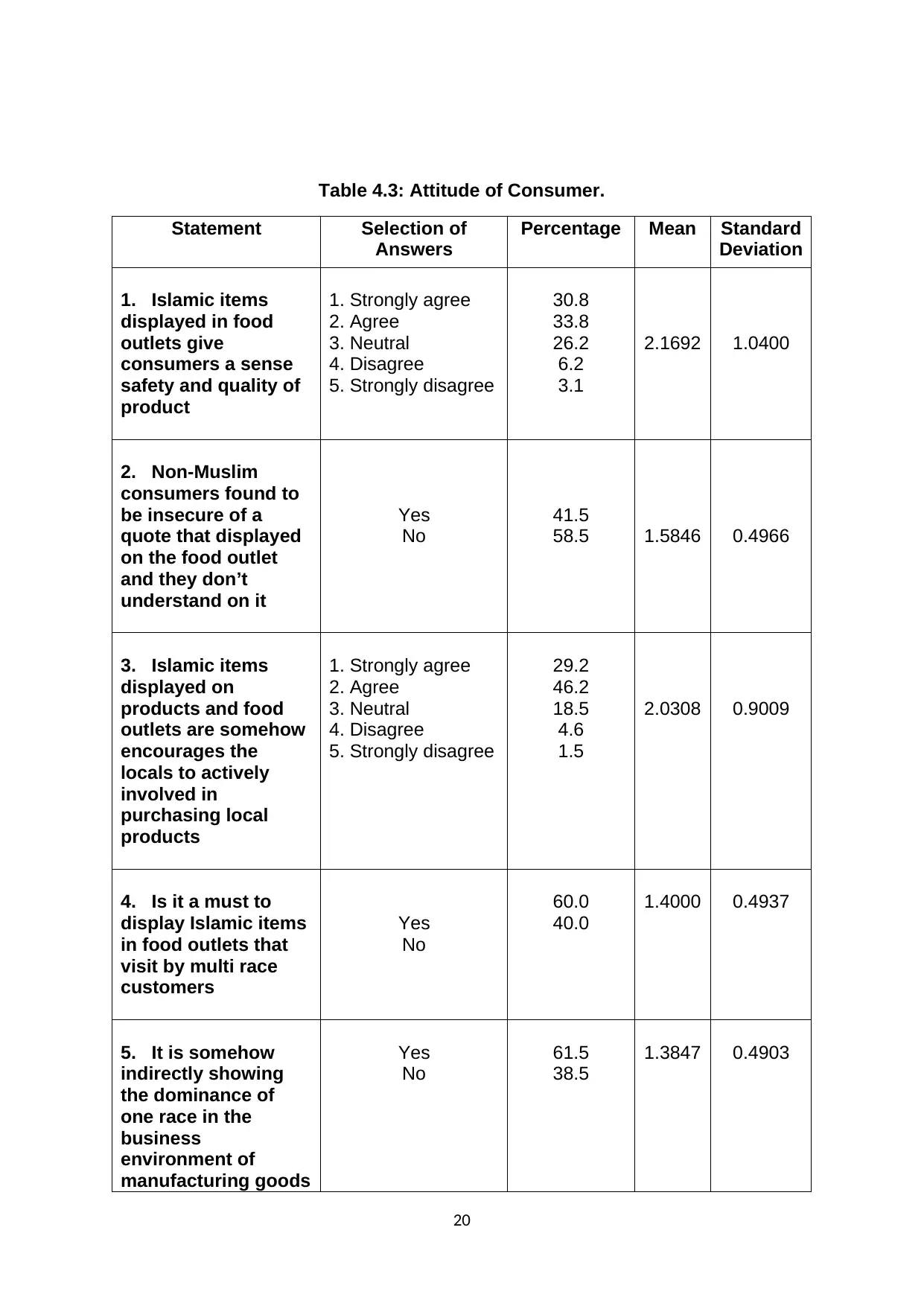
Table 4.3: Attitude of Consumer.
Statement Selection of
Answers
Percentage Mean Standard
Deviation
1. Islamic items
displayed in food
outlets give
consumers a sense
safety and quality of
product
1. Strongly agree
2. Agree
3. Neutral
4. Disagree
5. Strongly disagree
30.8
33.8
26.2
6.2
3.1
2.1692 1.0400
2. Non-Muslim
consumers found to
be insecure of a
quote that displayed
on the food outlet
and they don’t
understand on it
Yes
No
41.5
58.5 1.5846 0.4966
3. Islamic items
displayed on
products and food
outlets are somehow
encourages the
locals to actively
involved in
purchasing local
products
1. Strongly agree
2. Agree
3. Neutral
4. Disagree
5. Strongly disagree
29.2
46.2
18.5
4.6
1.5
2.0308 0.9009
4. Is it a must to
display Islamic items
in food outlets that
visit by multi race
customers
Yes
No
60.0
40.0
1.4000 0.4937
5. It is somehow
indirectly showing
the dominance of
one race in the
business
environment of
manufacturing goods
Yes
No
61.5
38.5
1.3847 0.4903
20
Statement Selection of
Answers
Percentage Mean Standard
Deviation
1. Islamic items
displayed in food
outlets give
consumers a sense
safety and quality of
product
1. Strongly agree
2. Agree
3. Neutral
4. Disagree
5. Strongly disagree
30.8
33.8
26.2
6.2
3.1
2.1692 1.0400
2. Non-Muslim
consumers found to
be insecure of a
quote that displayed
on the food outlet
and they don’t
understand on it
Yes
No
41.5
58.5 1.5846 0.4966
3. Islamic items
displayed on
products and food
outlets are somehow
encourages the
locals to actively
involved in
purchasing local
products
1. Strongly agree
2. Agree
3. Neutral
4. Disagree
5. Strongly disagree
29.2
46.2
18.5
4.6
1.5
2.0308 0.9009
4. Is it a must to
display Islamic items
in food outlets that
visit by multi race
customers
Yes
No
60.0
40.0
1.4000 0.4937
5. It is somehow
indirectly showing
the dominance of
one race in the
business
environment of
manufacturing goods
Yes
No
61.5
38.5
1.3847 0.4903
20
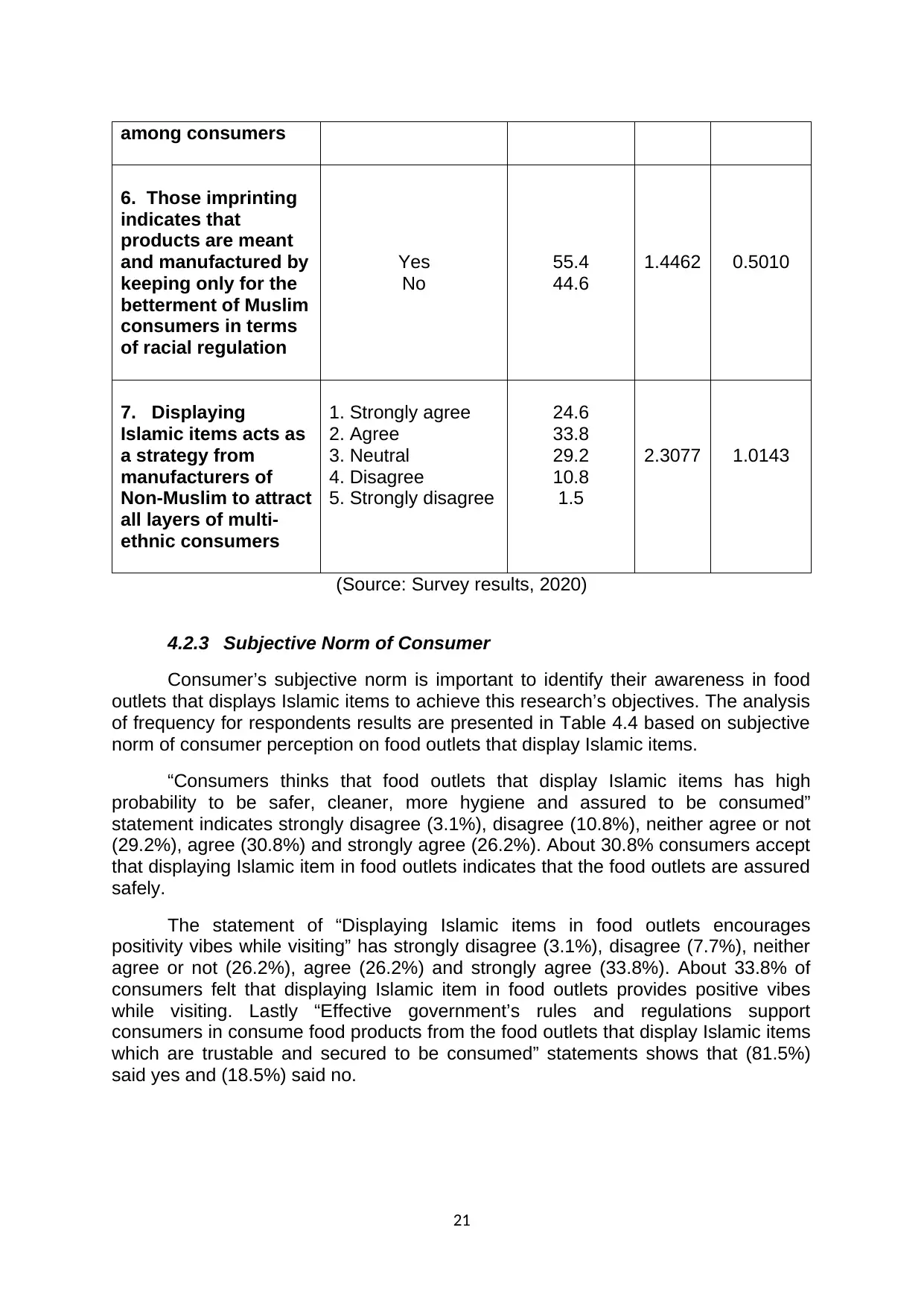
among consumers
6. Those imprinting
indicates that
products are meant
and manufactured by
keeping only for the
betterment of Muslim
consumers in terms
of racial regulation
Yes
No
55.4
44.6
1.4462 0.5010
7. Displaying
Islamic items acts as
a strategy from
manufacturers of
Non-Muslim to attract
all layers of multi-
ethnic consumers
1. Strongly agree
2. Agree
3. Neutral
4. Disagree
5. Strongly disagree
24.6
33.8
29.2
10.8
1.5
2.3077 1.0143
(Source: Survey results, 2020)
4.2.3 Subjective Norm of Consumer
Consumer’s subjective norm is important to identify their awareness in food
outlets that displays Islamic items to achieve this research’s objectives. The analysis
of frequency for respondents results are presented in Table 4.4 based on subjective
norm of consumer perception on food outlets that display Islamic items.
“Consumers thinks that food outlets that display Islamic items has high
probability to be safer, cleaner, more hygiene and assured to be consumed”
statement indicates strongly disagree (3.1%), disagree (10.8%), neither agree or not
(29.2%), agree (30.8%) and strongly agree (26.2%). About 30.8% consumers accept
that displaying Islamic item in food outlets indicates that the food outlets are assured
safely.
The statement of “Displaying Islamic items in food outlets encourages
positivity vibes while visiting” has strongly disagree (3.1%), disagree (7.7%), neither
agree or not (26.2%), agree (26.2%) and strongly agree (33.8%). About 33.8% of
consumers felt that displaying Islamic item in food outlets provides positive vibes
while visiting. Lastly “Effective government’s rules and regulations support
consumers in consume food products from the food outlets that display Islamic items
which are trustable and secured to be consumed” statements shows that (81.5%)
said yes and (18.5%) said no.
21
6. Those imprinting
indicates that
products are meant
and manufactured by
keeping only for the
betterment of Muslim
consumers in terms
of racial regulation
Yes
No
55.4
44.6
1.4462 0.5010
7. Displaying
Islamic items acts as
a strategy from
manufacturers of
Non-Muslim to attract
all layers of multi-
ethnic consumers
1. Strongly agree
2. Agree
3. Neutral
4. Disagree
5. Strongly disagree
24.6
33.8
29.2
10.8
1.5
2.3077 1.0143
(Source: Survey results, 2020)
4.2.3 Subjective Norm of Consumer
Consumer’s subjective norm is important to identify their awareness in food
outlets that displays Islamic items to achieve this research’s objectives. The analysis
of frequency for respondents results are presented in Table 4.4 based on subjective
norm of consumer perception on food outlets that display Islamic items.
“Consumers thinks that food outlets that display Islamic items has high
probability to be safer, cleaner, more hygiene and assured to be consumed”
statement indicates strongly disagree (3.1%), disagree (10.8%), neither agree or not
(29.2%), agree (30.8%) and strongly agree (26.2%). About 30.8% consumers accept
that displaying Islamic item in food outlets indicates that the food outlets are assured
safely.
The statement of “Displaying Islamic items in food outlets encourages
positivity vibes while visiting” has strongly disagree (3.1%), disagree (7.7%), neither
agree or not (26.2%), agree (26.2%) and strongly agree (33.8%). About 33.8% of
consumers felt that displaying Islamic item in food outlets provides positive vibes
while visiting. Lastly “Effective government’s rules and regulations support
consumers in consume food products from the food outlets that display Islamic items
which are trustable and secured to be consumed” statements shows that (81.5%)
said yes and (18.5%) said no.
21
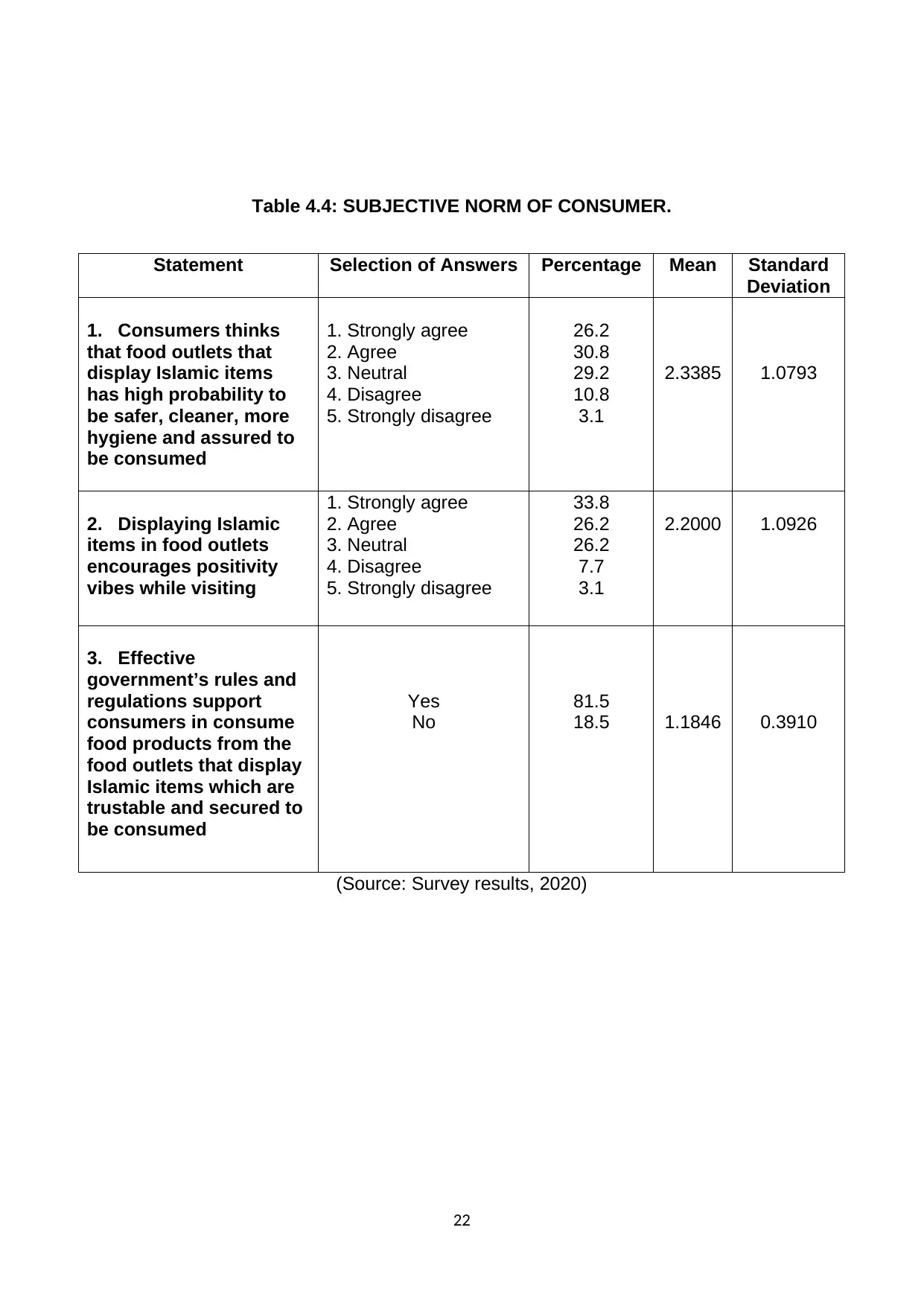
Table 4.4: SUBJECTIVE NORM OF CONSUMER.
Statement Selection of Answers Percentage Mean Standard
Deviation
1. Consumers thinks
that food outlets that
display Islamic items
has high probability to
be safer, cleaner, more
hygiene and assured to
be consumed
1. Strongly agree
2. Agree
3. Neutral
4. Disagree
5. Strongly disagree
26.2
30.8
29.2
10.8
3.1
2.3385 1.0793
2. Displaying Islamic
items in food outlets
encourages positivity
vibes while visiting
1. Strongly agree
2. Agree
3. Neutral
4. Disagree
5. Strongly disagree
33.8
26.2
26.2
7.7
3.1
2.2000 1.0926
3. Effective
government’s rules and
regulations support
consumers in consume
food products from the
food outlets that display
Islamic items which are
trustable and secured to
be consumed
Yes
No
81.5
18.5 1.1846 0.3910
(Source: Survey results, 2020)
22
Statement Selection of Answers Percentage Mean Standard
Deviation
1. Consumers thinks
that food outlets that
display Islamic items
has high probability to
be safer, cleaner, more
hygiene and assured to
be consumed
1. Strongly agree
2. Agree
3. Neutral
4. Disagree
5. Strongly disagree
26.2
30.8
29.2
10.8
3.1
2.3385 1.0793
2. Displaying Islamic
items in food outlets
encourages positivity
vibes while visiting
1. Strongly agree
2. Agree
3. Neutral
4. Disagree
5. Strongly disagree
33.8
26.2
26.2
7.7
3.1
2.2000 1.0926
3. Effective
government’s rules and
regulations support
consumers in consume
food products from the
food outlets that display
Islamic items which are
trustable and secured to
be consumed
Yes
No
81.5
18.5 1.1846 0.3910
(Source: Survey results, 2020)
22
Secure Best Marks with AI Grader
Need help grading? Try our AI Grader for instant feedback on your assignments.
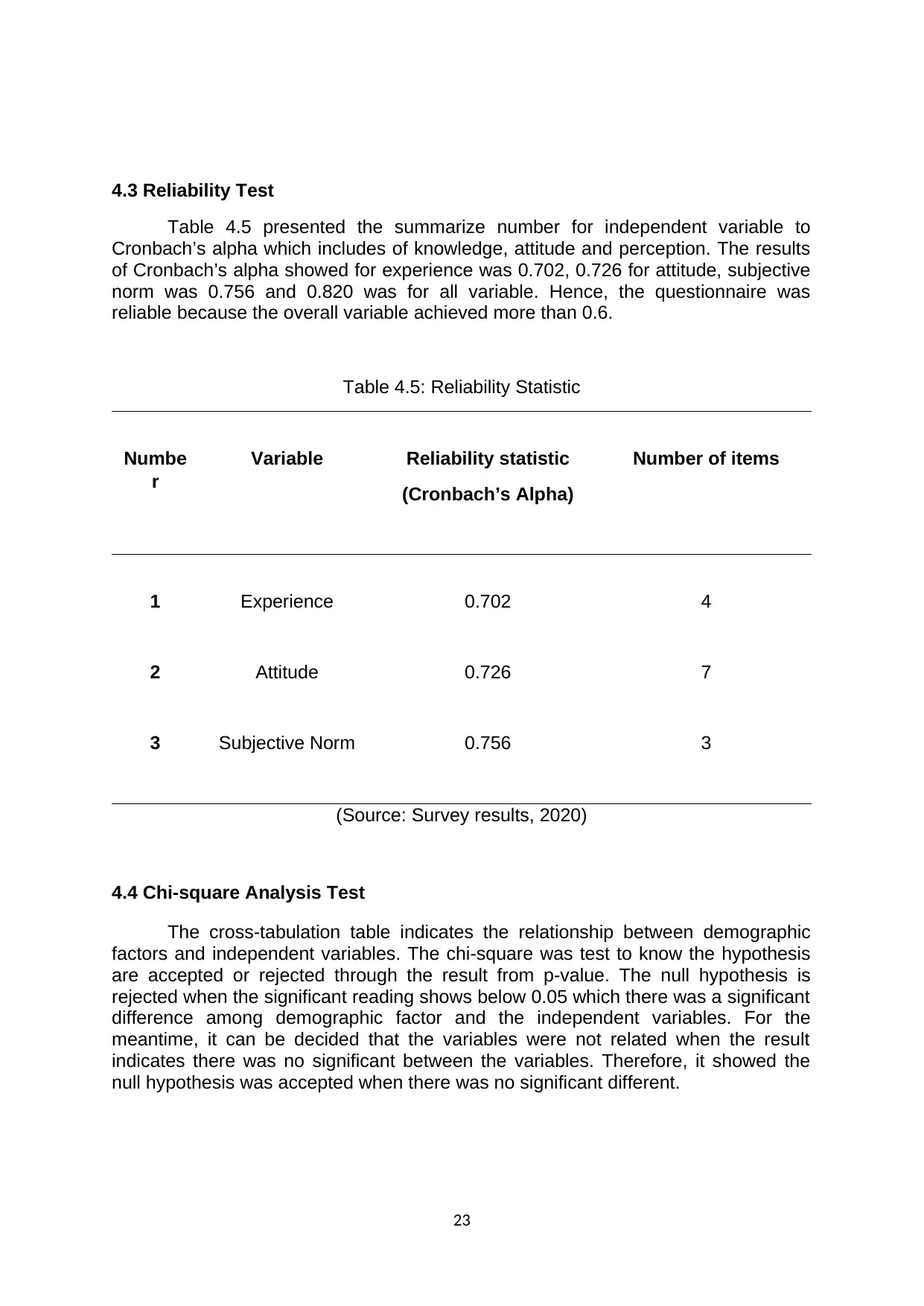
4.3 Reliability Test
Table 4.5 presented the summarize number for independent variable to
Cronbach’s alpha which includes of knowledge, attitude and perception. The results
of Cronbach’s alpha showed for experience was 0.702, 0.726 for attitude, subjective
norm was 0.756 and 0.820 was for all variable. Hence, the questionnaire was
reliable because the overall variable achieved more than 0.6.
Table 4.5: Reliability Statistic
Numbe
r
Variable Reliability statistic
(Cronbach’s Alpha)
Number of items
1 Experience 0.702 4
2 Attitude 0.726 7
3 Subjective Norm 0.756 3
(Source: Survey results, 2020)
4.4 Chi-square Analysis Test
The cross-tabulation table indicates the relationship between demographic
factors and independent variables. The chi-square was test to know the hypothesis
are accepted or rejected through the result from p-value. The null hypothesis is
rejected when the significant reading shows below 0.05 which there was a significant
difference among demographic factor and the independent variables. For the
meantime, it can be decided that the variables were not related when the result
indicates there was no significant between the variables. Therefore, it showed the
null hypothesis was accepted when there was no significant different.
23
Table 4.5 presented the summarize number for independent variable to
Cronbach’s alpha which includes of knowledge, attitude and perception. The results
of Cronbach’s alpha showed for experience was 0.702, 0.726 for attitude, subjective
norm was 0.756 and 0.820 was for all variable. Hence, the questionnaire was
reliable because the overall variable achieved more than 0.6.
Table 4.5: Reliability Statistic
Numbe
r
Variable Reliability statistic
(Cronbach’s Alpha)
Number of items
1 Experience 0.702 4
2 Attitude 0.726 7
3 Subjective Norm 0.756 3
(Source: Survey results, 2020)
4.4 Chi-square Analysis Test
The cross-tabulation table indicates the relationship between demographic
factors and independent variables. The chi-square was test to know the hypothesis
are accepted or rejected through the result from p-value. The null hypothesis is
rejected when the significant reading shows below 0.05 which there was a significant
difference among demographic factor and the independent variables. For the
meantime, it can be decided that the variables were not related when the result
indicates there was no significant between the variables. Therefore, it showed the
null hypothesis was accepted when there was no significant different.
23

4.4.1 Demographic Factor and Consumer experience on visiting food
outlets
Table 4.6: Relationship between Demographic factors and Consumer experience on
visiting food outlets
Factors Chi-square degree of
freedom
significant decision
Gender 14.565 3 0.001 Reject Hₒ
Age 39.826 14 0.000 Reject Hₒ
Marital Status
Race
13.087
14.826
6
3
0.148
0.000
Reject Hₒ
Fail to reject Hₒ
Religion 20.525 14 0.043 Reject Hₒ
Level of Education 15.156 7 0.028 Reject Hₒ
Occupation 40.525 15 0.000 Reject Hₒ
(Source: Survey results, 2020)
The above table 4.6 indicated the summarized value of chi-square
relationship between demographic factor and consumer experience on visiting food
outlets. The result showed that only race was a demographic factor which has no
significant different with consumer’s experience on visiting food outlets.
Based on result from cross-tabulation, female consumers (64.6%) and male
consumers (35.4%) were strongly agree that they had an experience on visit the
food outlets foods product. The most range age from 21 to 30 years old (73.8%) and
31 to 40 years old (16.9%) had strongly agreed on the experience plays a major role
in this.
In this section, the null hypothesis indicated no relationship between
demographic factor and consumer experience in visiting food outlets. Hence, only
race was failed to reject the null hypothesis presented in Table 4.6
24
outlets
Table 4.6: Relationship between Demographic factors and Consumer experience on
visiting food outlets
Factors Chi-square degree of
freedom
significant decision
Gender 14.565 3 0.001 Reject Hₒ
Age 39.826 14 0.000 Reject Hₒ
Marital Status
Race
13.087
14.826
6
3
0.148
0.000
Reject Hₒ
Fail to reject Hₒ
Religion 20.525 14 0.043 Reject Hₒ
Level of Education 15.156 7 0.028 Reject Hₒ
Occupation 40.525 15 0.000 Reject Hₒ
(Source: Survey results, 2020)
The above table 4.6 indicated the summarized value of chi-square
relationship between demographic factor and consumer experience on visiting food
outlets. The result showed that only race was a demographic factor which has no
significant different with consumer’s experience on visiting food outlets.
Based on result from cross-tabulation, female consumers (64.6%) and male
consumers (35.4%) were strongly agree that they had an experience on visit the
food outlets foods product. The most range age from 21 to 30 years old (73.8%) and
31 to 40 years old (16.9%) had strongly agreed on the experience plays a major role
in this.
In this section, the null hypothesis indicated no relationship between
demographic factor and consumer experience in visiting food outlets. Hence, only
race was failed to reject the null hypothesis presented in Table 4.6
24
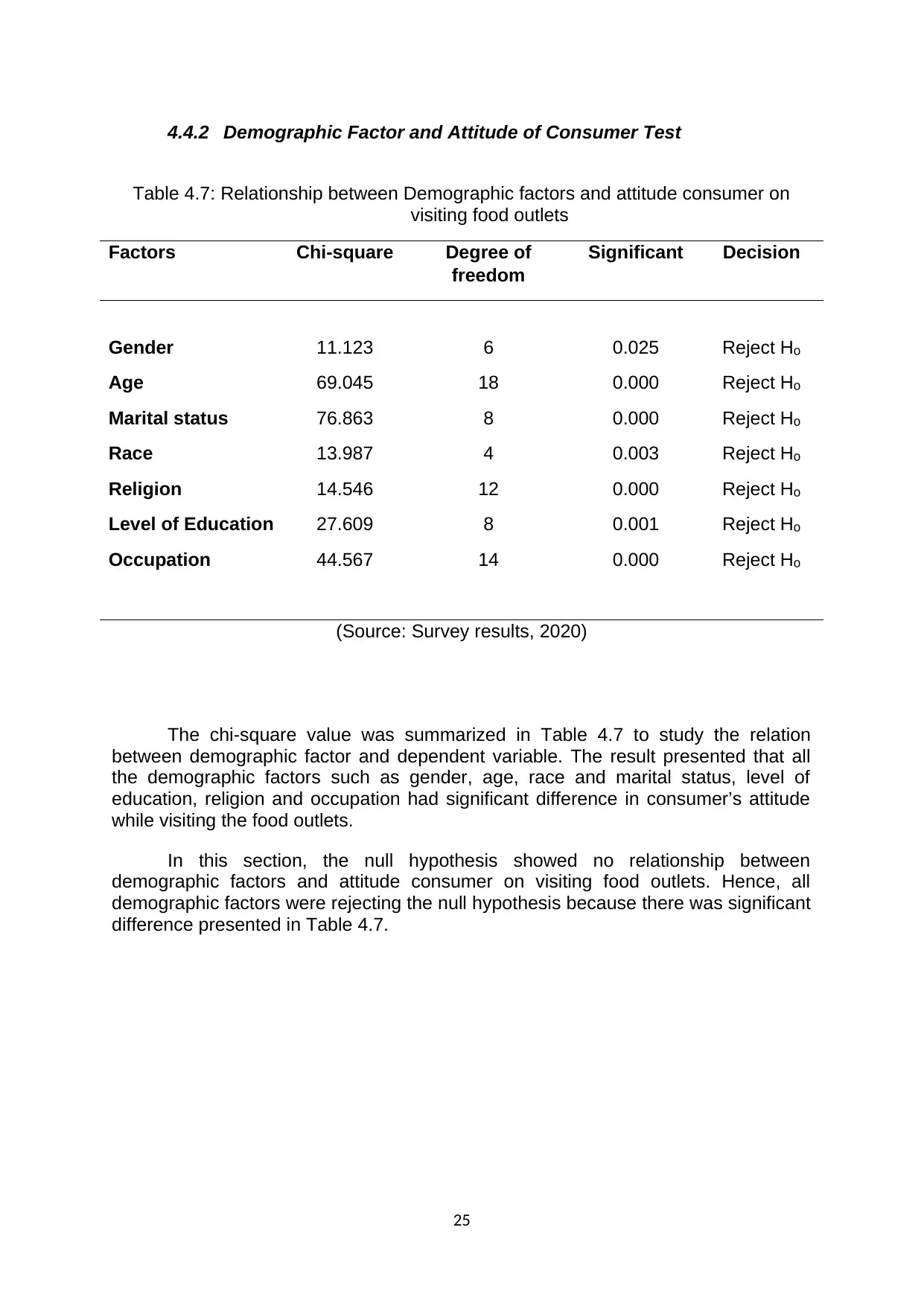
4.4.2 Demographic Factor and Attitude of Consumer Test
Table 4.7: Relationship between Demographic factors and attitude consumer on
visiting food outlets
Factors Chi-square Degree of
freedom
Significant Decision
Gender 11.123 6 0.025 Reject Hₒ
Age 69.045 18 0.000 Reject Hₒ
Marital status
Race
76.863
13.987
8
4
0.000
0.003
Reject Hₒ
Reject Hₒ
Religion 14.546 12 0.000 Reject Hₒ
Level of Education 27.609 8 0.001 Reject Hₒ
Occupation 44.567 14 0.000 Reject Hₒ
(Source: Survey results, 2020)
The chi-square value was summarized in Table 4.7 to study the relation
between demographic factor and dependent variable. The result presented that all
the demographic factors such as gender, age, race and marital status, level of
education, religion and occupation had significant difference in consumer’s attitude
while visiting the food outlets.
In this section, the null hypothesis showed no relationship between
demographic factors and attitude consumer on visiting food outlets. Hence, all
demographic factors were rejecting the null hypothesis because there was significant
difference presented in Table 4.7.
25
Table 4.7: Relationship between Demographic factors and attitude consumer on
visiting food outlets
Factors Chi-square Degree of
freedom
Significant Decision
Gender 11.123 6 0.025 Reject Hₒ
Age 69.045 18 0.000 Reject Hₒ
Marital status
Race
76.863
13.987
8
4
0.000
0.003
Reject Hₒ
Reject Hₒ
Religion 14.546 12 0.000 Reject Hₒ
Level of Education 27.609 8 0.001 Reject Hₒ
Occupation 44.567 14 0.000 Reject Hₒ
(Source: Survey results, 2020)
The chi-square value was summarized in Table 4.7 to study the relation
between demographic factor and dependent variable. The result presented that all
the demographic factors such as gender, age, race and marital status, level of
education, religion and occupation had significant difference in consumer’s attitude
while visiting the food outlets.
In this section, the null hypothesis showed no relationship between
demographic factors and attitude consumer on visiting food outlets. Hence, all
demographic factors were rejecting the null hypothesis because there was significant
difference presented in Table 4.7.
25
Paraphrase This Document
Need a fresh take? Get an instant paraphrase of this document with our AI Paraphraser
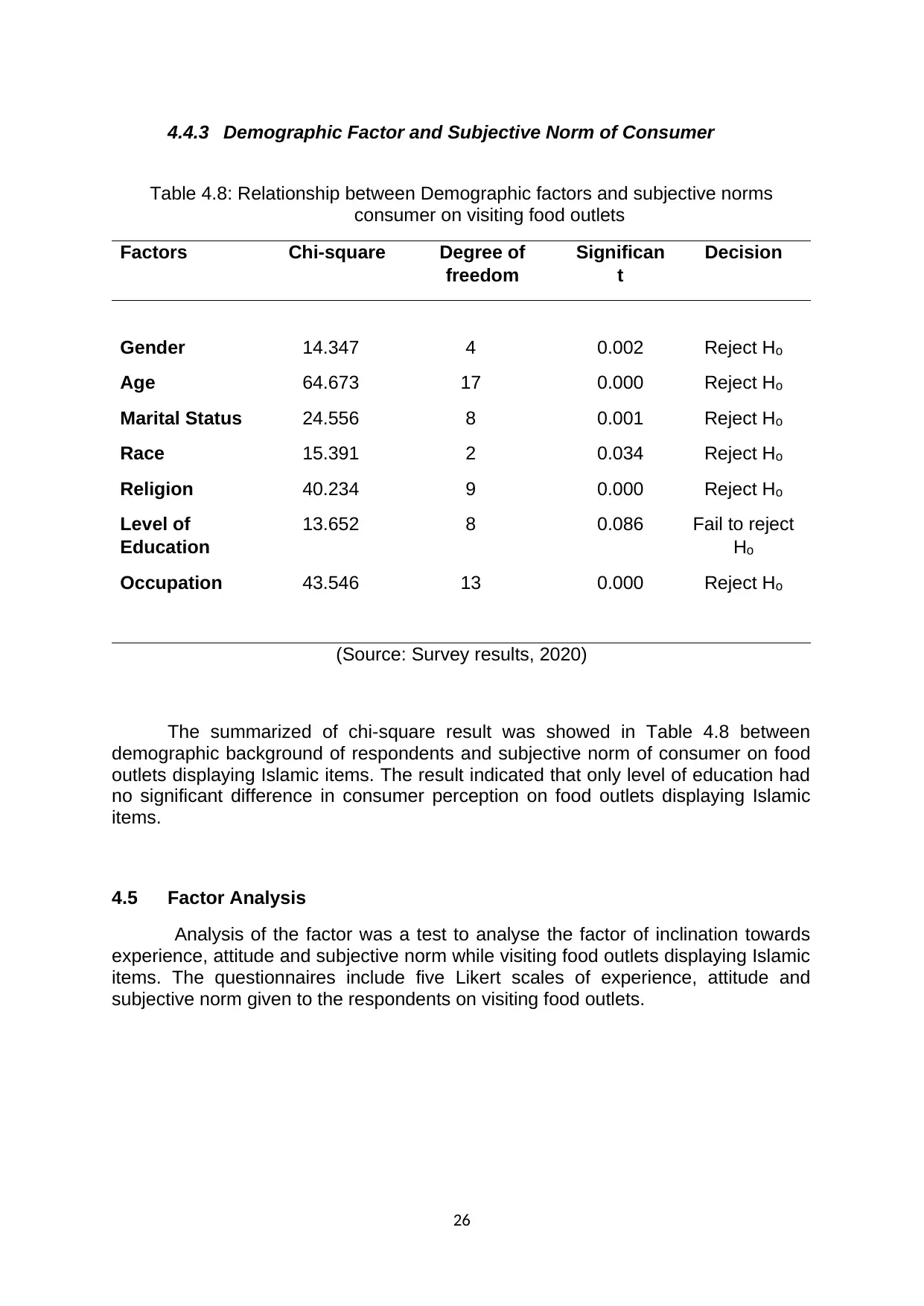
4.4.3 Demographic Factor and Subjective Norm of Consumer
Table 4.8: Relationship between Demographic factors and subjective norms
consumer on visiting food outlets
Factors Chi-square Degree of
freedom
Significan
t
Decision
Gender 14.347 4 0.002 Reject Hₒ
Age 64.673 17 0.000 Reject Hₒ
Marital Status
Race
24.556
15.391
8
2
0.001
0.034
Reject Hₒ
Reject Hₒ
Religion 40.234 9 0.000 Reject Hₒ
Level of
Education
13.652 8 0.086 Fail to reject
Hₒ
Occupation 43.546 13 0.000 Reject Hₒ
(Source: Survey results, 2020)
The summarized of chi-square result was showed in Table 4.8 between
demographic background of respondents and subjective norm of consumer on food
outlets displaying Islamic items. The result indicated that only level of education had
no significant difference in consumer perception on food outlets displaying Islamic
items.
4.5 Factor Analysis
Analysis of the factor was a test to analyse the factor of inclination towards
experience, attitude and subjective norm while visiting food outlets displaying Islamic
items. The questionnaires include five Likert scales of experience, attitude and
subjective norm given to the respondents on visiting food outlets.
26
Table 4.8: Relationship between Demographic factors and subjective norms
consumer on visiting food outlets
Factors Chi-square Degree of
freedom
Significan
t
Decision
Gender 14.347 4 0.002 Reject Hₒ
Age 64.673 17 0.000 Reject Hₒ
Marital Status
Race
24.556
15.391
8
2
0.001
0.034
Reject Hₒ
Reject Hₒ
Religion 40.234 9 0.000 Reject Hₒ
Level of
Education
13.652 8 0.086 Fail to reject
Hₒ
Occupation 43.546 13 0.000 Reject Hₒ
(Source: Survey results, 2020)
The summarized of chi-square result was showed in Table 4.8 between
demographic background of respondents and subjective norm of consumer on food
outlets displaying Islamic items. The result indicated that only level of education had
no significant difference in consumer perception on food outlets displaying Islamic
items.
4.5 Factor Analysis
Analysis of the factor was a test to analyse the factor of inclination towards
experience, attitude and subjective norm while visiting food outlets displaying Islamic
items. The questionnaires include five Likert scales of experience, attitude and
subjective norm given to the respondents on visiting food outlets.
26
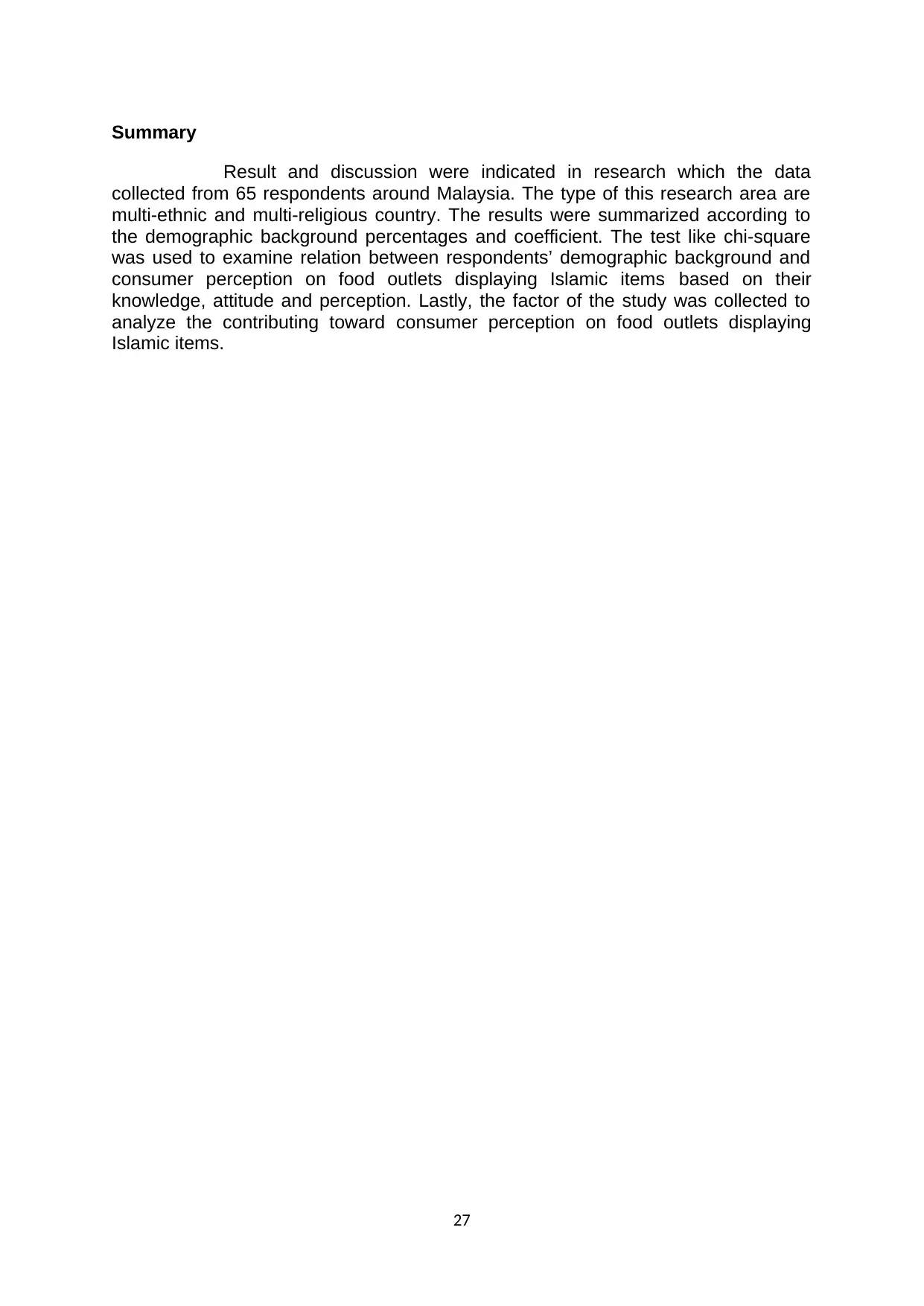
Summary
Result and discussion were indicated in research which the data
collected from 65 respondents around Malaysia. The type of this research area are
multi-ethnic and multi-religious country. The results were summarized according to
the demographic background percentages and coefficient. The test like chi-square
was used to examine relation between respondents’ demographic background and
consumer perception on food outlets displaying Islamic items based on their
knowledge, attitude and perception. Lastly, the factor of the study was collected to
analyze the contributing toward consumer perception on food outlets displaying
Islamic items.
27
Result and discussion were indicated in research which the data
collected from 65 respondents around Malaysia. The type of this research area are
multi-ethnic and multi-religious country. The results were summarized according to
the demographic background percentages and coefficient. The test like chi-square
was used to examine relation between respondents’ demographic background and
consumer perception on food outlets displaying Islamic items based on their
knowledge, attitude and perception. Lastly, the factor of the study was collected to
analyze the contributing toward consumer perception on food outlets displaying
Islamic items.
27
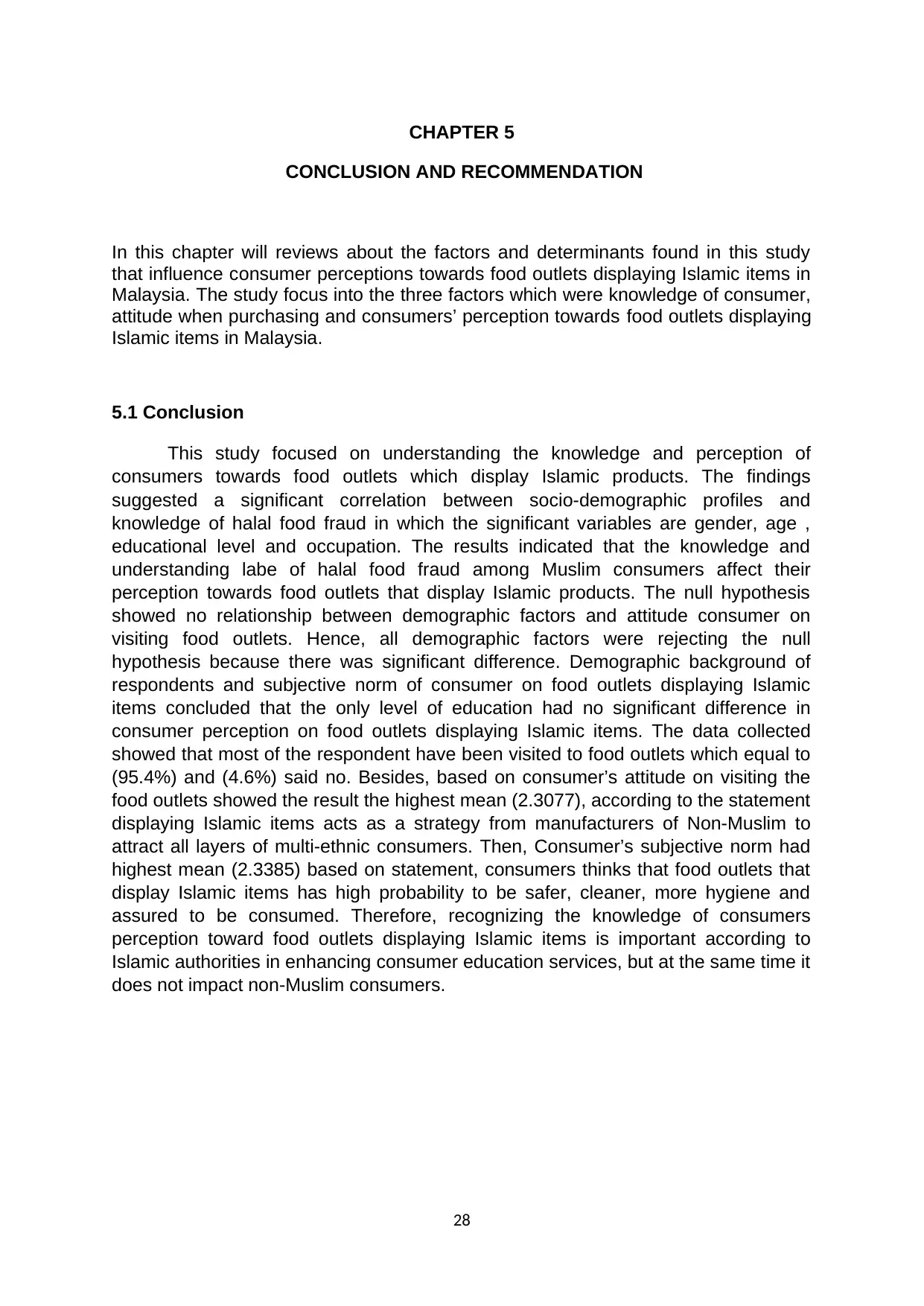
CHAPTER 5
CONCLUSION AND RECOMMENDATION
In this chapter will reviews about the factors and determinants found in this study
that influence consumer perceptions towards food outlets displaying Islamic items in
Malaysia. The study focus into the three factors which were knowledge of consumer,
attitude when purchasing and consumers’ perception towards food outlets displaying
Islamic items in Malaysia.
5.1 Conclusion
This study focused on understanding the knowledge and perception of
consumers towards food outlets which display Islamic products. The findings
suggested a significant correlation between socio-demographic profiles and
knowledge of halal food fraud in which the significant variables are gender, age ,
educational level and occupation. The results indicated that the knowledge and
understanding labe of halal food fraud among Muslim consumers affect their
perception towards food outlets that display Islamic products. The null hypothesis
showed no relationship between demographic factors and attitude consumer on
visiting food outlets. Hence, all demographic factors were rejecting the null
hypothesis because there was significant difference. Demographic background of
respondents and subjective norm of consumer on food outlets displaying Islamic
items concluded that the only level of education had no significant difference in
consumer perception on food outlets displaying Islamic items. The data collected
showed that most of the respondent have been visited to food outlets which equal to
(95.4%) and (4.6%) said no. Besides, based on consumer’s attitude on visiting the
food outlets showed the result the highest mean (2.3077), according to the statement
displaying Islamic items acts as a strategy from manufacturers of Non-Muslim to
attract all layers of multi-ethnic consumers. Then, Consumer’s subjective norm had
highest mean (2.3385) based on statement, consumers thinks that food outlets that
display Islamic items has high probability to be safer, cleaner, more hygiene and
assured to be consumed. Therefore, recognizing the knowledge of consumers
perception toward food outlets displaying Islamic items is important according to
Islamic authorities in enhancing consumer education services, but at the same time it
does not impact non-Muslim consumers.
28
CONCLUSION AND RECOMMENDATION
In this chapter will reviews about the factors and determinants found in this study
that influence consumer perceptions towards food outlets displaying Islamic items in
Malaysia. The study focus into the three factors which were knowledge of consumer,
attitude when purchasing and consumers’ perception towards food outlets displaying
Islamic items in Malaysia.
5.1 Conclusion
This study focused on understanding the knowledge and perception of
consumers towards food outlets which display Islamic products. The findings
suggested a significant correlation between socio-demographic profiles and
knowledge of halal food fraud in which the significant variables are gender, age ,
educational level and occupation. The results indicated that the knowledge and
understanding labe of halal food fraud among Muslim consumers affect their
perception towards food outlets that display Islamic products. The null hypothesis
showed no relationship between demographic factors and attitude consumer on
visiting food outlets. Hence, all demographic factors were rejecting the null
hypothesis because there was significant difference. Demographic background of
respondents and subjective norm of consumer on food outlets displaying Islamic
items concluded that the only level of education had no significant difference in
consumer perception on food outlets displaying Islamic items. The data collected
showed that most of the respondent have been visited to food outlets which equal to
(95.4%) and (4.6%) said no. Besides, based on consumer’s attitude on visiting the
food outlets showed the result the highest mean (2.3077), according to the statement
displaying Islamic items acts as a strategy from manufacturers of Non-Muslim to
attract all layers of multi-ethnic consumers. Then, Consumer’s subjective norm had
highest mean (2.3385) based on statement, consumers thinks that food outlets that
display Islamic items has high probability to be safer, cleaner, more hygiene and
assured to be consumed. Therefore, recognizing the knowledge of consumers
perception toward food outlets displaying Islamic items is important according to
Islamic authorities in enhancing consumer education services, but at the same time it
does not impact non-Muslim consumers.
28
Secure Best Marks with AI Grader
Need help grading? Try our AI Grader for instant feedback on your assignments.
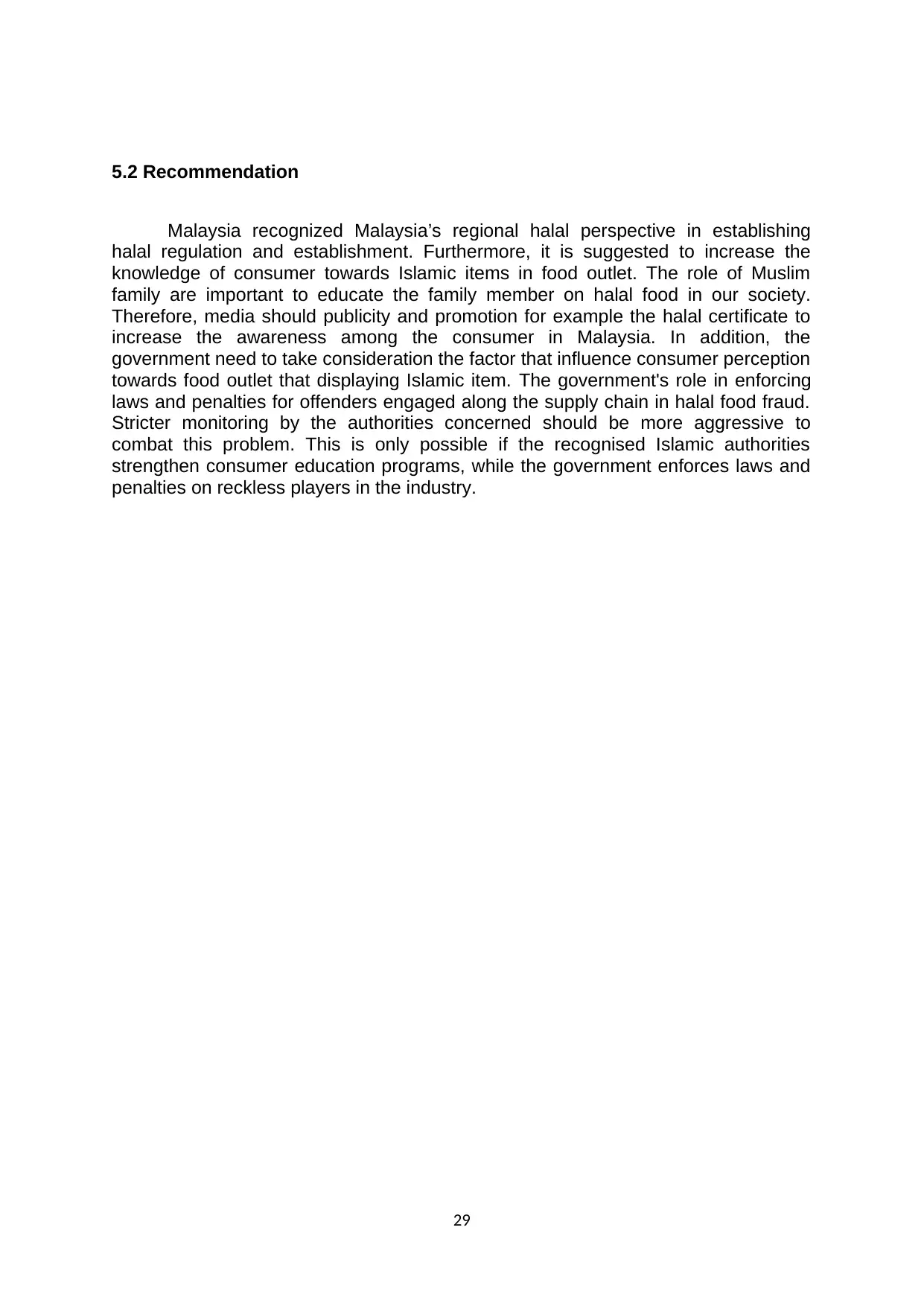
5.2 Recommendation
Malaysia recognized Malaysia’s regional halal perspective in establishing
halal regulation and establishment. Furthermore, it is suggested to increase the
knowledge of consumer towards Islamic items in food outlet. The role of Muslim
family are important to educate the family member on halal food in our society.
Therefore, media should publicity and promotion for example the halal certificate to
increase the awareness among the consumer in Malaysia. In addition, the
government need to take consideration the factor that influence consumer perception
towards food outlet that displaying Islamic item. The government's role in enforcing
laws and penalties for offenders engaged along the supply chain in halal food fraud.
Stricter monitoring by the authorities concerned should be more aggressive to
combat this problem. This is only possible if the recognised Islamic authorities
strengthen consumer education programs, while the government enforces laws and
penalties on reckless players in the industry.
29
Malaysia recognized Malaysia’s regional halal perspective in establishing
halal regulation and establishment. Furthermore, it is suggested to increase the
knowledge of consumer towards Islamic items in food outlet. The role of Muslim
family are important to educate the family member on halal food in our society.
Therefore, media should publicity and promotion for example the halal certificate to
increase the awareness among the consumer in Malaysia. In addition, the
government need to take consideration the factor that influence consumer perception
towards food outlet that displaying Islamic item. The government's role in enforcing
laws and penalties for offenders engaged along the supply chain in halal food fraud.
Stricter monitoring by the authorities concerned should be more aggressive to
combat this problem. This is only possible if the recognised Islamic authorities
strengthen consumer education programs, while the government enforces laws and
penalties on reckless players in the industry.
29

References
Amat, M. B., Asshari, N. B., & Sundram, V. P. (2015). The Influence of Muslim
Consumer's Perception toward Halal Food Product on Attitude at Retail Stores.
SSRN Electronic Journal. doi:10.2139/ssrn.2541203
Aziz, M. A., Bakar, M. F., Zaaba, M. K., & Hassan, F. (2019). The Influence of
Theory of Planned Behavior, Religion and Halal Certification on Consumers’
Purchase Intention of Halal Food at Restaurant in Subang Jaya. Contemporary
Management and Science Issues in the Halal Industry, 53-63. Doi:
10.1007/978-981-13-2677-6_5
Aziz, S. A., Mohamed, R. N., & Rahman, S. A. (2017). Unscrambling Determinants
of Islamic Retail Experiential Value (IREV) at Indian Muslim Food Retail
Outlets: A Focus Group Analysis, 1-12. Retrieved June 1, 2020.
Abdul, M., Yahya, M., Kamarulzaman, S. A., & Rahman, M. M. (2016, October).
(PDF) The Perception of Malaysian Consumers on the Importance of Halal
Logo in Their Purchasing Decision. Retrieved June 1, 2020, from
https://www.researchgate.net/publication/309462690_The_Perception_of_Mala
ysian_Consumers_on_the_Importance_of_Halal_Logo_in_Their_Purchasing_D
ecision
Ahlam, N.A., Azmawani, A.R and Suhaimi, A.R. (2015), “Assessing knowledge and
religiosity on consumer behavior towards halal food and cosmetic products”,
International Journal of Social Science and Humanity, Vol.5 No.1, p. 413.
Basri, Y. Z., & Kurniawati, F. (2019). Effect of Religiosity and Halal Awareness on
Purchase Intention Moderated by Halal Certification. KnE Social Sciences.
doi:10.18502/kss.v3i26.5403Khan, M. A., Riaz, M. N., & Chaudry, M. M. (2018).
Muslim Demography and Global Halal Trade A Statistical Overview. Handbook
of Halal Food Production, 29-60. Doi: 10.1201/9781315119564-4
Ishak, S., Awang, A.H., Hussain, M.Y., Zaimah, R., Sarmila, M.S., Saad, S. & Azima,
A.M. (2016). A study on the mediating role of halal perception: Determinants
and consequence reflections. Journal of Islamic Marketing, 7(3), 288-302.
I-Chant A. Chiang, PaulC. Price, Rajiv & Jhangiani (2016), "Reliability and Validity of
Measurement", the International Journal of Pyschology.
Koshki, N., Esmaeilpour, H., & Ardestani, A. S. (2018). The Study on the Effects of
Environmental quality , Food and Restaurant Services on Mental Image of the
Restaurant , Customer Perceived Value , Customer Satisfaction and Customer
Behavioral intentions : Case Study of Boroujerd's Restaurants. Kuwait Chapter
of Arabian Journal of Business and Management Review, 3(10), 261-272. Doi:
10.12816/0018407
30
Amat, M. B., Asshari, N. B., & Sundram, V. P. (2015). The Influence of Muslim
Consumer's Perception toward Halal Food Product on Attitude at Retail Stores.
SSRN Electronic Journal. doi:10.2139/ssrn.2541203
Aziz, M. A., Bakar, M. F., Zaaba, M. K., & Hassan, F. (2019). The Influence of
Theory of Planned Behavior, Religion and Halal Certification on Consumers’
Purchase Intention of Halal Food at Restaurant in Subang Jaya. Contemporary
Management and Science Issues in the Halal Industry, 53-63. Doi:
10.1007/978-981-13-2677-6_5
Aziz, S. A., Mohamed, R. N., & Rahman, S. A. (2017). Unscrambling Determinants
of Islamic Retail Experiential Value (IREV) at Indian Muslim Food Retail
Outlets: A Focus Group Analysis, 1-12. Retrieved June 1, 2020.
Abdul, M., Yahya, M., Kamarulzaman, S. A., & Rahman, M. M. (2016, October).
(PDF) The Perception of Malaysian Consumers on the Importance of Halal
Logo in Their Purchasing Decision. Retrieved June 1, 2020, from
https://www.researchgate.net/publication/309462690_The_Perception_of_Mala
ysian_Consumers_on_the_Importance_of_Halal_Logo_in_Their_Purchasing_D
ecision
Ahlam, N.A., Azmawani, A.R and Suhaimi, A.R. (2015), “Assessing knowledge and
religiosity on consumer behavior towards halal food and cosmetic products”,
International Journal of Social Science and Humanity, Vol.5 No.1, p. 413.
Basri, Y. Z., & Kurniawati, F. (2019). Effect of Religiosity and Halal Awareness on
Purchase Intention Moderated by Halal Certification. KnE Social Sciences.
doi:10.18502/kss.v3i26.5403Khan, M. A., Riaz, M. N., & Chaudry, M. M. (2018).
Muslim Demography and Global Halal Trade A Statistical Overview. Handbook
of Halal Food Production, 29-60. Doi: 10.1201/9781315119564-4
Ishak, S., Awang, A.H., Hussain, M.Y., Zaimah, R., Sarmila, M.S., Saad, S. & Azima,
A.M. (2016). A study on the mediating role of halal perception: Determinants
and consequence reflections. Journal of Islamic Marketing, 7(3), 288-302.
I-Chant A. Chiang, PaulC. Price, Rajiv & Jhangiani (2016), "Reliability and Validity of
Measurement", the International Journal of Pyschology.
Koshki, N., Esmaeilpour, H., & Ardestani, A. S. (2018). The Study on the Effects of
Environmental quality , Food and Restaurant Services on Mental Image of the
Restaurant , Customer Perceived Value , Customer Satisfaction and Customer
Behavioral intentions : Case Study of Boroujerd's Restaurants. Kuwait Chapter
of Arabian Journal of Business and Management Review, 3(10), 261-272. Doi:
10.12816/0018407
30
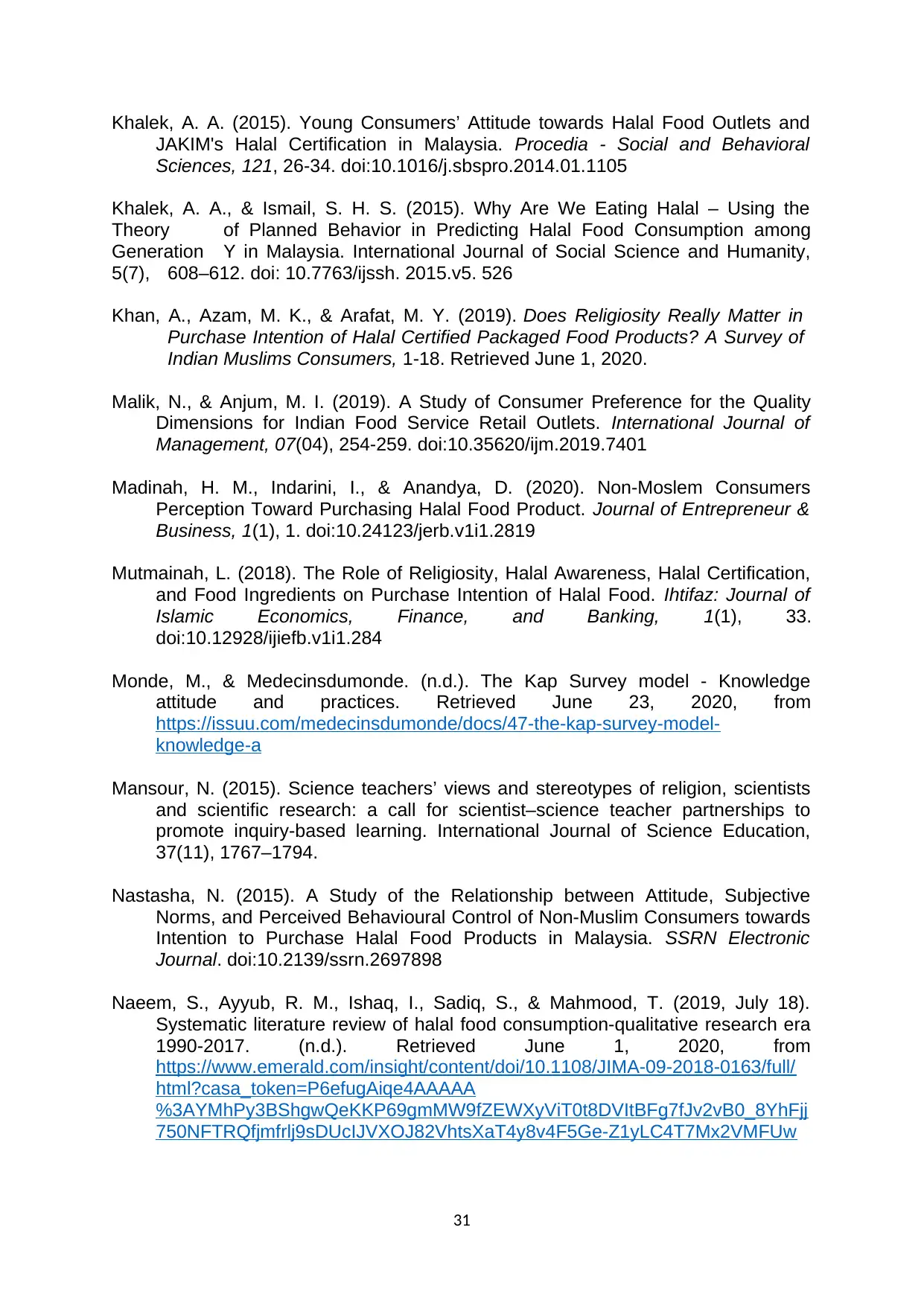
Khalek, A. A. (2015). Young Consumers’ Attitude towards Halal Food Outlets and
JAKIM's Halal Certification in Malaysia. Procedia - Social and Behavioral
Sciences, 121, 26-34. doi:10.1016/j.sbspro.2014.01.1105
Khalek, A. A., & Ismail, S. H. S. (2015). Why Are We Eating Halal – Using the
Theory of Planned Behavior in Predicting Halal Food Consumption among
Generation Y in Malaysia. International Journal of Social Science and Humanity,
5(7), 608–612. doi: 10.7763/ijssh. 2015.v5. 526
Khan, A., Azam, M. K., & Arafat, M. Y. (2019). Does Religiosity Really Matter in
Purchase Intention of Halal Certified Packaged Food Products? A Survey of
Indian Muslims Consumers, 1-18. Retrieved June 1, 2020.
Malik, N., & Anjum, M. I. (2019). A Study of Consumer Preference for the Quality
Dimensions for Indian Food Service Retail Outlets. International Journal of
Management, 07(04), 254-259. doi:10.35620/ijm.2019.7401
Madinah, H. M., Indarini, I., & Anandya, D. (2020). Non-Moslem Consumers
Perception Toward Purchasing Halal Food Product. Journal of Entrepreneur &
Business, 1(1), 1. doi:10.24123/jerb.v1i1.2819
Mutmainah, L. (2018). The Role of Religiosity, Halal Awareness, Halal Certification,
and Food Ingredients on Purchase Intention of Halal Food. Ihtifaz: Journal of
Islamic Economics, Finance, and Banking, 1(1), 33.
doi:10.12928/ijiefb.v1i1.284
Monde, M., & Medecinsdumonde. (n.d.). The Kap Survey model - Knowledge
attitude and practices. Retrieved June 23, 2020, from
https://issuu.com/medecinsdumonde/docs/47-the-kap-survey-model-
knowledge-a
Mansour, N. (2015). Science teachers’ views and stereotypes of religion, scientists
and scientific research: a call for scientist–science teacher partnerships to
promote inquiry-based learning. International Journal of Science Education,
37(11), 1767–1794.
Nastasha, N. (2015). A Study of the Relationship between Attitude, Subjective
Norms, and Perceived Behavioural Control of Non-Muslim Consumers towards
Intention to Purchase Halal Food Products in Malaysia. SSRN Electronic
Journal. doi:10.2139/ssrn.2697898
Naeem, S., Ayyub, R. M., Ishaq, I., Sadiq, S., & Mahmood, T. (2019, July 18).
Systematic literature review of halal food consumption-qualitative research era
1990-2017. (n.d.). Retrieved June 1, 2020, from
https://www.emerald.com/insight/content/doi/10.1108/JIMA-09-2018-0163/full/
html?casa_token=P6efugAiqe4AAAAA
%3AYMhPy3BShgwQeKKP69gmMW9fZEWXyViT0t8DVItBFg7fJv2vB0_8YhFjj
750NFTRQfjmfrlj9sDUcIJVXOJ82VhtsXaT4y8v4F5Ge-Z1yLC4T7Mx2VMFUw
31
JAKIM's Halal Certification in Malaysia. Procedia - Social and Behavioral
Sciences, 121, 26-34. doi:10.1016/j.sbspro.2014.01.1105
Khalek, A. A., & Ismail, S. H. S. (2015). Why Are We Eating Halal – Using the
Theory of Planned Behavior in Predicting Halal Food Consumption among
Generation Y in Malaysia. International Journal of Social Science and Humanity,
5(7), 608–612. doi: 10.7763/ijssh. 2015.v5. 526
Khan, A., Azam, M. K., & Arafat, M. Y. (2019). Does Religiosity Really Matter in
Purchase Intention of Halal Certified Packaged Food Products? A Survey of
Indian Muslims Consumers, 1-18. Retrieved June 1, 2020.
Malik, N., & Anjum, M. I. (2019). A Study of Consumer Preference for the Quality
Dimensions for Indian Food Service Retail Outlets. International Journal of
Management, 07(04), 254-259. doi:10.35620/ijm.2019.7401
Madinah, H. M., Indarini, I., & Anandya, D. (2020). Non-Moslem Consumers
Perception Toward Purchasing Halal Food Product. Journal of Entrepreneur &
Business, 1(1), 1. doi:10.24123/jerb.v1i1.2819
Mutmainah, L. (2018). The Role of Religiosity, Halal Awareness, Halal Certification,
and Food Ingredients on Purchase Intention of Halal Food. Ihtifaz: Journal of
Islamic Economics, Finance, and Banking, 1(1), 33.
doi:10.12928/ijiefb.v1i1.284
Monde, M., & Medecinsdumonde. (n.d.). The Kap Survey model - Knowledge
attitude and practices. Retrieved June 23, 2020, from
https://issuu.com/medecinsdumonde/docs/47-the-kap-survey-model-
knowledge-a
Mansour, N. (2015). Science teachers’ views and stereotypes of religion, scientists
and scientific research: a call for scientist–science teacher partnerships to
promote inquiry-based learning. International Journal of Science Education,
37(11), 1767–1794.
Nastasha, N. (2015). A Study of the Relationship between Attitude, Subjective
Norms, and Perceived Behavioural Control of Non-Muslim Consumers towards
Intention to Purchase Halal Food Products in Malaysia. SSRN Electronic
Journal. doi:10.2139/ssrn.2697898
Naeem, S., Ayyub, R. M., Ishaq, I., Sadiq, S., & Mahmood, T. (2019, July 18).
Systematic literature review of halal food consumption-qualitative research era
1990-2017. (n.d.). Retrieved June 1, 2020, from
https://www.emerald.com/insight/content/doi/10.1108/JIMA-09-2018-0163/full/
html?casa_token=P6efugAiqe4AAAAA
%3AYMhPy3BShgwQeKKP69gmMW9fZEWXyViT0t8DVItBFg7fJv2vB0_8YhFjj
750NFTRQfjmfrlj9sDUcIJVXOJ82VhtsXaT4y8v4F5Ge-Z1yLC4T7Mx2VMFUw
31
Paraphrase This Document
Need a fresh take? Get an instant paraphrase of this document with our AI Paraphraser

Rav-Marathe, K. T., Wan, T. T., & Marathe, S. T. (2016). A Systematic Review on
the Kap-o Framework for Diabetes Education and Research, 4(1), 1-21.
Retrieved June 1, 2020.
Rishi, B. (2015). Islamic Perspectives on Marketing and Consumer Behaviour.
Ghaziabad: IGI Global.
Si, H., Shi, J., Tang, D., Wen, S., Miao, W., & Duan, K. (2019). Application of the
Theory of Planned Behavior in Environmental Science: A Comprehensive
Bibliometric Analysis. International Journal of Environmental Research and
Public Health, 16(15), 2788. Doi: 10.3390/ijerph16152788
Stephanie. (2016, February 26). Internal Consistency Reliability: Definition,
Examples. Retrieved June 22, 2020, from
https://www.statisticshowto.com/internal-consistency
Wang, R., Yang, Y., Chen, R., Kan, H., Wu, J., Wang, K., .. Lu, Y. (2015).
Knowledge, Attitudes, and Practices (KAP) of the Relationship between Air
Pollution and Children’s Respiratory Health in Shanghai, China. International
Journal of Environmental Research and Public Health, 12(2), 1834-1848. Doi:
10.3390/ijerph120201834
32
the Kap-o Framework for Diabetes Education and Research, 4(1), 1-21.
Retrieved June 1, 2020.
Rishi, B. (2015). Islamic Perspectives on Marketing and Consumer Behaviour.
Ghaziabad: IGI Global.
Si, H., Shi, J., Tang, D., Wen, S., Miao, W., & Duan, K. (2019). Application of the
Theory of Planned Behavior in Environmental Science: A Comprehensive
Bibliometric Analysis. International Journal of Environmental Research and
Public Health, 16(15), 2788. Doi: 10.3390/ijerph16152788
Stephanie. (2016, February 26). Internal Consistency Reliability: Definition,
Examples. Retrieved June 22, 2020, from
https://www.statisticshowto.com/internal-consistency
Wang, R., Yang, Y., Chen, R., Kan, H., Wu, J., Wang, K., .. Lu, Y. (2015).
Knowledge, Attitudes, and Practices (KAP) of the Relationship between Air
Pollution and Children’s Respiratory Health in Shanghai, China. International
Journal of Environmental Research and Public Health, 12(2), 1834-1848. Doi:
10.3390/ijerph120201834
32
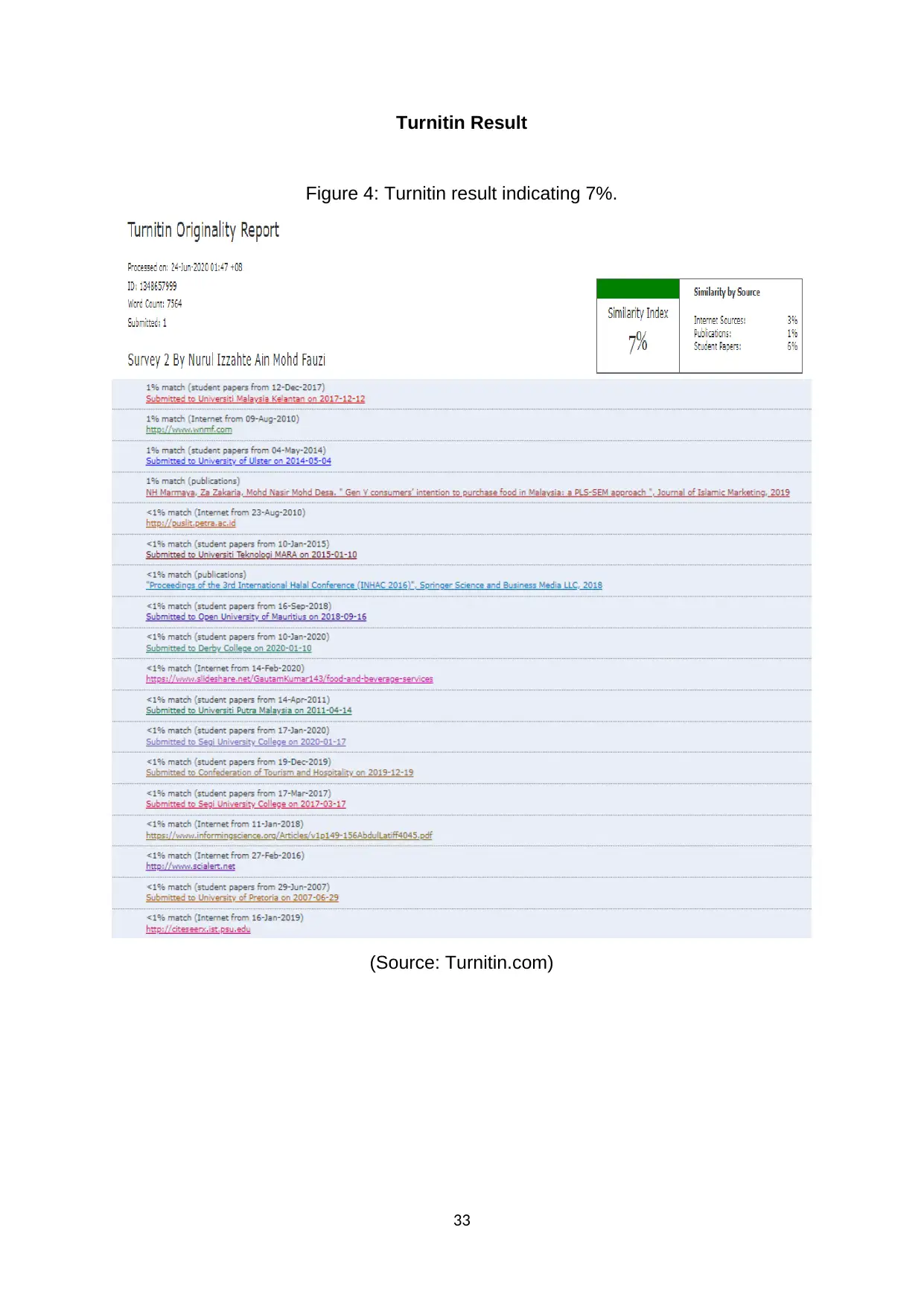
Turnitin Result
Figure 4: Turnitin result indicating 7%.
(Source: Turnitin.com)
33
Figure 4: Turnitin result indicating 7%.
(Source: Turnitin.com)
33
1 out of 39
Your All-in-One AI-Powered Toolkit for Academic Success.
+13062052269
info@desklib.com
Available 24*7 on WhatsApp / Email
![[object Object]](/_next/static/media/star-bottom.7253800d.svg)
Unlock your academic potential
© 2024 | Zucol Services PVT LTD | All rights reserved.

